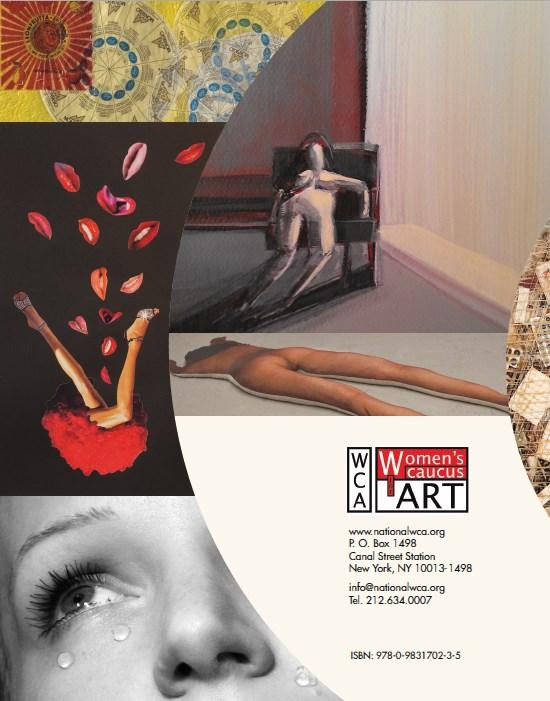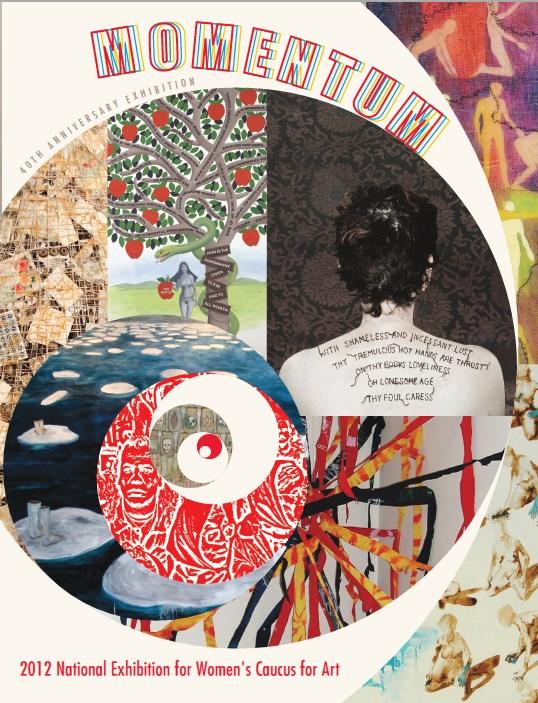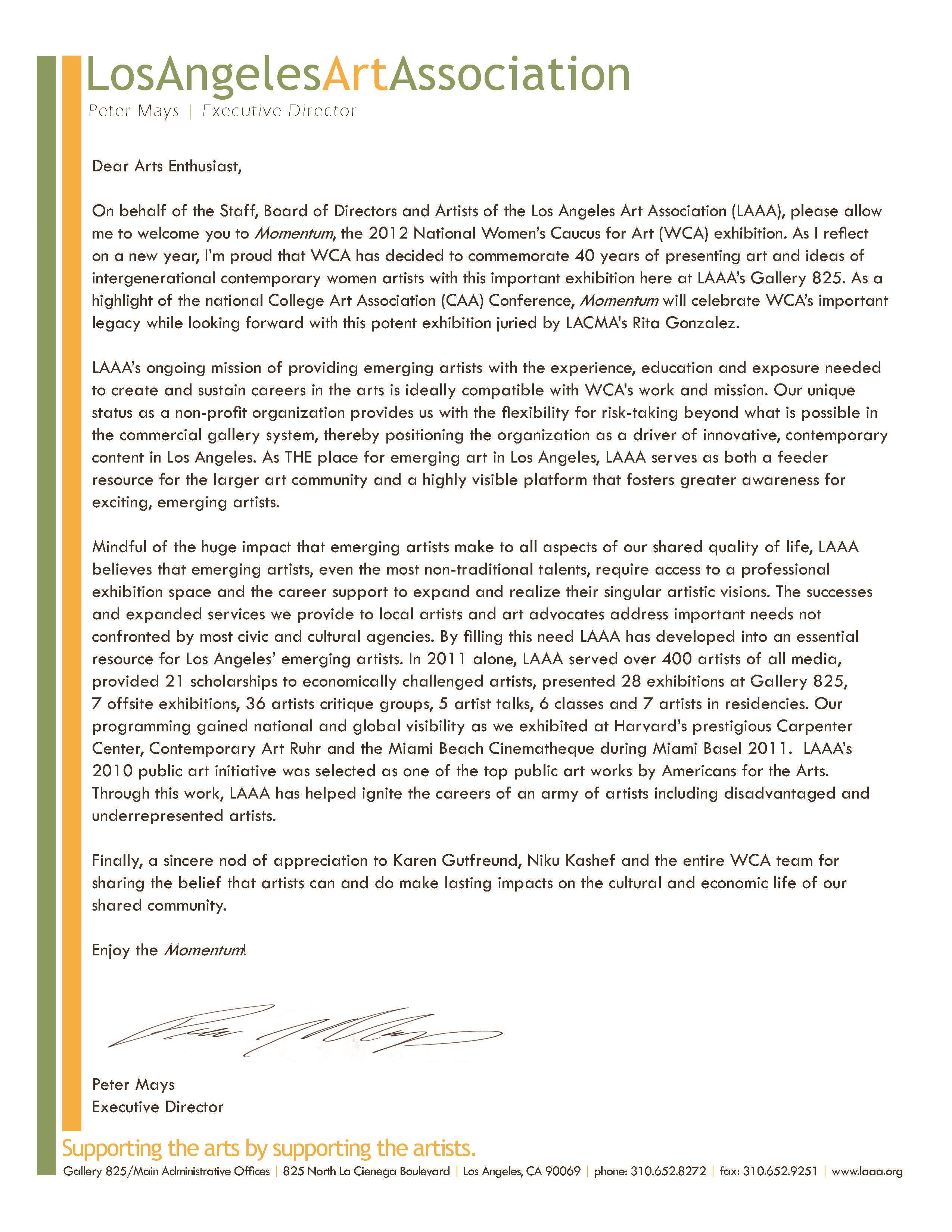MOMENTUM ARTISTS
* denotes artists exhibited at Los Angeles Art Association, Gallery 825
9
After having attained enough self-momentum to make more personal art, I tackled the following questions: How do I show my middle-aged woman’s feelings about becoming ‘invisible’ just as I’m breaking new personal ground? How do I look back at past choices to move towards what I want to achieve in future? I strove to ‘break the 4th wall’ by showing these explorations as a selfportrait, incorporating my Paper Doll symbol, a graphic metaphor for society’s expectations, constraints, and mandates to women.
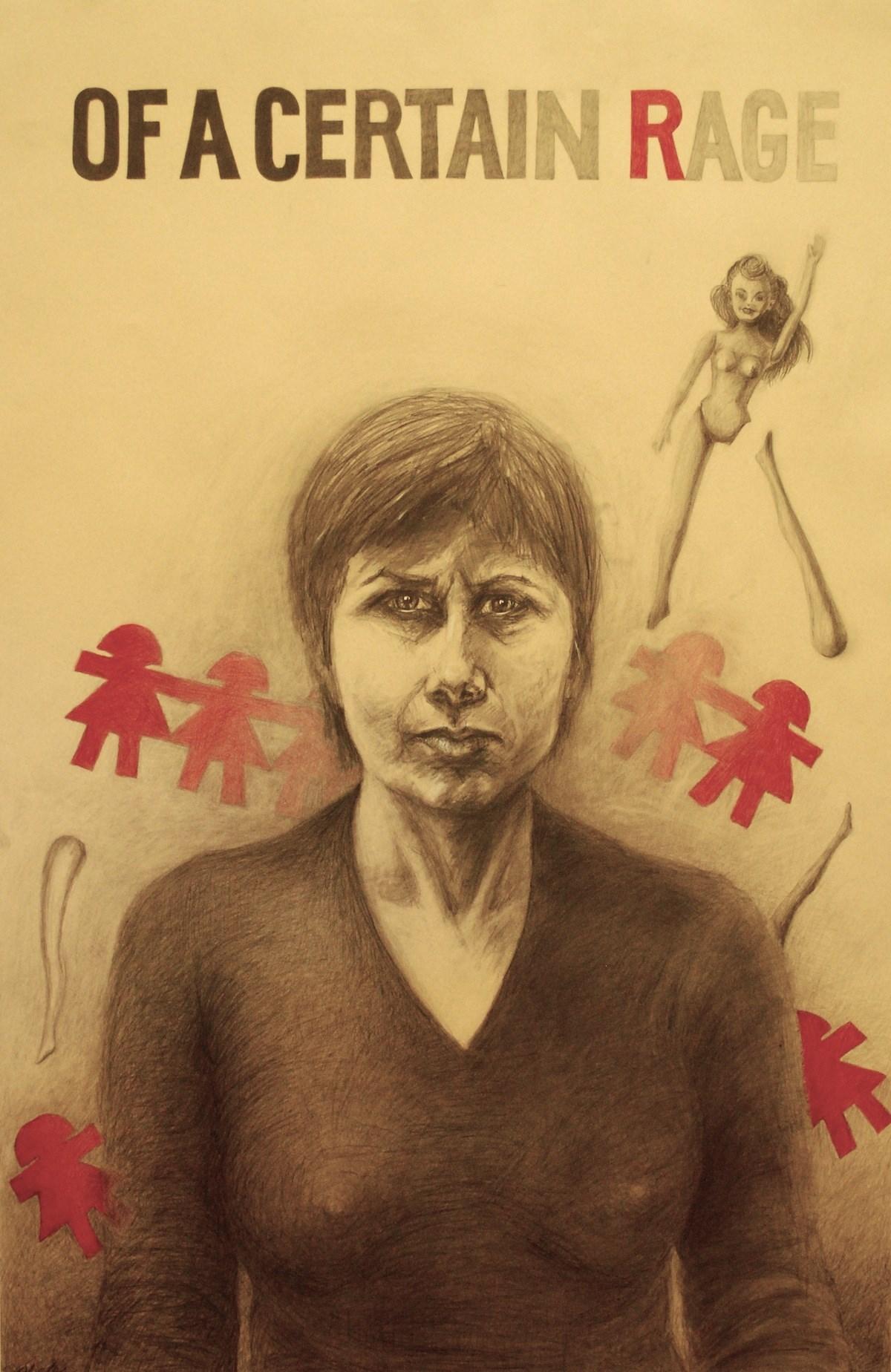
10
Nancy Abeles. Of a Certain R-Age. 2010. Graphite, colored pencil, white paint. 40 x 26 inches.
The recent works on paper developed from my observations and experiences of the awkward private moments; that then get turned into spectacle in public spaces. In some of the pieces, I have used the image of a blanket as an object that creates comfort, an intimate landscape, and a barrier between the public sphere and the inner self.

11
Robin Adsit. Small Piece of Turf. 2011. Oils and ink on paper. 51 x 70 inches. *
Robin Adsit. Between Painting and Drawing. 2011. Markers and oils on paper. 40 x 60 inches.
In the most recently completed painting, Between Painting and Drawing, I have placed a figure in a physical and conceptual space between painting and drawing; it explores both representational space and the space of the plane of the painting/drawing.

12
One after the other. I had only five weeks to make twenty-six paintings before leaving the country, to archive these young women into my visual lexicon. This was not the easiest task considering the temperature climbed to about one hundred thirty degrees in the classroom in which I was teaching. Nevertheless, persistent natures allowed each person to sit over an hour for a painting and for me to paint perpetually until I had journalized each and every single one, twice one painting with a hair cover and one without. This documented generation of women is the first in Diyarbakir, Turkey to not be housewives, like most of their mothers.

13
Zina Al-Shukri. Gushing With Confidence And Jealousy. 2011. Gouache, charcoal and metallic pigments on tinted paper. 30 x 22 inches. *
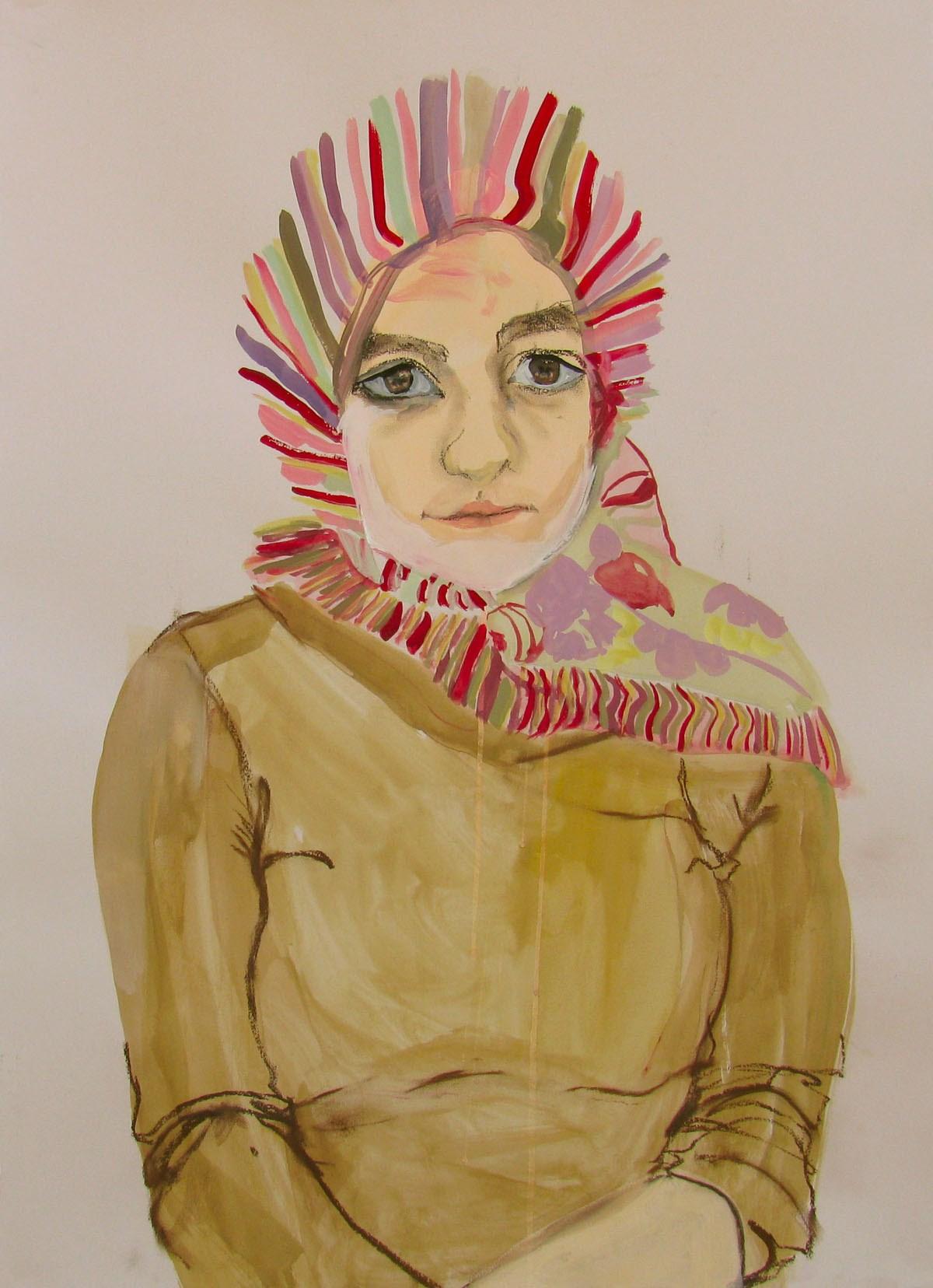
14
Zina Al-Shukri. Solid As Rock (Covered Version). 2011. Gouache and charcoal on tinted paper. 30 x 22 inches. *
Zina Al-Shukri. A Matter Of Life Or Education (Covered Version). 2011. Gouache, charcoal and metallic pigments on tinted paper. 30 x 22 inches.

15
Salma Arastu. Momentum-2. 2011. Paper, board and acrylic paint. 24 x 34 inches.
I have started this series Momentum: We have Arrived this year in response to the 40th year celebration of Women’s Caucus of the Arts in USA. My association with WCA does not go far back, yet I have felt this momentum personally as a woman artist. I have enjoyed celebrating life and diversity with a belief that we shall all rise together. In these paintings and drawings, through my lyrical lines, I am trying to capture the spirit of women from everywhere, rising together, contributing and creating a space for themselves.
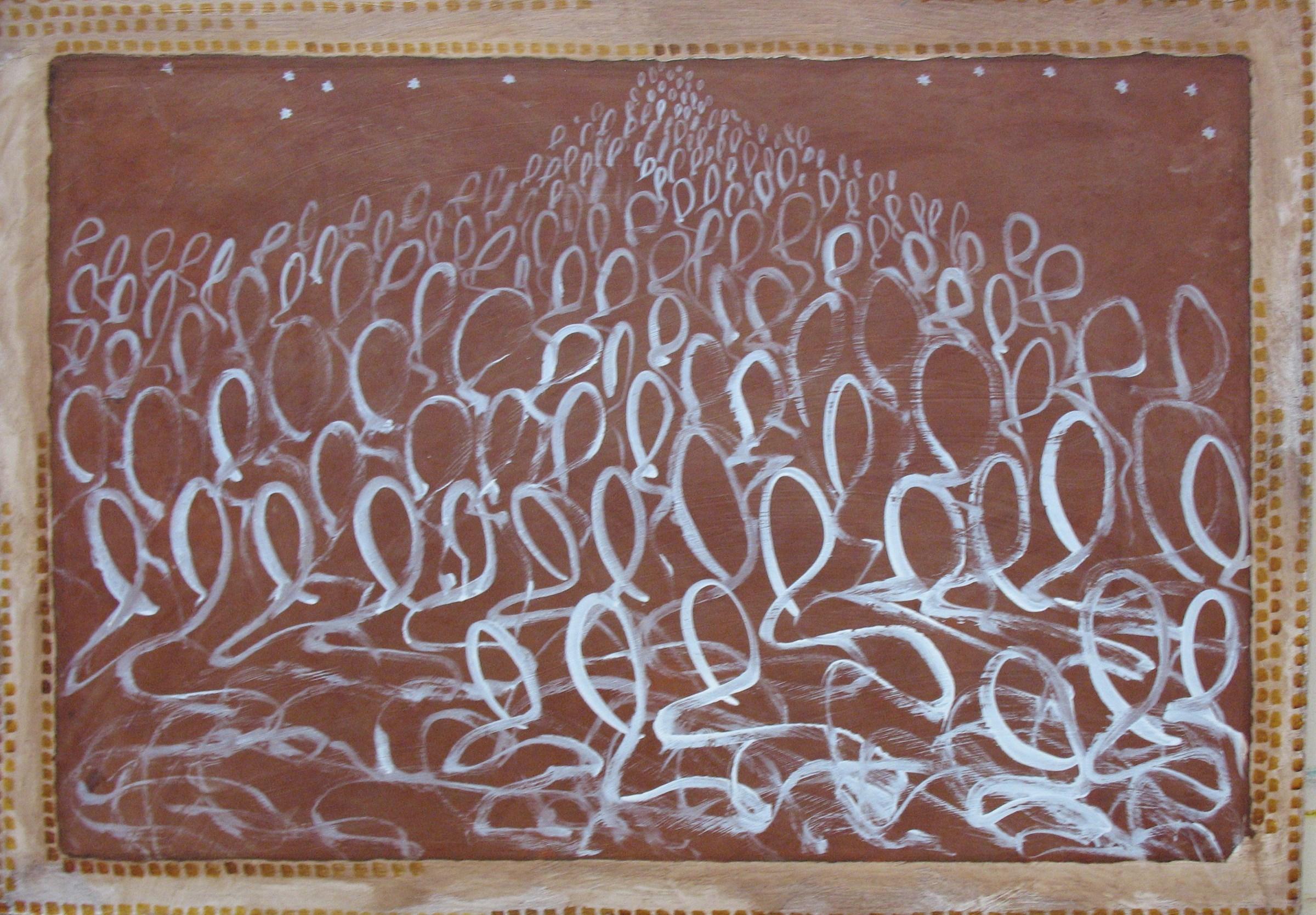
16
Of Course there have been great male feminists throughout history just as there had been great women artists when Linda Nochlin posed that question 35 years ago. My point is we should begin to give them credit and to encourage emerging male feminists to stand up and be counted. I believe there are many who would welcome this overture and strategically we need all the support we can get.
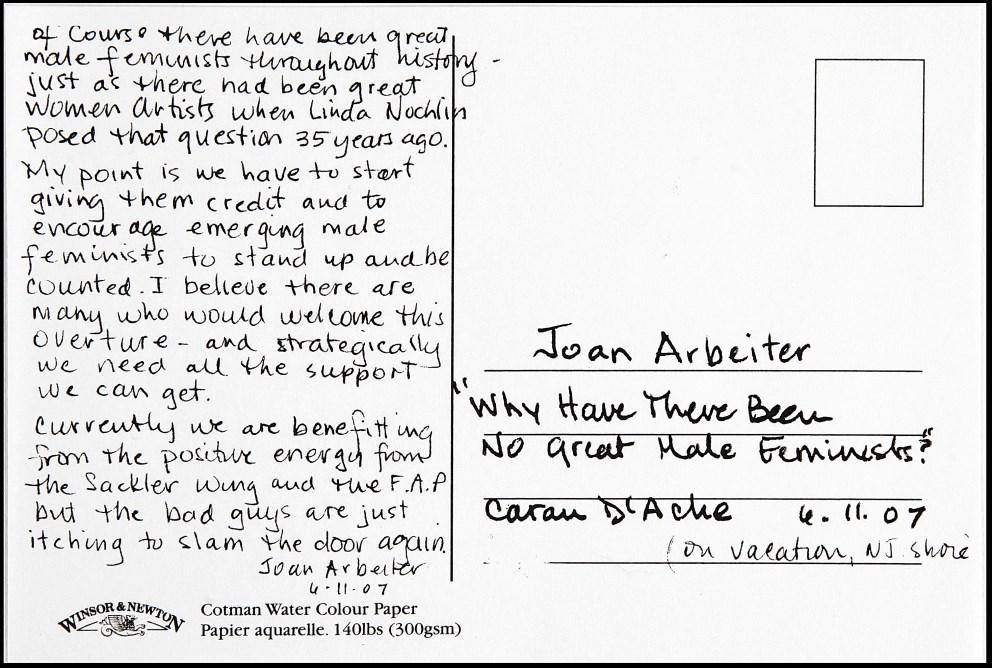
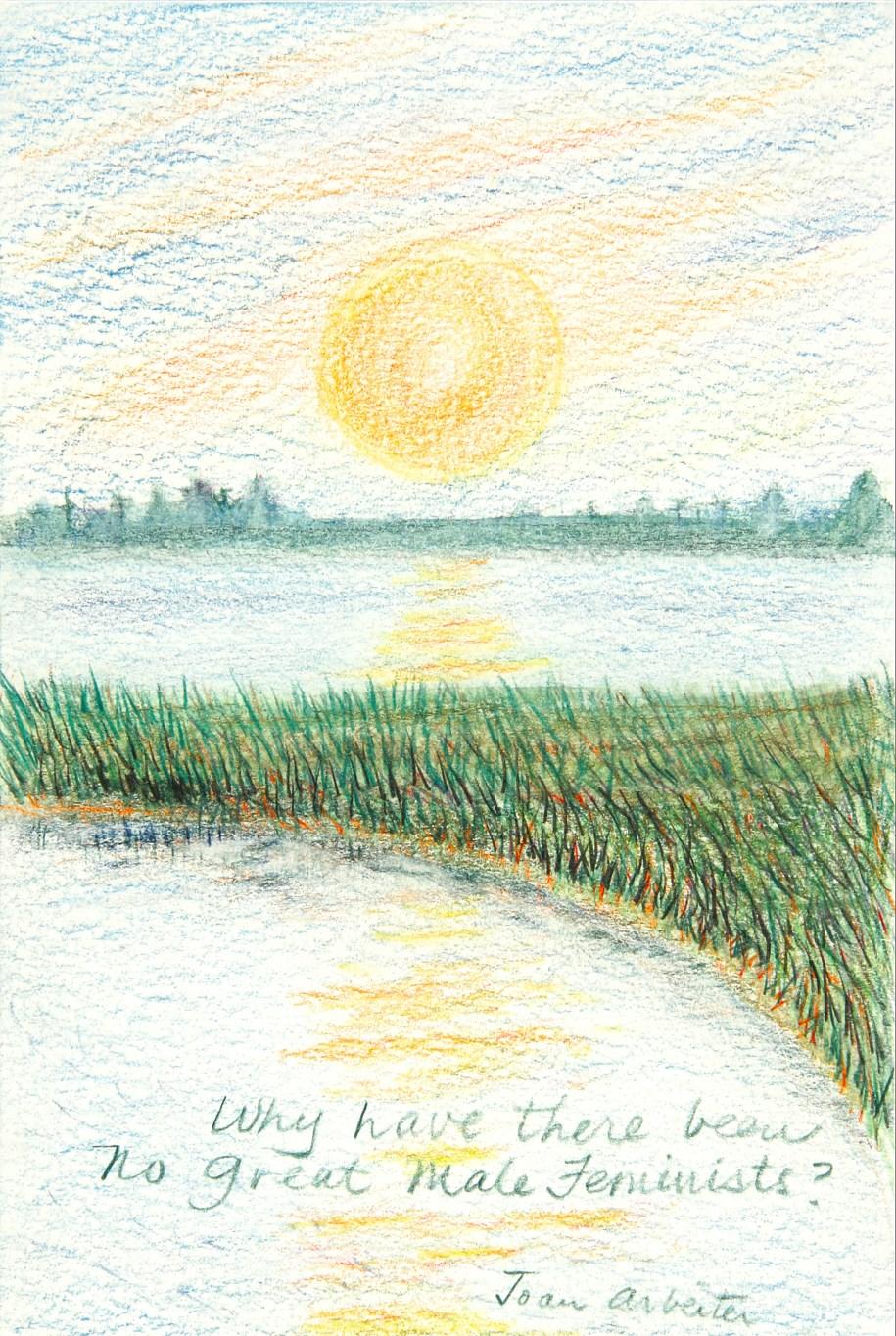
17
Joan Arbeiter. Why have there been No Great Male Feminists? 2007. Caran d’ache on paper. 6 x 4 inches.
*
Art has always been a part of my life. When I found fiber with all its visual and tactile sensibilities, I began quilting. Quilted wall hangings, often with environmental, spiritual or feminist themes, comprise most of my work. Many of these wall hangings, figurative or abstract, are autobiographical. Representing 36 years of married life, the name of this piece is the first line from the song, “I Only Have Eyes for You.” (Could this be sarcastic?)
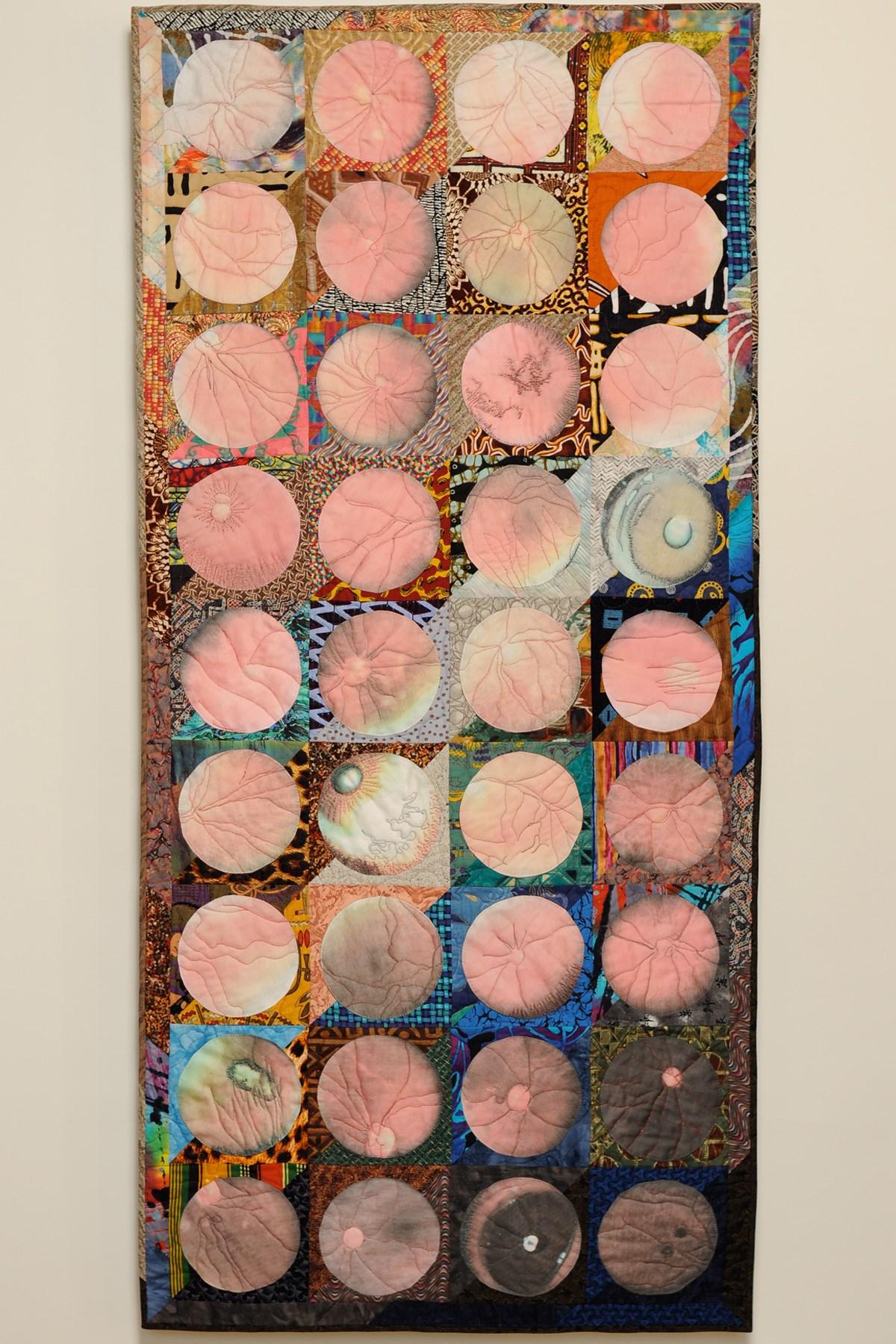
18
Bonnie Dubbin Askowitz. Are the Stars Out Tonight? 2002. Cottons, computer printed fabric and metallic threads. 56.5 x 26.5 inches.
Babes with Backbone is a celebration of strong women. For myself, when I first realized that making ceramic art was what I wanted to devote myself to, I was stymied by fears of unworthiness. It was a strong, woman artist who was my mentor, making her own sculptures and putting them out into the world, and encouraging me to put my self-doubts aside and do likewise. These ‘Babes’ have both curvy figures and strong shoulders. They are not afraid to take a stand. In a way, they mentor me, too.
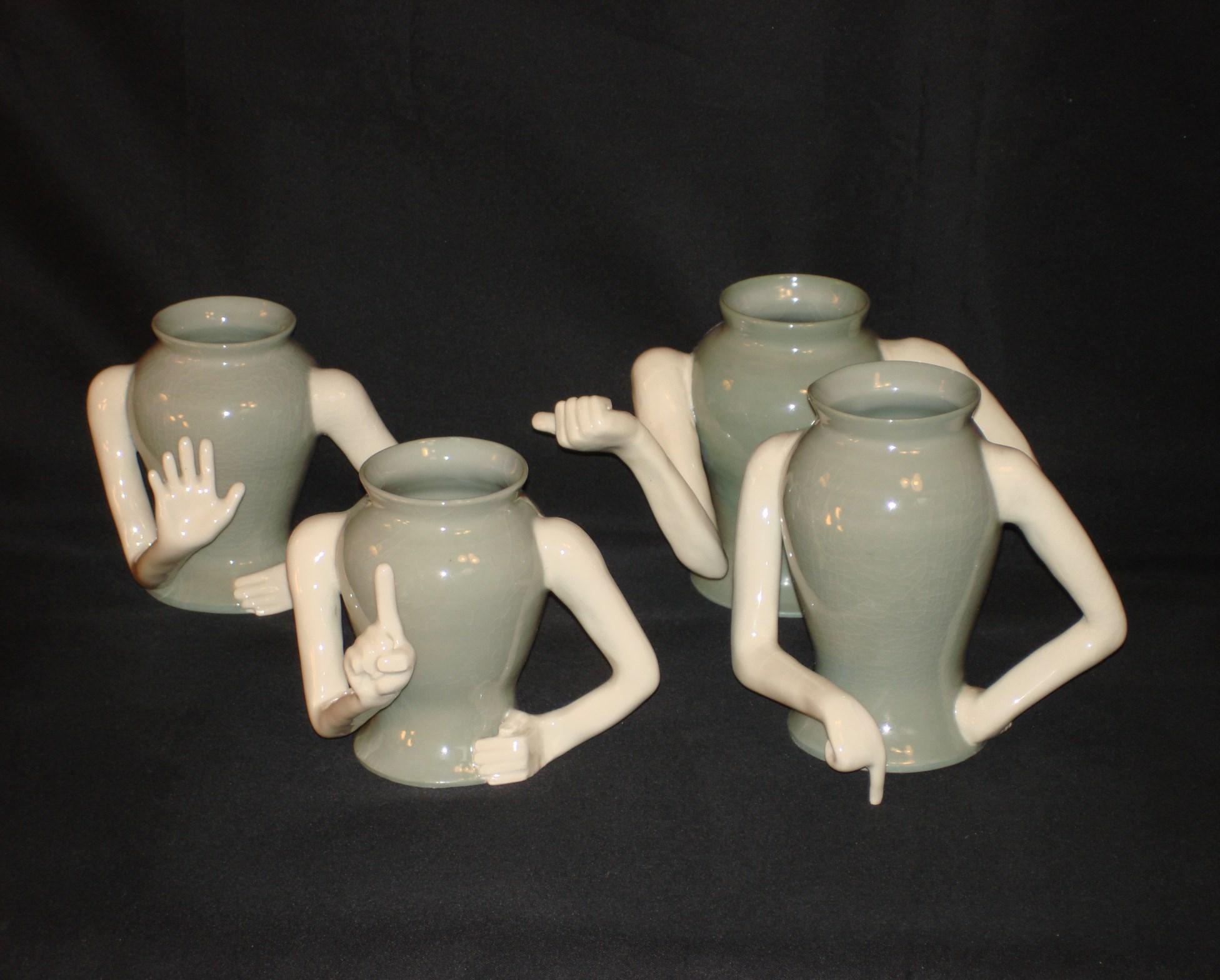
19
Amy Boger. Babes With Backbone. 2011. Ceramic . 8 x 4 x 3 inches each. *
In this new body of work, I chronicle years of needed surgeries and go beyond the physical deconstruction. These are my scars and are a celebration of the life I have been given. I tear the gauze, and piece together all that I am and will be. My scarred chest shapes me into the real woman and not a socialized conception. Momentum is my ability to move beyond that external obsession and claim myself.

20
Jodi Bonassi. It’s Not Pretty. 2011. Recycled papers and canvas, tissues, pastel, acrylic, oil on wood. 23 x 12 inches.
*
In the deconstruction of the body I renew myself through the acceptance that I am a mountain, a compilation of constantly changing forms due to cutting and layering of things I can not control. I can only control my inner thoughts and these are what I bring forward. I work past the blood, gauze and deleted tissues to the new born within me that is real.
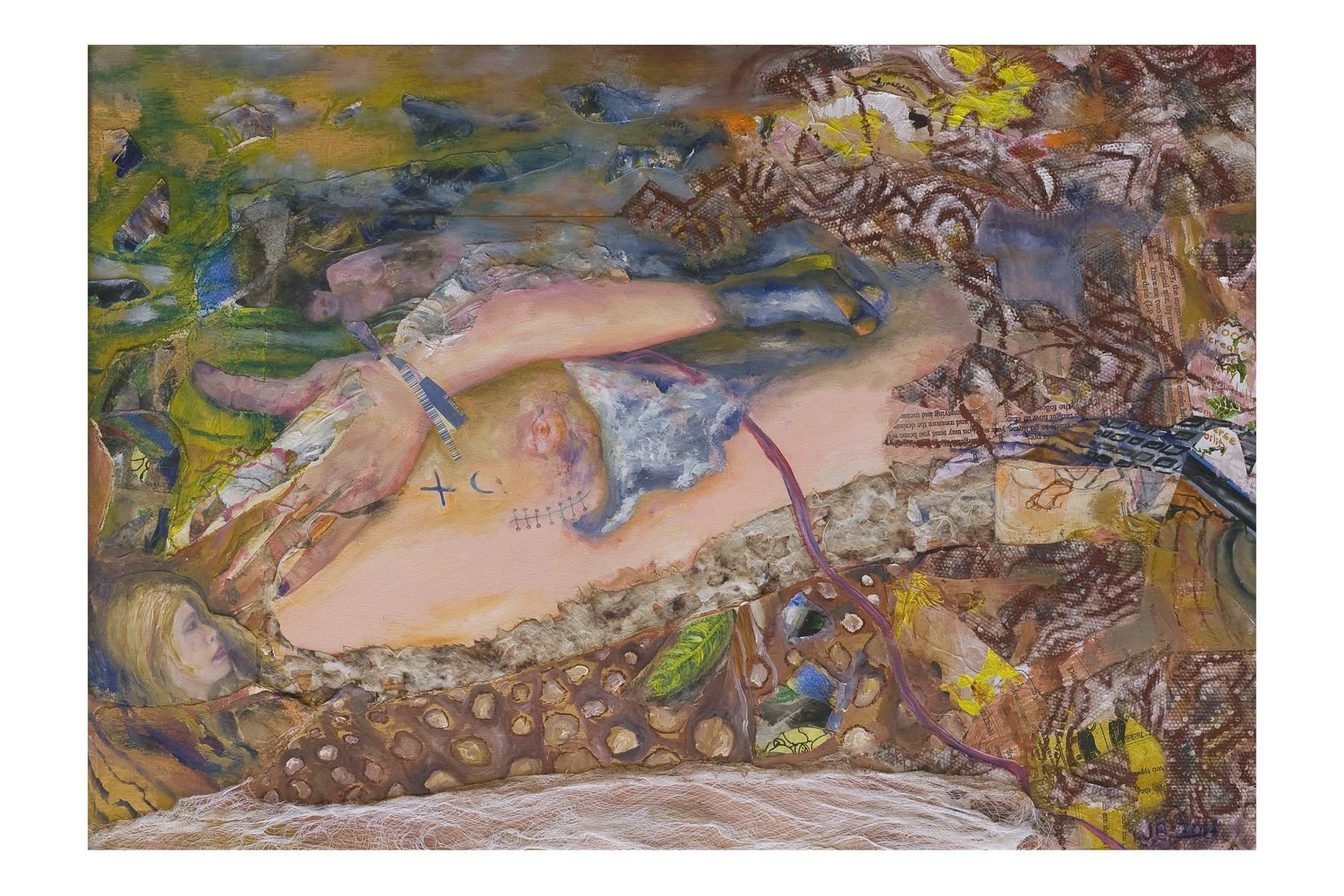
21
Jodi Bonassi. Sterile But Brand New. 2011. Recycled papers, gauze, pastel, ink, acrylic, oil, paper towel on wood. 14.75 x 24.25 inches.
My work explores archetypes of beauty and femininity through a map of invented fantasies. I play with a matrix of contrast and disjuncture that both celebrates and critiques the diversity of feminine prototypes. I am interested in the cultural interpretations of the female form as a composite of historical and popular cultures. The most recent work explores the voices of the Moirae, the three sisters of fate from Greek mythology. These goddesses spin, weave, measure and ultimately cut the strings of destiny.
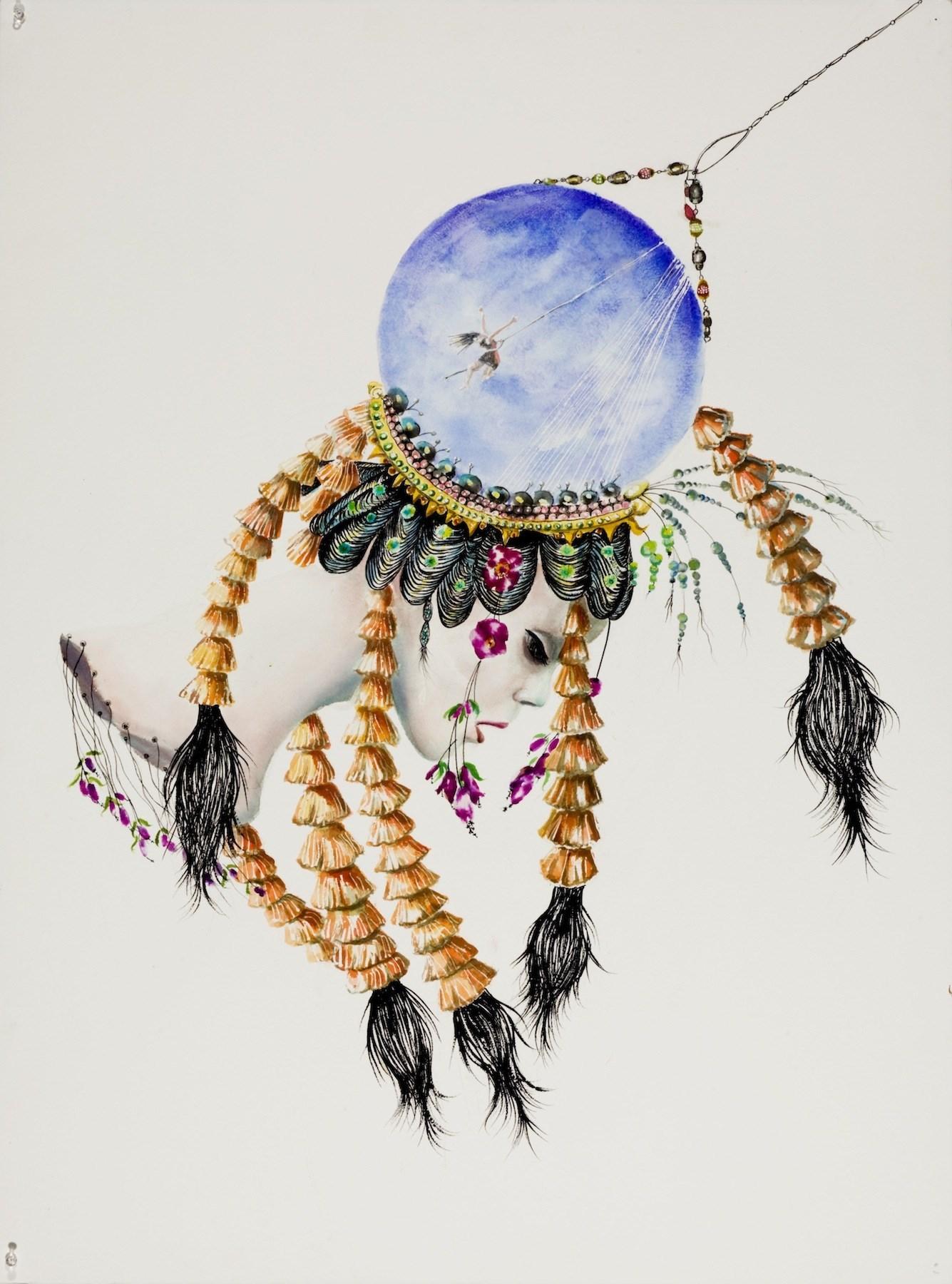
22
Andrea Borsuk. Teevarani. 2010. Watercolor on paper. 30 x 40 inches.
Les Hommes d’Avignon is a sardonic appropriation of Picassos 1907, “Les Demoiselles d’ Avignon.” Les Hommes d’Avignon cynically reverses gender roles while raising frustration and concern on continued inequalities in major galleries and museums. As we acknowledge our predecessors for their achievements within the art world, let’s honor them not through contentment. I hope my work facilitates a dialogue promoting action while bringing the movement forward.
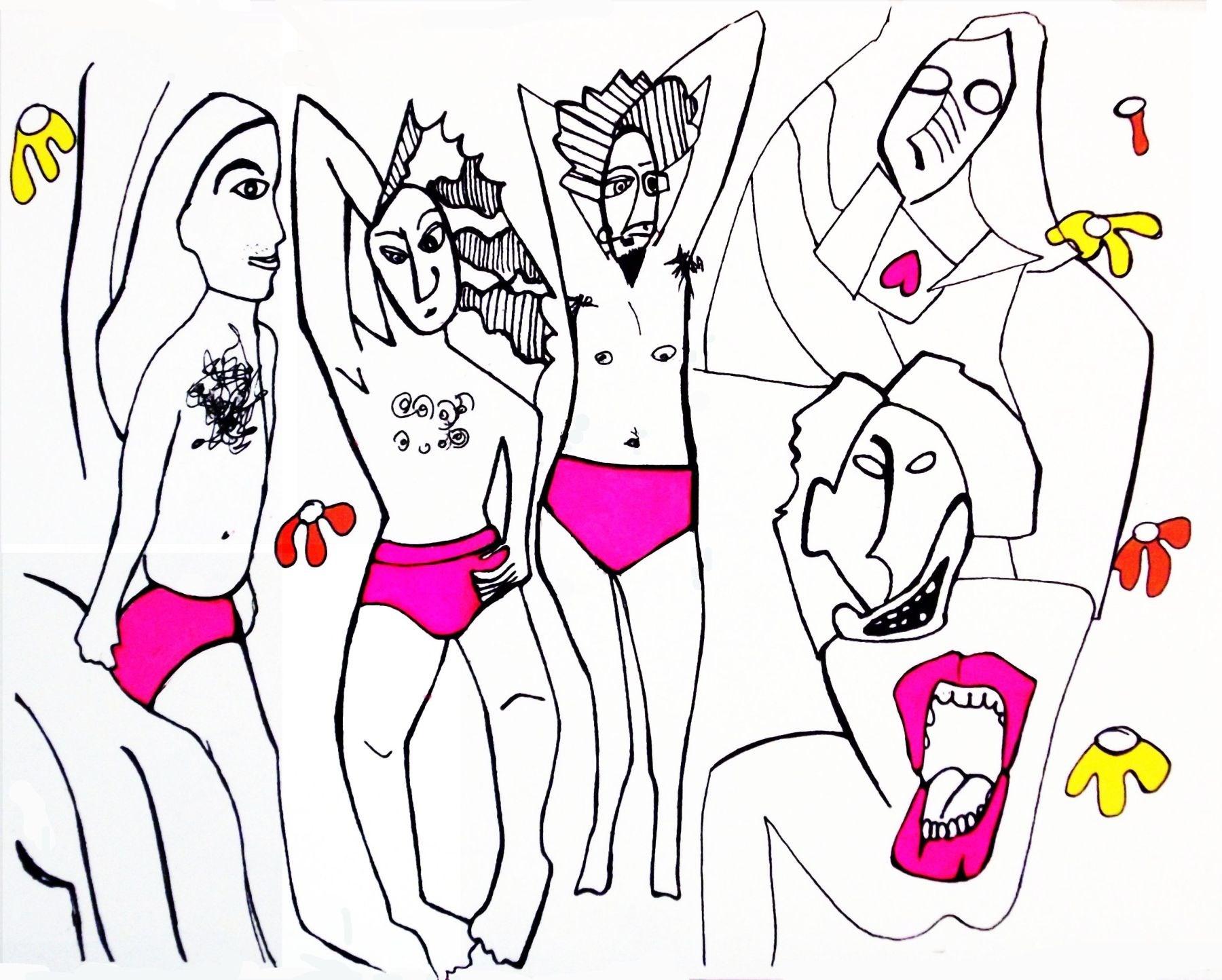
23
Tracy Brown. Les Hommes d’Avignon. 2011. Digital . 24 x 20 inches. *
Using the figure either whole or fragmented I depict my visual journey and seek a common language to communicate my exploration of the human condition especially the merging of birth and death. I am interested in creating three-dimensional spaces in my paintings and works on paper. These are closed and infinite at the same time. The body, especially the female body is both an encumbrance and a vehicle for change. This body of work lives in the shadow world amidst sickness and healing, helplessness and hope, between feeling things are out of control and finding solid ground.
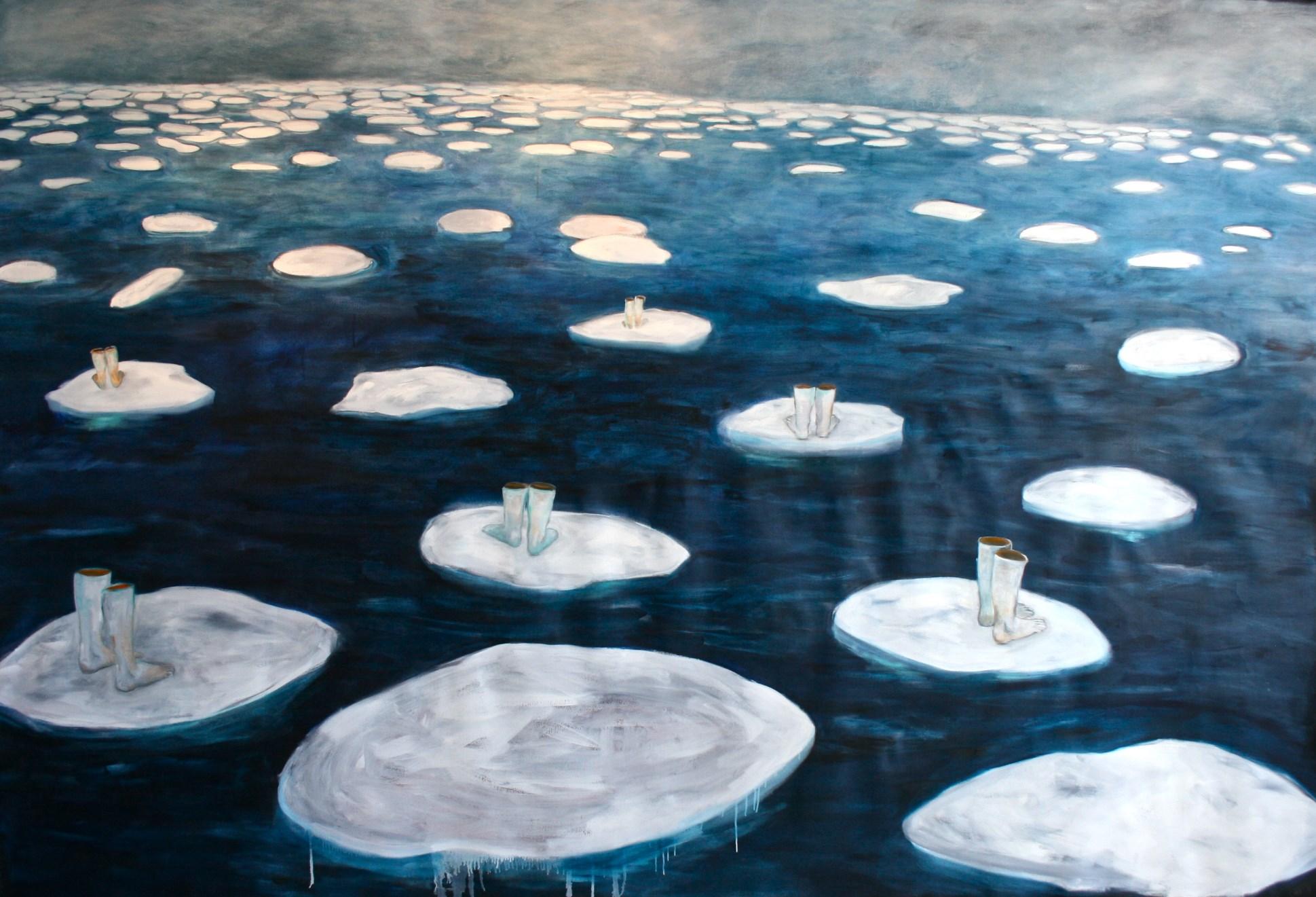
24
Andrea Broyles. Open Waters. 2011. Oil on canvas. 96 x 120 inches.
Barbara Bruch. Menorrhagia Healing. 1991.
For 25 years, the momentum of WCA women has inspired my art, of which some are seen as energy healing paintings. Menorrhagia Healing, is on the cover of “Inherited Bleeding Disorders in Women,” (Ed. Christine Lee) about a friend’s loss of a child.

25
Acrylic, canvas, masonite, clay. 42 x 46 inches.
Motivated by trips to England and Norway, “Spiral of the Rune Goddess” is about hope for return to the sacredness of Mother Earth. It is included in book “Creative Healing” by Dr. Michael Samuels.

26
Barbara Bruch. Spiral Goddess. 1992. Acrylic on canvas, canvas strips with Runes, metal frame. 18 x 28 inches.
I use nostalgic images in my work, and firmly believe that looking at the past helps us to cope with the future. In some respects I see the positive changes we have made both as women and as a society, but in many instances I document the situations that unfortunately, have not changed. We’ve come a long way, but we keep repeating the same mistakes. The retro images I use are a friendly vehicle for my visual comments which would be too dry and preachy otherwise. My aim is to make changes and entertain at the same time.
Creative cultivation was created for a WCA/NH show titled “Dig-it, Locally Grown Art.” I considered how similar art and gardening are. We start with nothing, a blank canvas or a patch of dirt, and create images, plants, flowers, life. Both activities require nourishment, whether its water or inspiration, and the final results are either fulfilling or a messy disaster. But either way it’s an enjoyable experience!

27
Donna Catanzaro. Creative Cultivation. 2011. Archival Print. 19 x 25 inches.
Household work has been a women’s job for centuries, but we are living in a generation that claims equal rights. Being an immigrant, I was conditioned to traditional ideals of what a Taiwanese woman’s duties should be. When people travel, they bring their culture with them. Sometimes the culture that they bring with them changes and adapts to that new environment. In the end, it becomes a modified new culture, and a new generation.
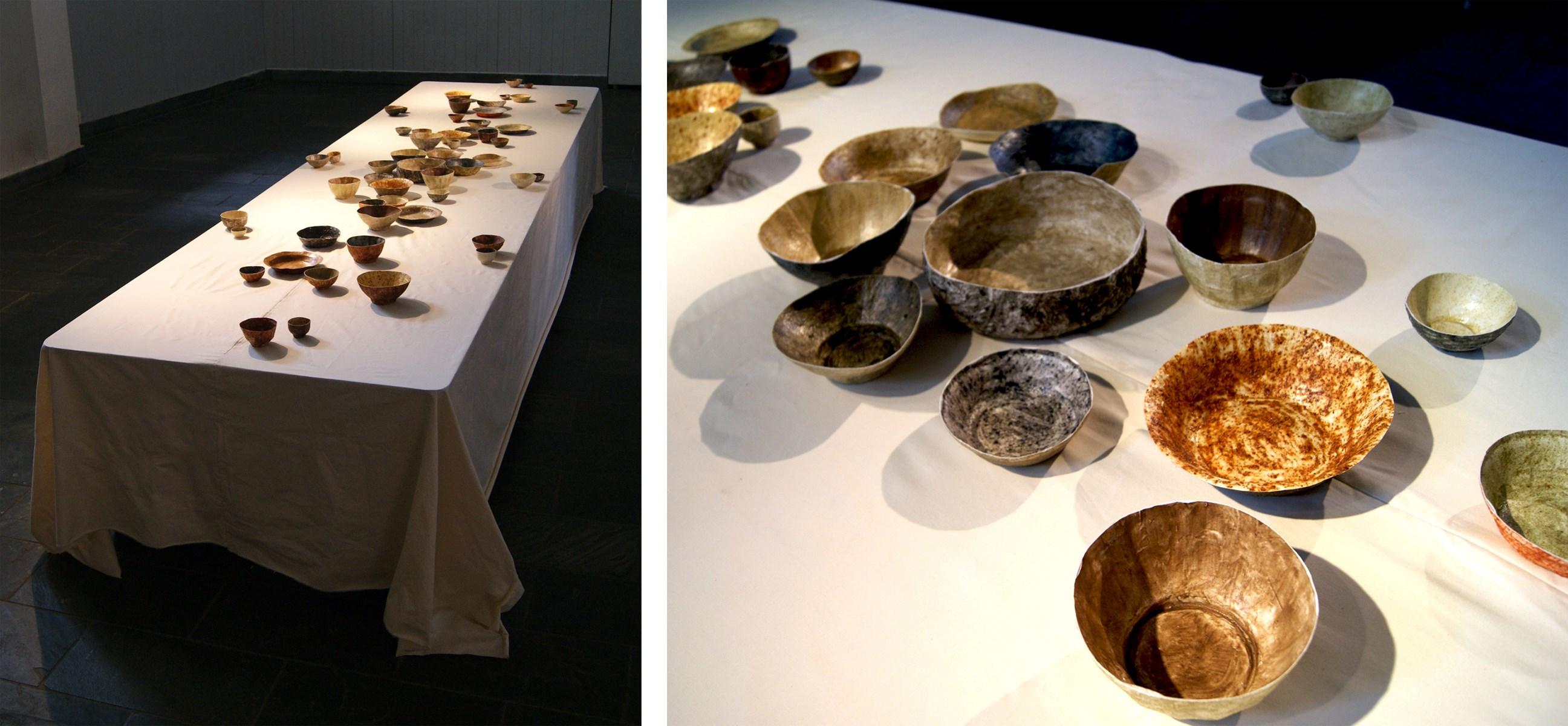
28
Ching Ching Cheng. Dinner Time. 2011. Rice papers, rice glue, food spices, gloss medium, table, table cloth. 3 x 2 x 6 feet.
The creation of useful and beautiful things from remnants and discards has been part of the feminine arts since time immemorial. Since the 1970s, this artistic recycling has included toxic manmade materials, particularly plastics. We are clothing our Mother with these, and in my art I use a combination of thread-painting and heat-fusion to make wearable art from trash. My goal is to raise awareness of the growing problems of pollution and their impact on marine life and human health.
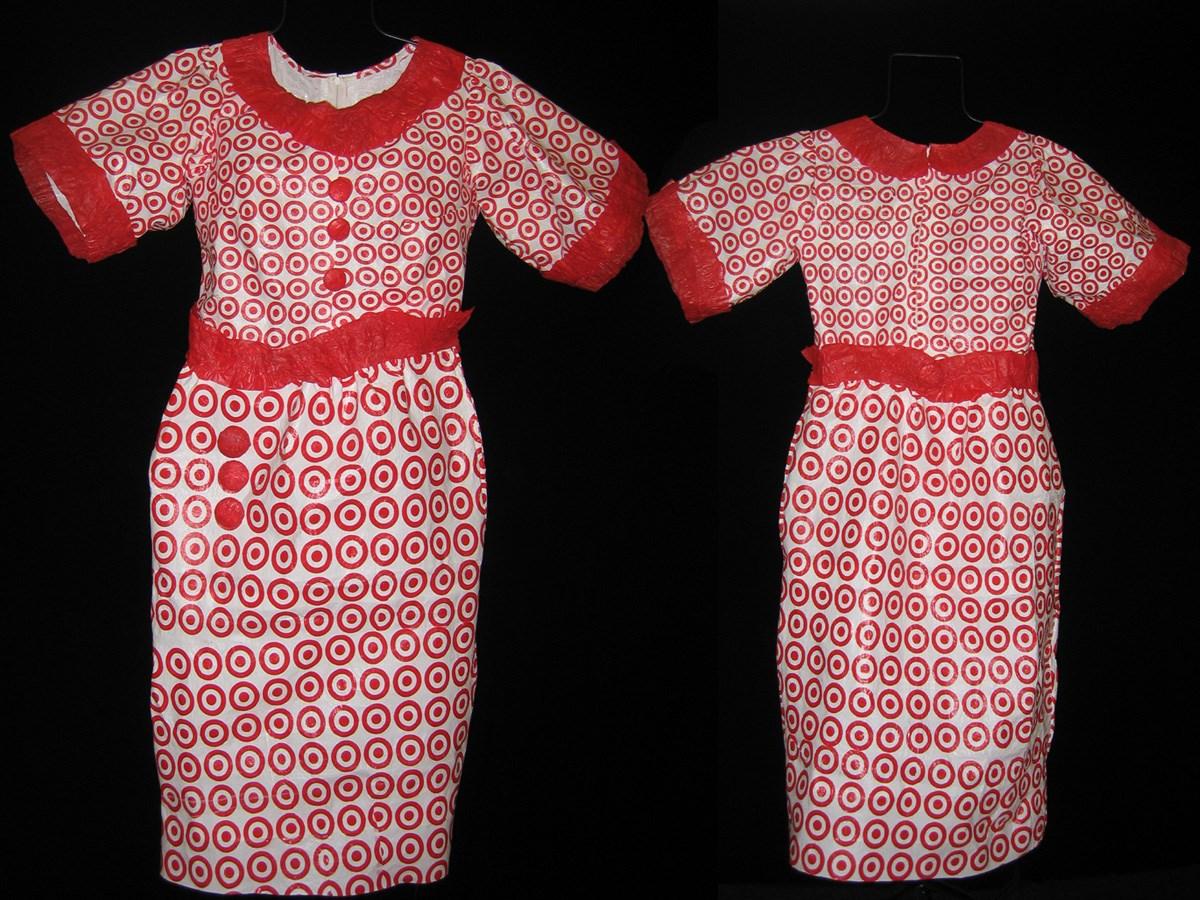
29
Elise Cheval. Aim High. 2011. Recycled plastic bags, thread and mixed media. 5 x 2 x 2 feet.
My work Deployment, with over 250 mock baby formula cans with mock labels, taps into the notion of indoctrination. The cans are stacked on an industrial pallet awaiting some type of distribution. As we have been fed a steady diet of false information regarding the reasons to go to war, the formula cans may imply the notion of feeding the same misinformation to the generations to come.
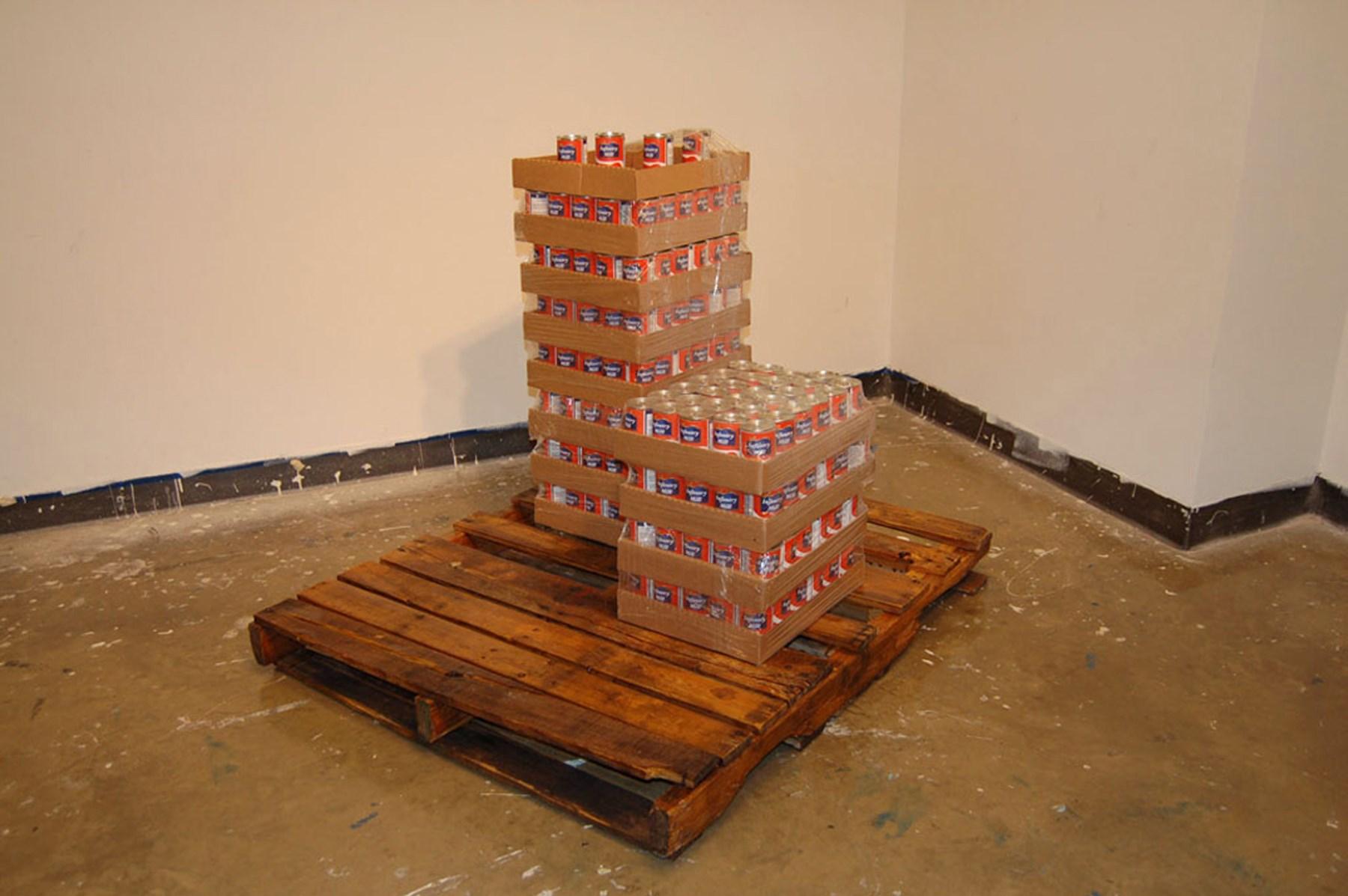
30
Michele Colburn. Deployment. 2011. Pallet and recycled cans with digital material. 48 x 48 x 64 inches. *
I am interested in the point at which fashion and commodity meet Military Industrial Complex and where indoctrination meets commodity. The work I make uses readymades and altered readymades. They are painted, mutilated, printed upon, deconstructed and reconstructed. Marcel Duchamps and many others, opened the doors for their usage. Diverse materials help me to address commodity with the mock products I produce. One year ago, I was painting baby diapers with diverse military camouflage patterns to begin to explore the notion of indoctrination (of parents) or subliminal indoctrination (of children), a year later, actual camouflaged baby diapers are manufactured in limited editions, and in “baby blue” colors.
In Platoons, (2011) diapers, with their association of waste, appear as enlarged pixels of the digital military camouflage patterns, and are presented as legions “marching” into a flag-like formation. Surreal juxtapositions of materials become diverse signifiers.
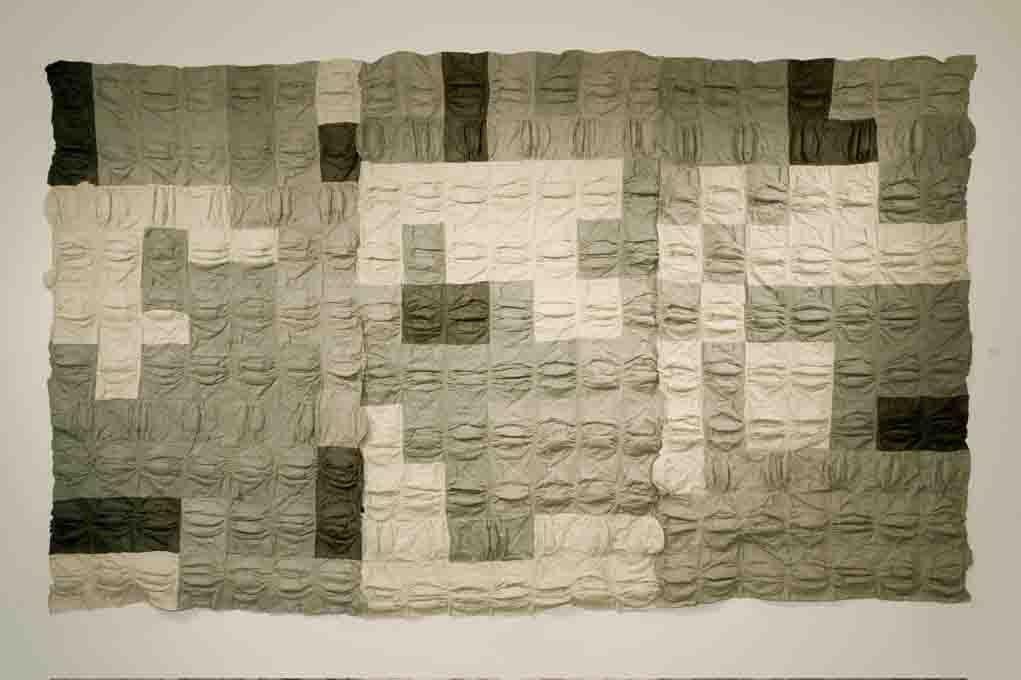
31
Michele Colburn. Platoons. 2011. Acrylic on newborn diapers. 6 x 12 feet.
Judy Cooper. Nancy Spero. 2008. Digital pigment print. 27 x 36 inches.
For several years, I have been photographing the founders of A.I.R. Gallery in New York. A.I.R., the first gallery of women artists for women artists, was founded by twenty young, bold women artists in 1972. Nancy Spero was one of these pioneers. She was one of the most successful and was a leader of the feminist art movement for many years in spite of being stricken with debilitating arthritis. Her enormous spirit and her art will live on and provide a beacon for us to follow.

32
Challenged by today’s culture, rooted in feminism, my art looks at the power, motivation and drive of contemporary women. Determined that females always have a voice, these private diary pages are visual fragments that explore a woman’s strength, power, and social philosophy. My art is about capturing my intuitive guidance and having the strength to follow its direction, wherever it may lead, even when society may not feel comfortable with some of the issues I raise.

33
Linda Rae Coughlin. Tied Up. 2011. Hand dyed recycled fabric strips hooked into a linen foundation, embroidered, embellished with recycled dyed rope. 26 x 16 inches.
Momentum and Intent. My public works intend to transform impersonal or neglected public spaces or awaken public consciousness as to how we diminish vital public resources, such as water. The Namewall, the first site-specific artwork by an artist at the Los Angeles International Airport in 1974, transformed the sterile 263 foot long passenger tunnel of the International Terminal into an aesthetic and personal experience.
A 2008 NMSU exhibition titled, Of Water and the River: Meditations on the Rio Grande, culminated a two year study of issues of water and the river in New Mexico asking: What shall we do when the river runs dry?

34
Joyce Cutler-Shaw. The Namewall. 1974. 16 photographic prints in acrylic-box frame. 25 x 38 x 1.25 inches.
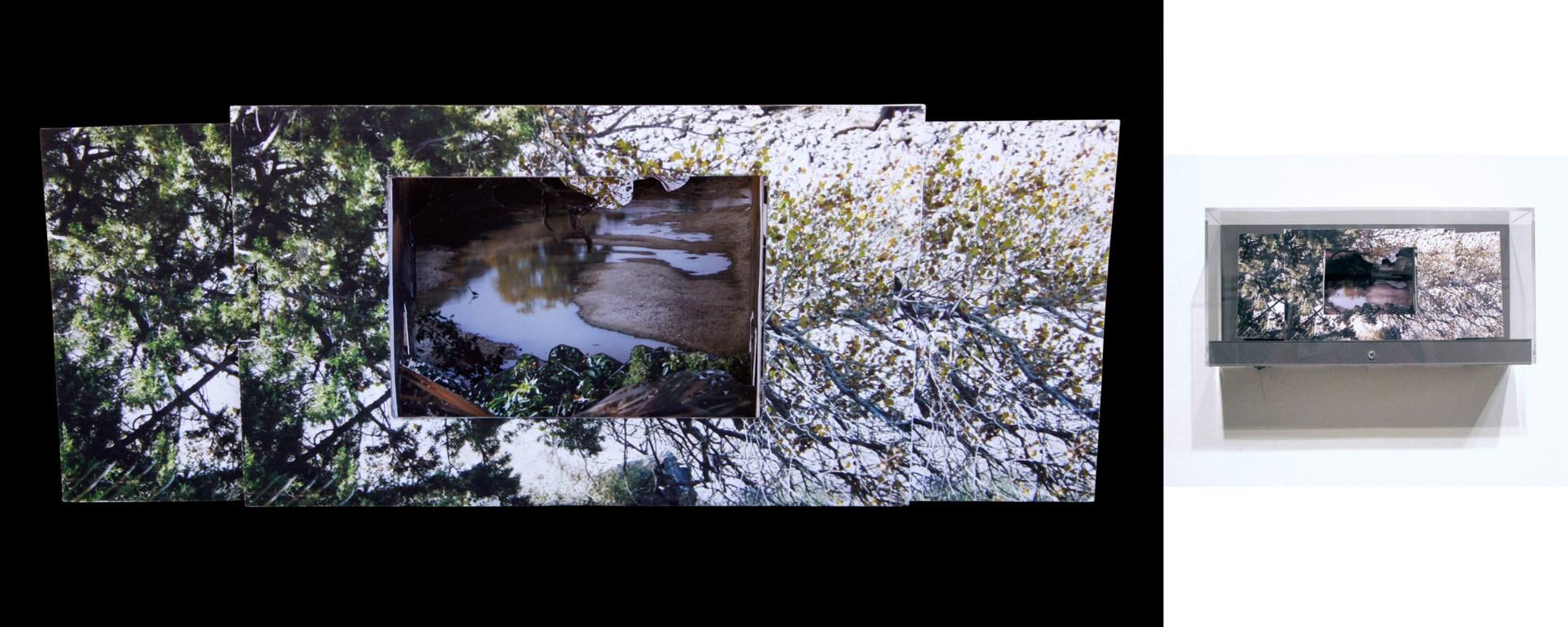
35
Joyce Cutler-Shaw. At Elephant Butte: When The River Runs Dry. 2009. An artists slide book of inkjet prints mounted on museum board, in acrylic box frame. 5.875 x 13.25 x 4.5 inches.
Gina Dabrowski. Nicole's campsite. 2007. Digital C-Print. 20 x 24 inches. *
MichFest brings women together for music, nurturing and support in an environment with no male presence. Mothers want their daughters to experience the freedom of being on the Land. In photographing here, I feel connected and rejuvenated as an artist, doing work that reflects my woman-centered identity.

36
Gina Dabrowski. Dee and Angela. 2009. Digital C-Print. 20 x 24 inches. *
I use photography to examine social space and its cultural construction, as it is played out at campsites at the Michigan Womyn’s Music Festival. Here on the Land, Dee and Angela create a home made up of four tents to ensure their comfort and entertain friends.
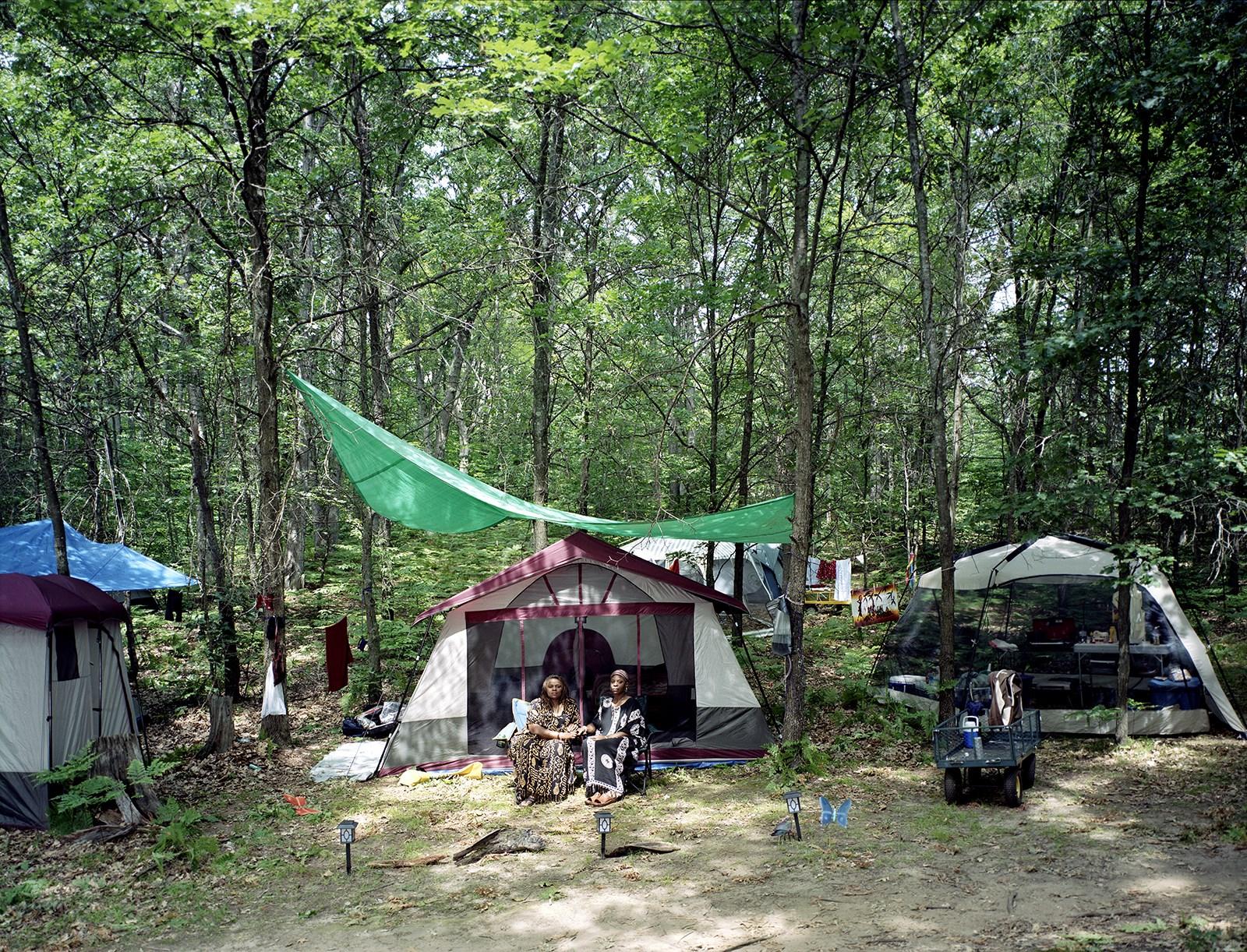
37
My painting evokes an almost faceless woman, tired, burdened, and worn…one of thousands in Romania who starved and slaved thanklessly for decades throughout the communist era and before that during the war.

38
Mary Lou Dauray. Face 1. 2011. Oil, graphite and India ink on gessoed watercolor paper. 30 x 22 inches. *
Inspiration for this painting stems from a visit to holocaust sites in Eastern Europe. Doing the artwork helped me to begin the process of trying to comprehend the anguish I felt from seeing these memorials of terror. Also, while painting, I kept being reminded of the seemingly endless struggle of women and minorities against oppression.

39
Mary Lou Dauray. Face 3. 2011. Oil, graphite and India ink on gessoed watercolor paper. 30 x 22 inches.
I use repetition in my work because it creates a sense of memory, heredity and evolution, movement and momentum. The landscape of the collage creates a sense of flow, water running through a trough. The inception of the piece is story which is a related sequence of evolving and developing events that have momentum, the flow of passing down of memories and experiences, traces left by the momentum of a life passing through this one, and even the evolving, enduring momentum of love between a grandmother and granddaughter.
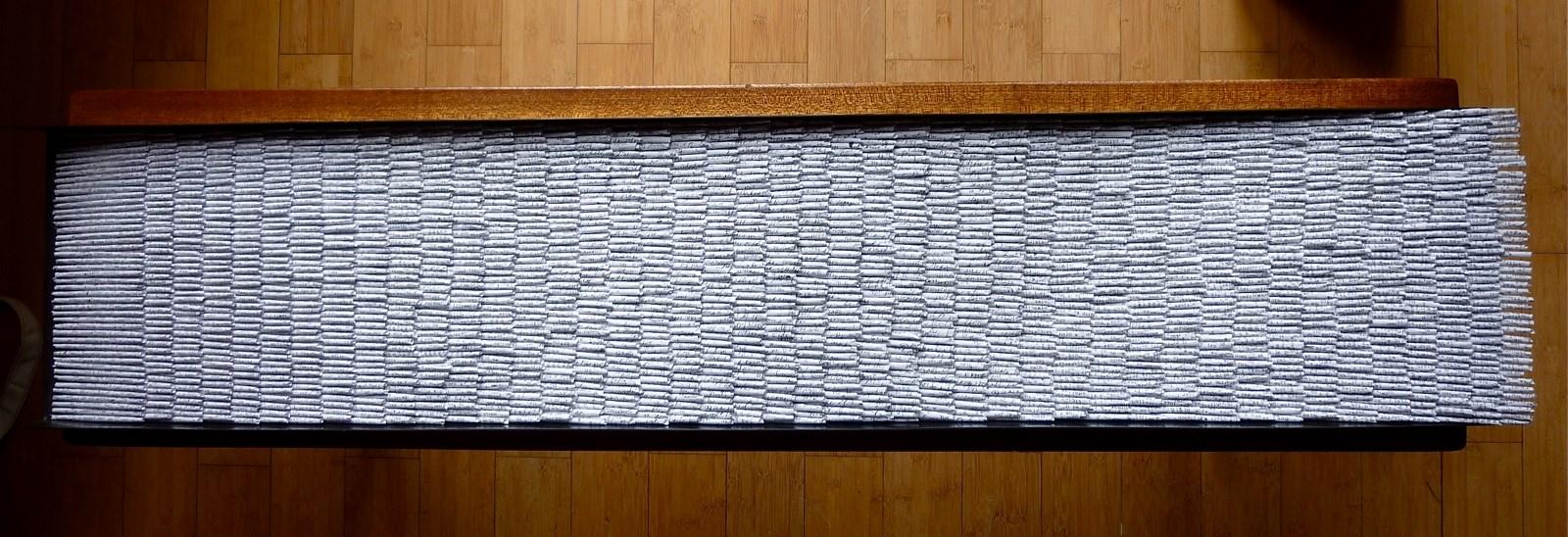
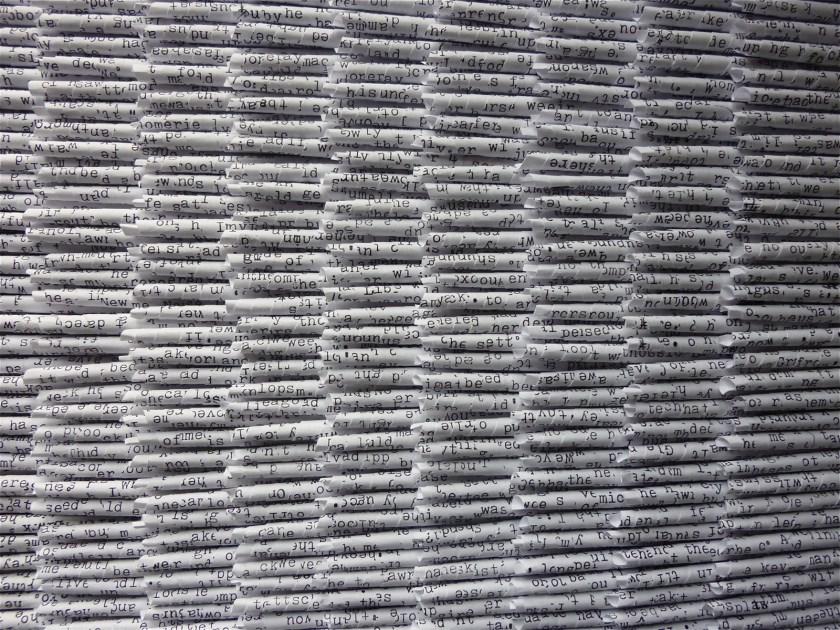
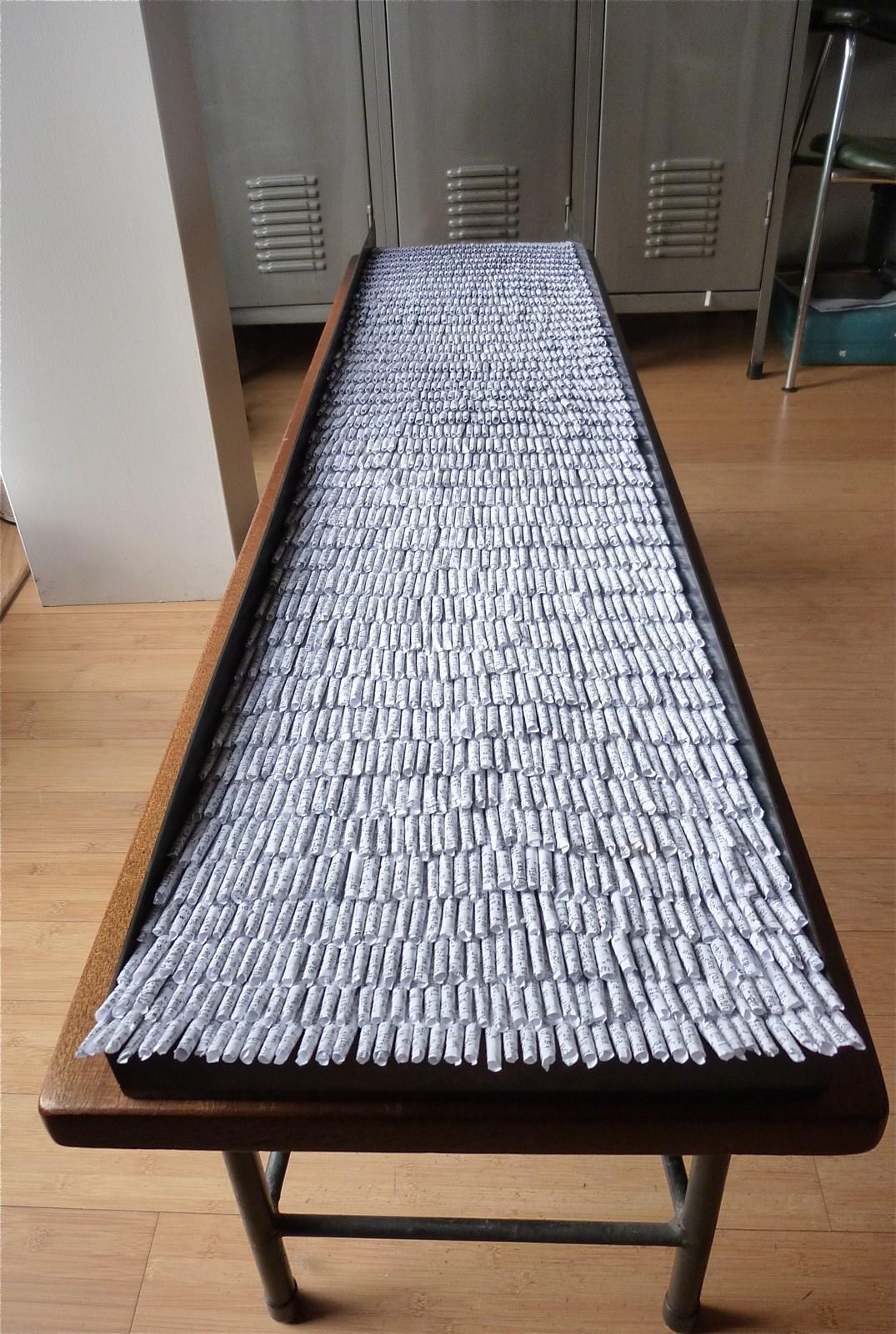
40
Michelle de la Vega. God Land. 2010. Steel, photocopied paper, glue. 48 x 11 x 3 inches. *
Cat Del Buono. Tears. 2011. Video framed in digital monitor. 16.5 x 13.5 inches. *
Based on Man Ray’s “Tears”, this looped video (displayed in a framed monitor) allows the female subject to come alive and blink. It also comments on beauty and the female struggle.
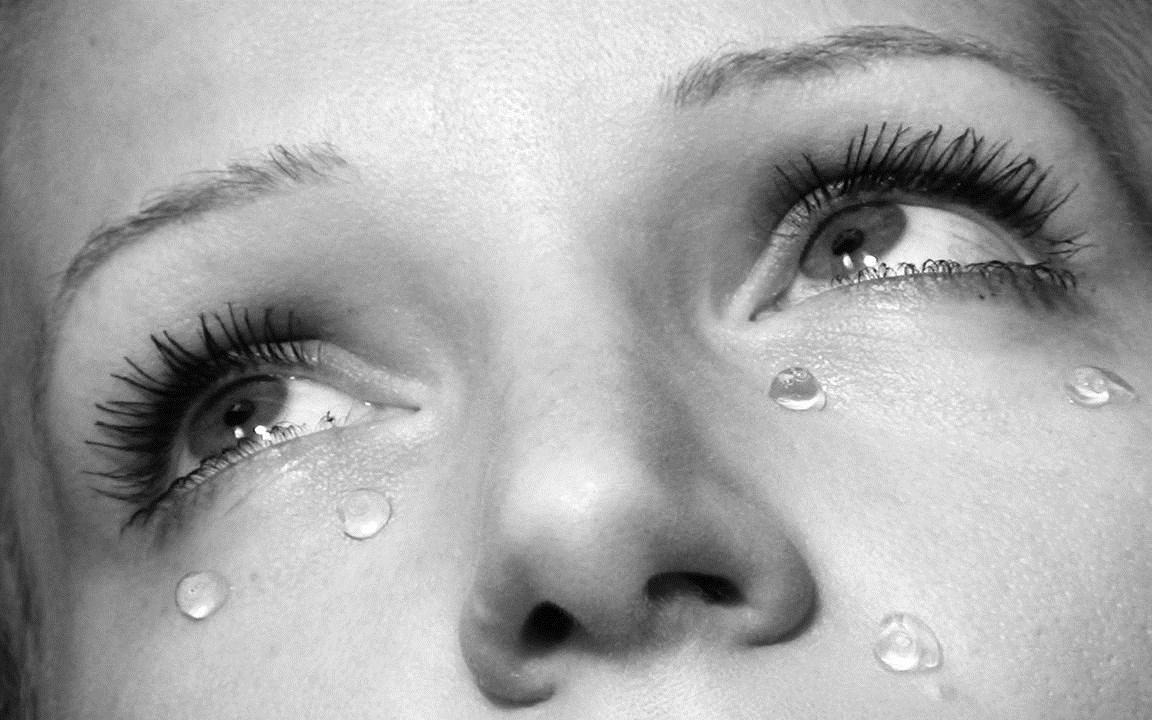
41
Cat Del Buono. Now I'm Beautiful! 2011. Video. 1:30 minutes.
My most recent works have been videos that use humor and performance to accentuate the absurdity of women conforming to an arbitrary idea of beauty. As I perform tasks to become “beautiful”, I use balloons, candy lips, and exaggerated sounds to add to the oddness of it all. My question remains: after all these years of fighting for equality, how can women conform to something so unnecessary and so obviously male-centric?

42
Cat Del Buono. Your Face Here - simple. 2011. Latex balloons, paper, tape. Variable.
This simple installation is made up of two latex balloons and a piece of paper commenting on women, plastic surgery, and conformity. It aims to trigger thoughts about our definition of feminine beauty and to challenge our acceptance of unnecessary surgical implants.

43
Eleanor Dickinson. Artist-Victim? 1998. Ink on paper. 46 x 35 inches.
My early involvement in the Women’s Movement is embodied in this drawing: Artist-Victim? she thinks she is a victim but she can be free if she wants to as can Manadel. The Dark Madonna is free!

44
In the black-and-white relief print media of linocut and woodcut I explore the subject of human relationships through figure-based imagery. In current work I contemplate the persistence of war and the ways in which we are divided or united in the face of destruction and power. This print is from a series in which two female figures grow old and young again, watching and experiencing this continuum. Witnessing the devastation, their tears regenerate the soil and a new generation emerges.
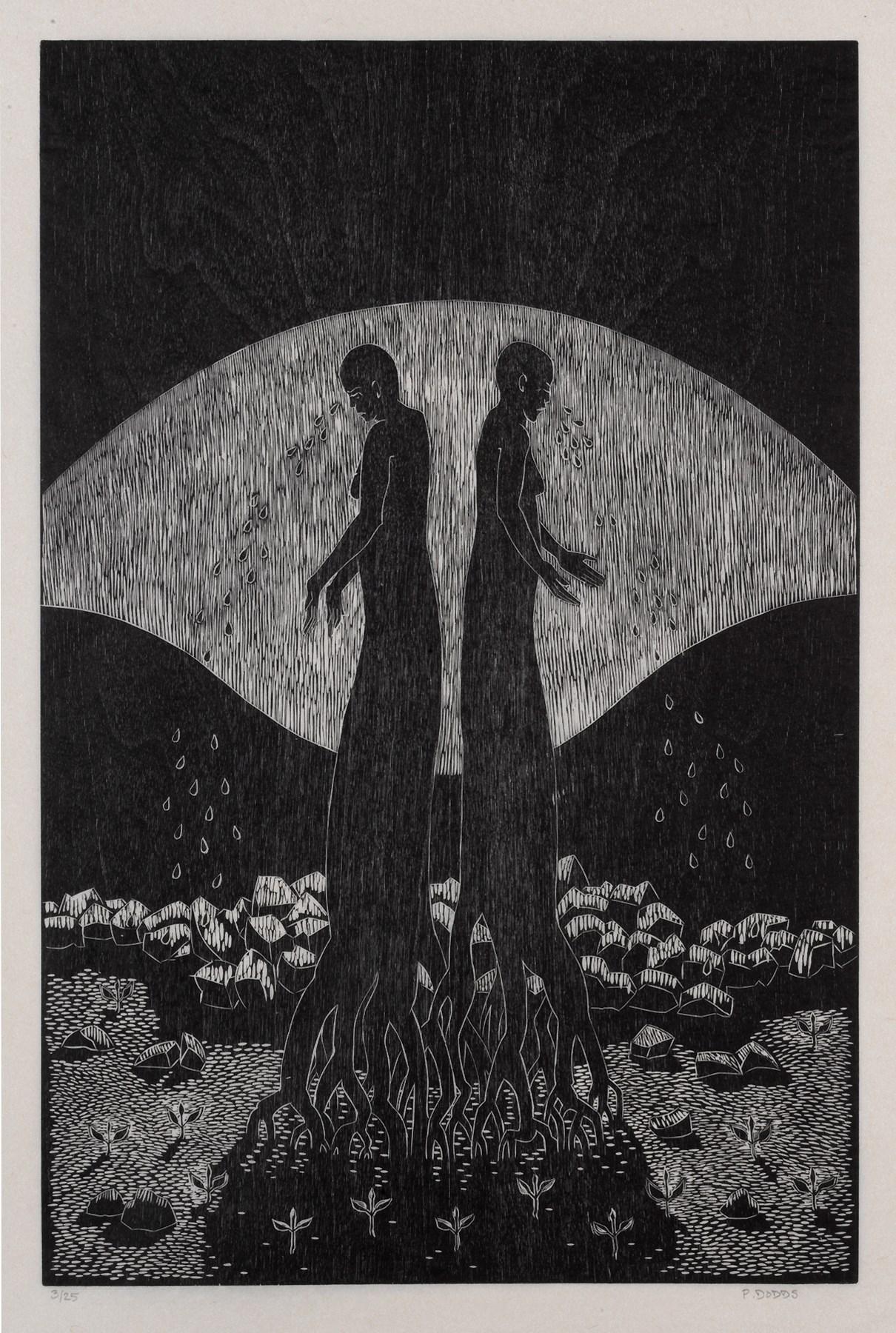
45
Pamela Dodds. Sorrow’s Garden. 2010. Woodcut, oil-based ink and Japanese paper. 26 x 17 inches.
I am interested in connections between our societal belief systems and how we treat the planet, each other. In the past 30 years, my work has moved from personal issues in agriculture and reproductive freedom to land use, planetary processes such as climate change. Strategies include resistance and resilience, a theme I find in basic natural processes. These are my response to the Western landscape tradition which distances the viewer from the outdoors and people. Intimacy with places creates profound relationships to them. Who says you don't need romance in a revolution?

46
Alice Dubiel. Strategic Clearing: White Pass and Bumping Lake. 2000. Golden iridescent and interference on gessoed Indian villages handmade paper. 24 x 34 inches.
A life long search for role models has led me to seek out fellow artists, especially the senior woman. I am grateful to them for living their lives as committed artists, following gladly in their footsteps. The portraits of Sylvia Sleigh and Louise Bourgeois are tributes to them and our friendship. Group Nine is a painting of my fellow collaborative artists. We have worked together for eighteen years, and have become an extended family. These relationships I treasure, they sustain me and serve as a creative momentum always.
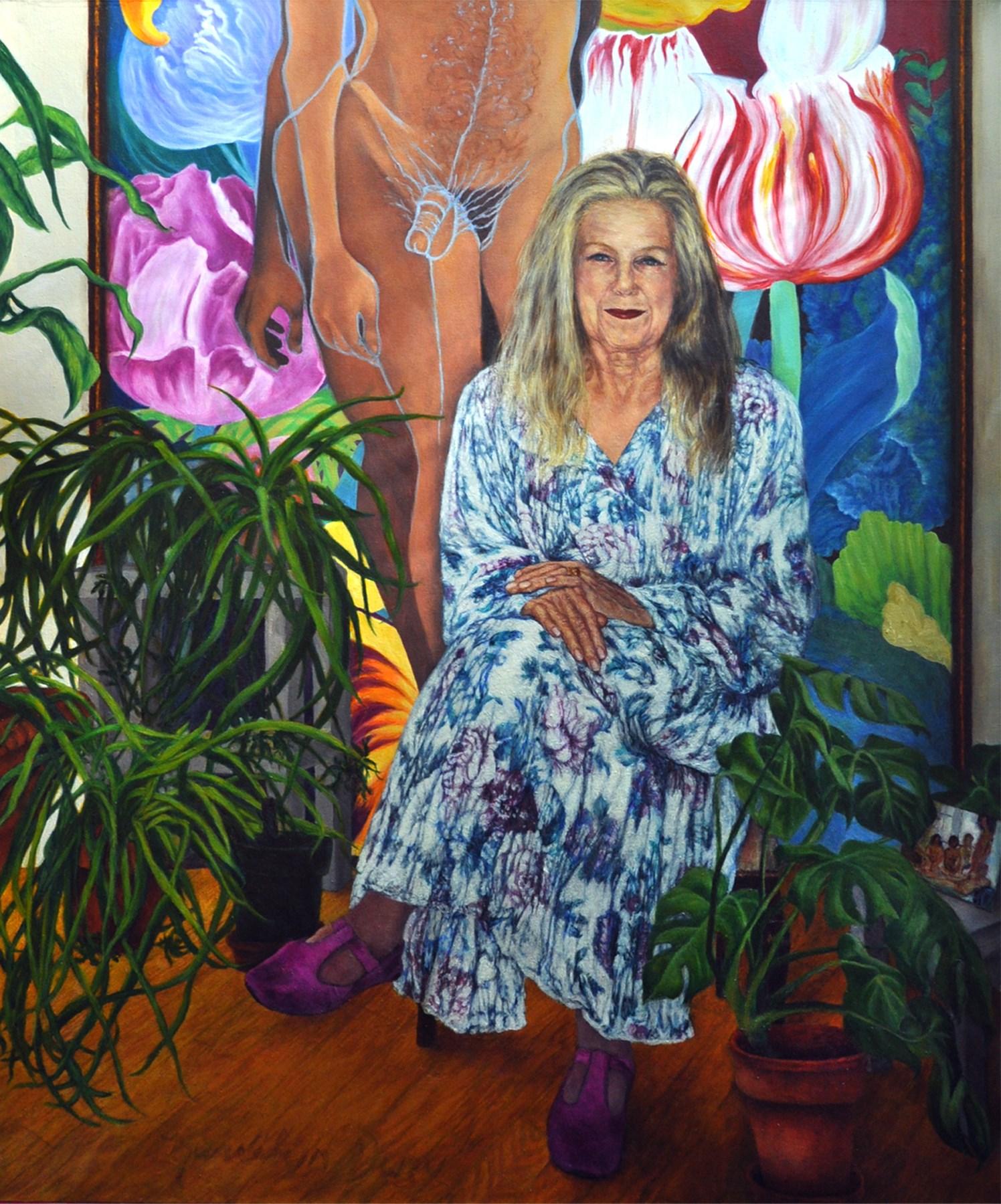
47
Merrilyn Duzy. Sylvia Sleigh. 2008. Oil on canvas. 48 x 40 inches.
The sculptural works presented focus on the idea of control and stability verses chaos and unpredictability. Structure becomes mobile fashion accessory. Although the works reference traditional building techniques and materials, they are fashioned in an unstable and chaotic manner, which force the body into absurd and uncomfortable situations. The sculptures are a frenzied attempt to create order from an ultimately unpredictable surrounding. The mobile/ wearable element of the work subverts attempts of control and order.
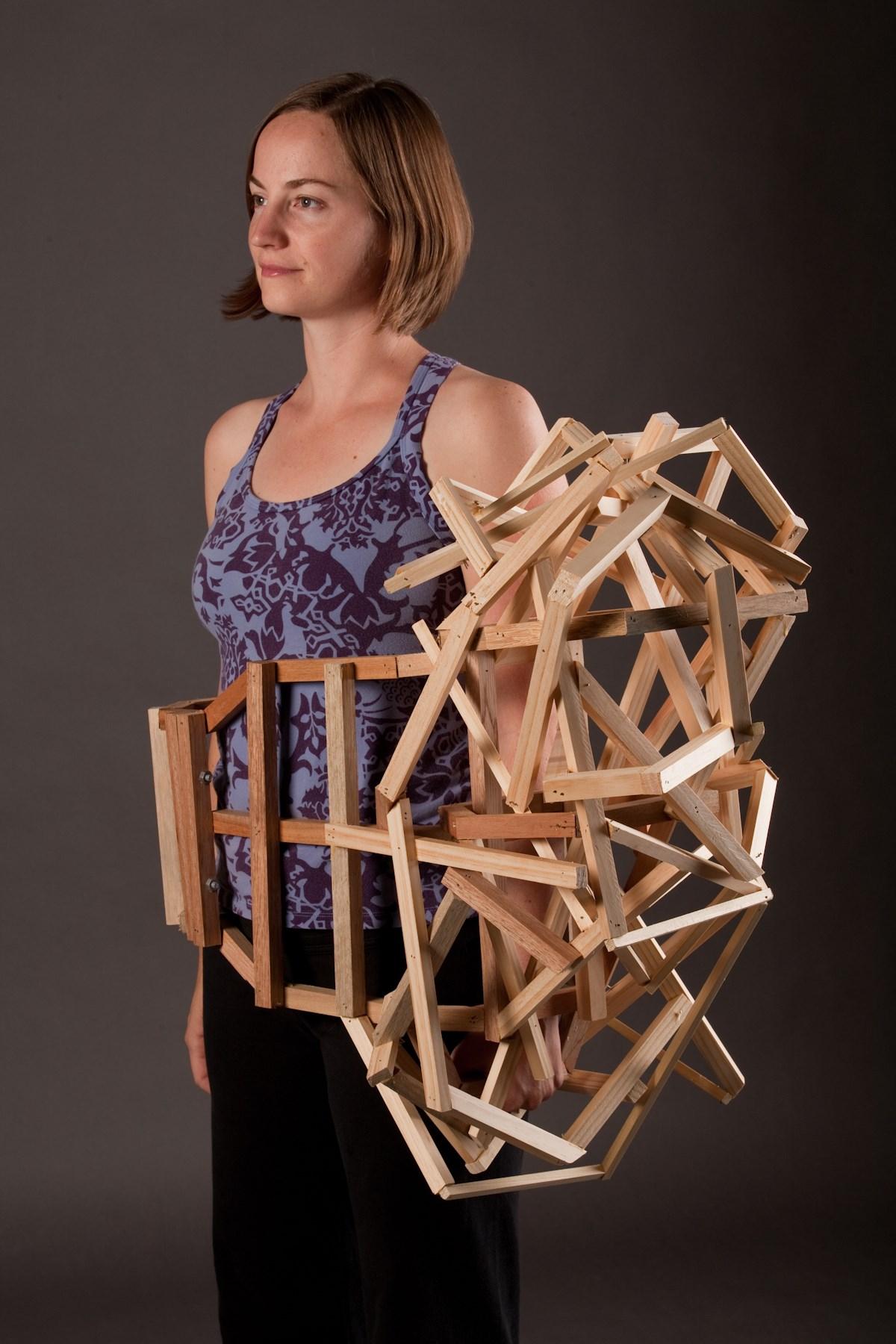
48
Tracy Featherstone. Wearable Structure: Side Bump. 2010. Wood. 36 x 24 x 16 inches.

49
Tracy Featherstone. Wearable Structure: Arm Extended. 2010. Wood. 48 x 36 x 24 inches. *
Woodblock Print is part of a series of pieces, mostly photomontage and photo etchings, begun in 2009. In this series, visual ambiguities are paired with conceptual ambiguities. Most pieces play with surface and perspective in two dimensions, the way the eye and brain succeed in overriding material reality with illusion. Hanging requirements, e.g., the wooden frame for Woodblock Print, intermix art and “non-art”. Several perspectives, scales, and interpretations often are presented or implied. Titles may provide another slant.

50
Trish Foschi. Woodblock Print. 2009. Photo etching on BFK Rives paper, limited edition of 20. 17 x 17 inches.
My oil paintings of strong, sensual, unselfconscious women express my life’s artistic momentum. I've been a professional artist for 30 years but began painting the human figure only a few years ago. At age 66 I’m at last up to speed pursuing my passion to explore color, shape and the female form on canvas. Each painting births new ideas that enthrall and challenge me, propelling me forward. Each painting is both where I am and where I'm heading. Most gratifying is that women tell me my painted figures inspire them with their strength and unconventional beauty.
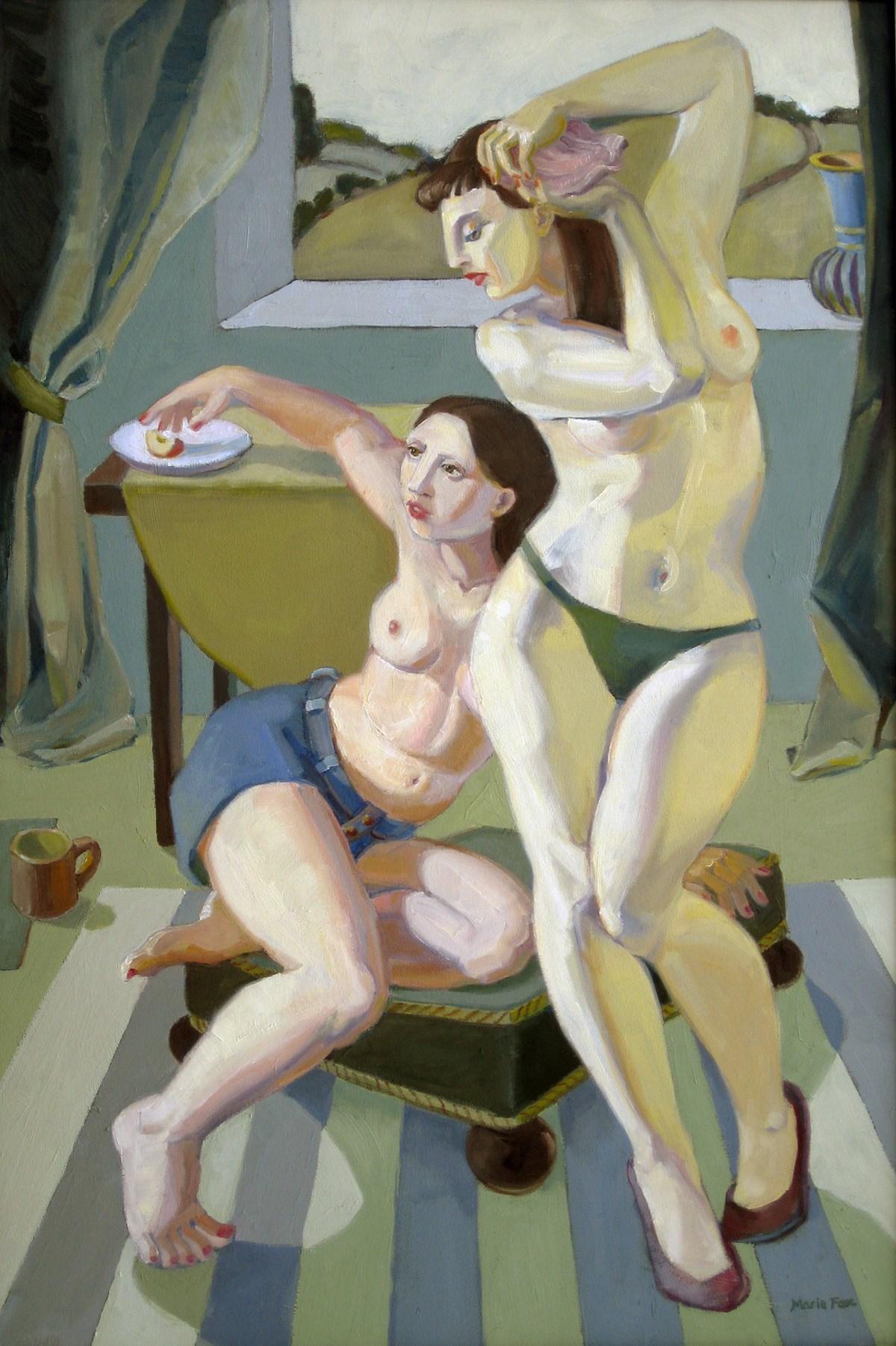
51
Marie Fox. Sounds Of The Sea. 2009. Oil on canvas. 36 x 24 inches. *
After 9-11, all Muslims were demonized. While travelling in Egypt last year, I found that the average Muslim woman was a paradoxical blend of traditional garb and current fashion. The women were not only influenced by their religious traditions, but also by the media. To capture the duality of these women’s lives, I combined the fashion logos that I saw on the surrounding billboards onto their image. A year after I took these photos, many of these women were instrumental in overthrowing the decades-long dictatorship in Egypt.

52
Judy Gelles. Boss. 2011. Archival inkjet print. 17 x 11 inches. *
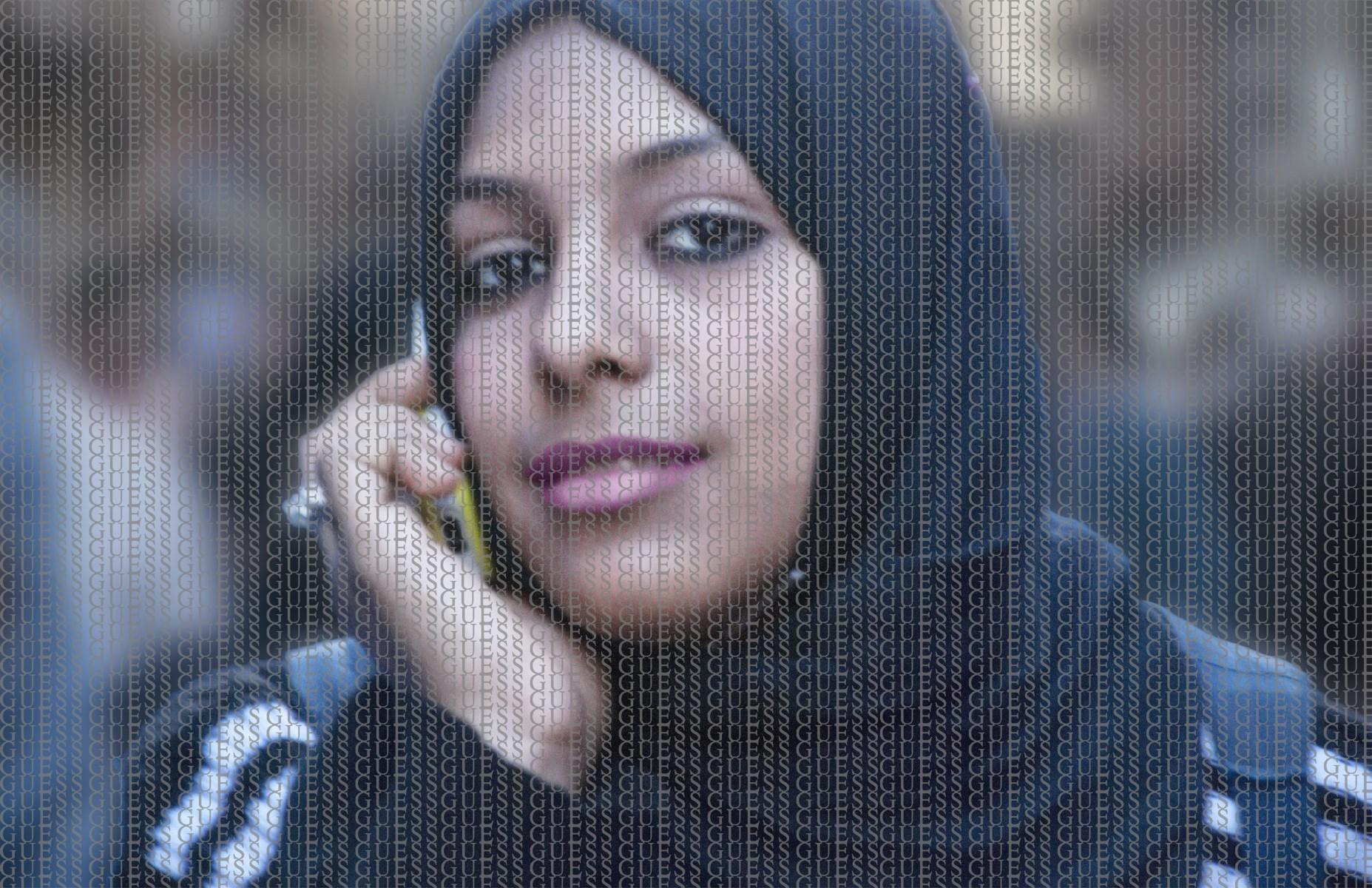
53
Judy Gelles. Guess. 2011. Archival inkjet print. 17 x 11 inches. *
Open windows in a Senior community display lives in cubicles of warped time. Their homes are decorated in the style of the 1960s 1980s. TVs are tuned in to game shows of decades past. Some still have rotary dial phones. The most glaring factor is that they are so alone. When do you stop living in the present? Are your memories interesting enough to carry you through your old age? How will you be remembered, if you are remembered at all? I feel compelled to validate and preserve their existence in photographs.
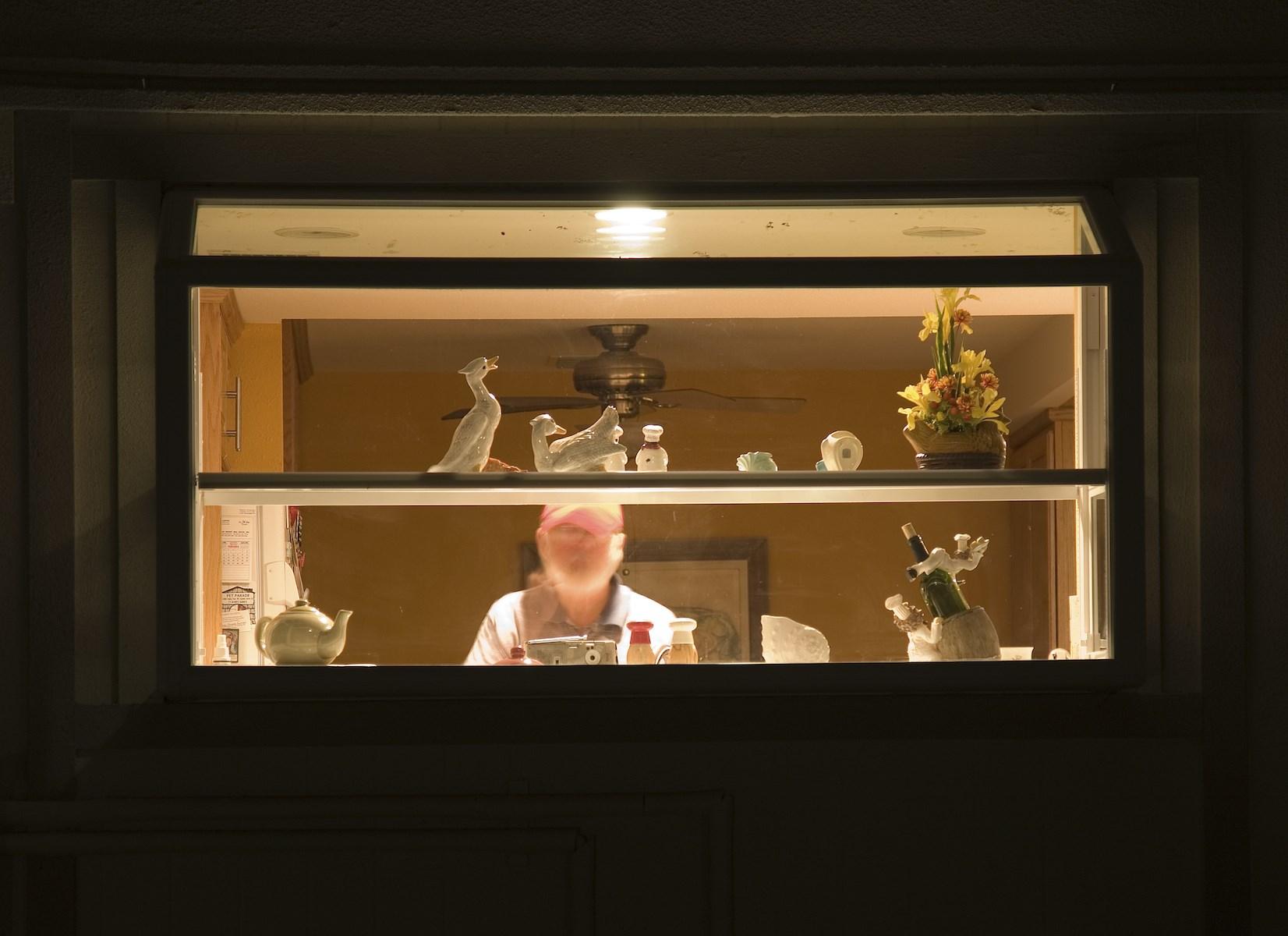
54
Gina Genis. Ceramic Ducks. 2008. C Print face mounted to acrylic. 29 x 40 inches.
I dream of a made-up, recreated world, where everything is coated in feminine fibers. I dream of sinking into panty drawers. I can’t think of a more feminine, loaded, and recognized material to use, display, and play with: angular, patterned, trendy, and shiny. Panties have feminine power, allure, secrets, and identity. Stretching them out of context and use, the viewer plays with their own notions of these intimate garments, picking apart a larger visual framework into its individual components that comprise it.
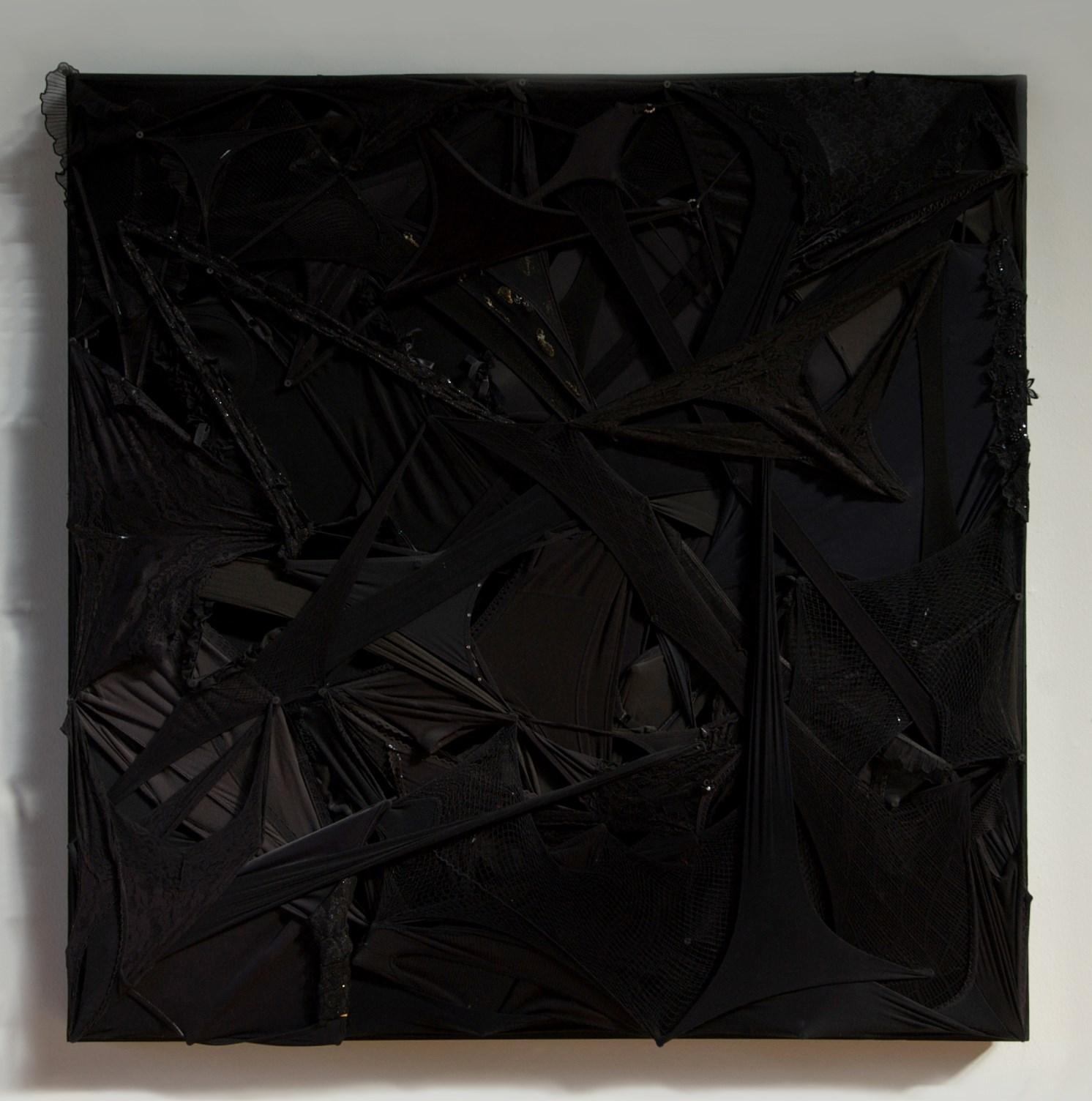
55
Ashley Gibbons. Black Widow 2010. Panties, wood, nails, screws. 48 x 48 x 3 inches. *
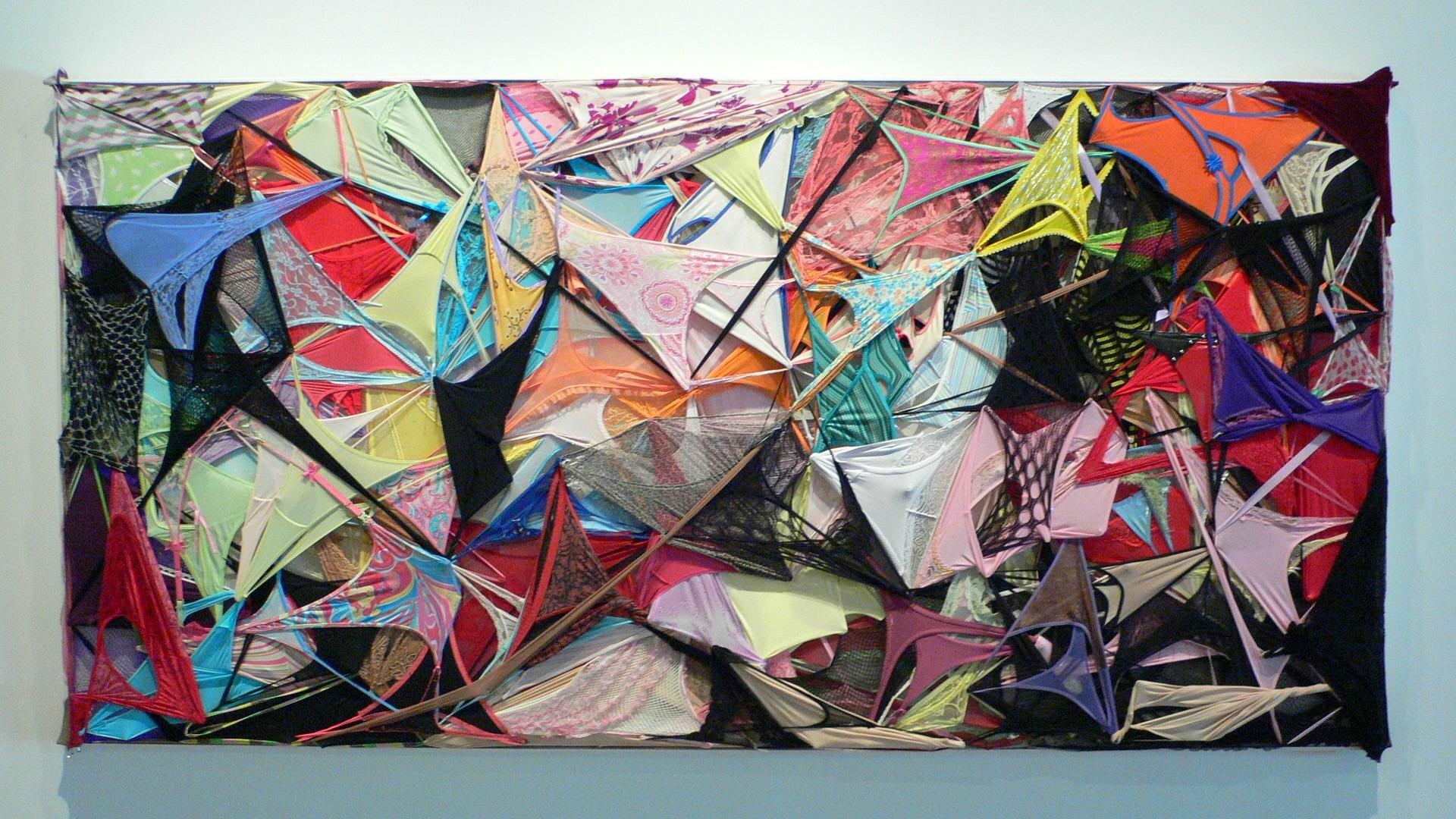
56
Ashley Gibbons. Action Panties. 2010. Panties, lingerie, wood, nails, screws. 48 x 96 x 3 inches.
susan c gregory. Crib Passing. 2011. Encaustic, oil and carbon transfer on wood. 30 x 40 inches. *
As I age and as I parent, I see the recycling of youth through the eyes of motherhood. The forward trajectory of time is personified in the daily physical changes and intellectual revelations witnessed in this new person. Seeing his wonder and innocence, I also realize the gift or tragedy we carry in the memories of childhood. These works use wax painting and carbon imagery to reflect on the passing of years through generations. Respecting this momentum, I see the commonality of humanity and the empathy we must share.

57
Women have led and been part of so many struggles in the last century; it is the momentum that often pushes me forward. I am inspired by those who have gone before me, their initiative and drive, their courage and persistence. With this four-page flexagon (including its two secret pages), I honor them.

58
C.J. Grossman. International Women’s Day. 2011. Paper. 8 x 4 inches.
Anitra Haendel. Cleaning My Own Head. 2011. Oil paint, ink and coffee grinds on linen. 37 x 46 inches. *
The creation of personal imagery made with, arguably, the world’s most important commodity is a method by which I investigate my relationship with global consumerism and responsibility. The use of oil, combined with the use of coffee, changes the context of the meaning of “head cleaning” and moves it from solely self-reflective to engaged with our everyday participation in the mechanisms of industry.
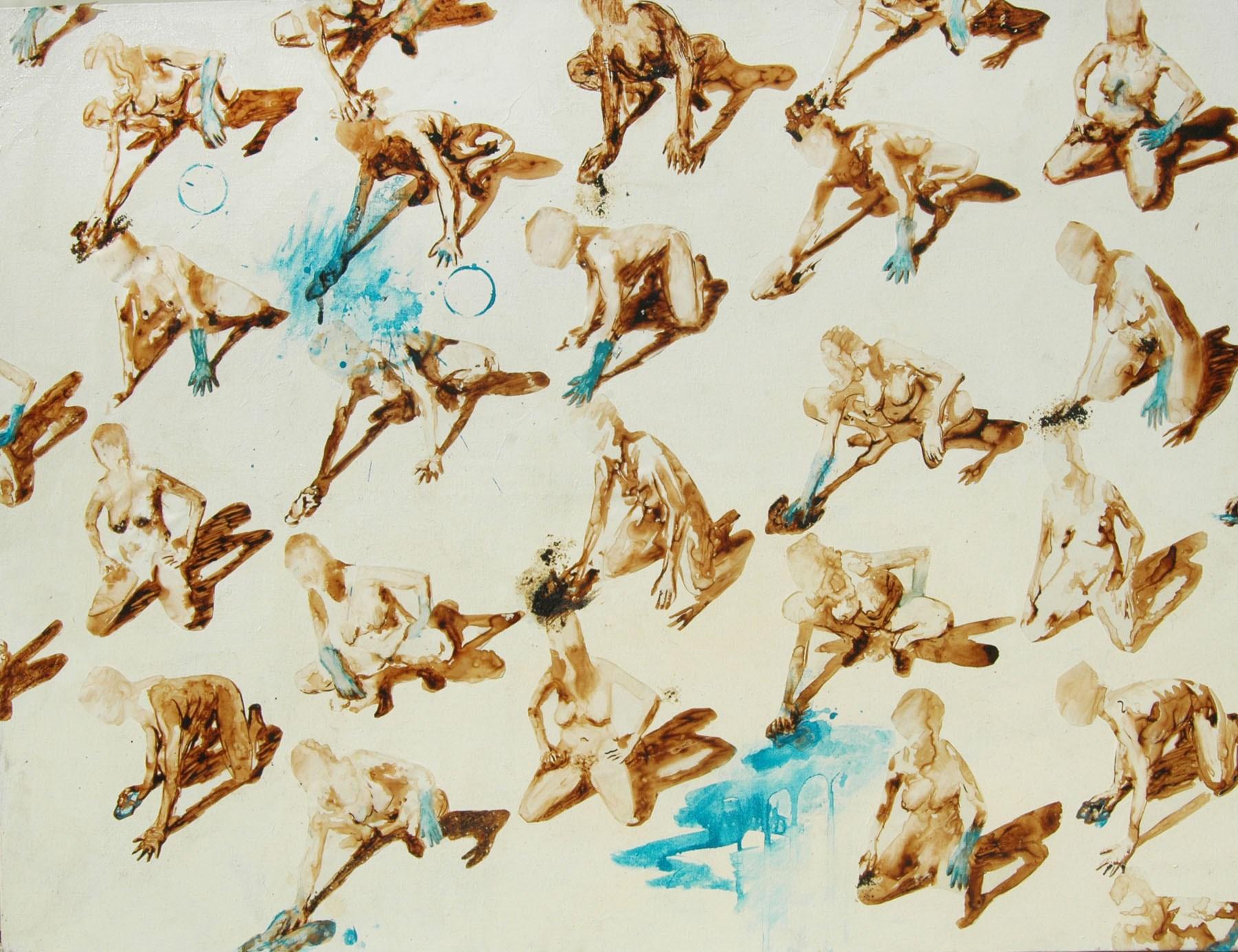
59
Anitra Haendel. Dot Dash Dot. 2011. Oil paint, ink and metal paint tubes on linen. 37 x 45 inches.
Painting, like morse code, is a language which transmits information.

60
For me, the most important issue to make images about today is the environmental one. These frank figures staring out at you are at a standstill. Confronted with some sort of mess, they don’t know what to do, the task of cleaning up can be so great. The first step is to start at home, with oneself first. I use my own naked body as model for my pictures.

61
Anitra Haendel. Drawing the Line, in Vegetable Green. 2011. Oil paint, ink and coffee grinds on linen. 20 x 24 inches.
Addressing the unvoiced traumas implicit in our social contracts, my work aims at the connection between daily life and the fascinating and repellent horrors we read of in the news. I insist on discussing this unresolved tension by enlarging it, implicating the audience and forcing their acknowledgement. Examining post-feminist theory through a lens of productive perversity, my work functions in the overlapping areas of sexuality, gender, and hegemony topics that remain of the utmost relevance despite generational apathy.

62
Kate Hampel. Self-Portrait: Lying. 2011. Printed cotton fabric, rock salt. 62 x 18 x 4 inches. *
While a name is a cosmic prison, identity is its guardian. As a Romanian immigrant to the United States, I live in and between two diametrically opposed cultures; from a totalitarian regime to a society in which individuality and information are emphasized. I often dwell upon the relationship of my identity to my displacement, and the ways I have devised to reconcile these incongruous elements. To translate this dilemma formally, my current body of work tackles the dichotomy between containment and liberation by infusing a static diagram with a charge that propels it into motion.

63
Emanuela Harris-Sintamarian. Map to get oneself lost. Gouache, ink on paper. 70 x 138 inches.
Transformers II riffs on models as power toys armored, slick, accessorized, and deployed with identities constructed from the pages of magazines. My appropriation and re-arrangements of these mediated images, echoes their ubiquitous presence and growing function, as icons of power. These representations of archetypes are beyond attainment and as such perpetuate a kind of distracted longing that cannot be satisfied. The cult of the individual has become the cult of emulation and women must be not only beautiful but desirable, hot and well accessorized.

64
Paula Henderson. Transformers II. 2011. Acrylic on canvas with grommets. 42 x 36 inches. *
Appearances I simulates the power of ancient Eastern deity figures with contemporary fashion icons to question what it means to engage in contemporary fashion in the light of the momentum gained by the feminist movement.
Have current views of beauty, so thoroughly conflated with notions of desire, power, lifestyle, and celebrity distracted the construction of our personal narratives? Might we, in fact, embrace our own objectification, even with a surfeit of evidence that we are not yet fully emancipated throughout the world?
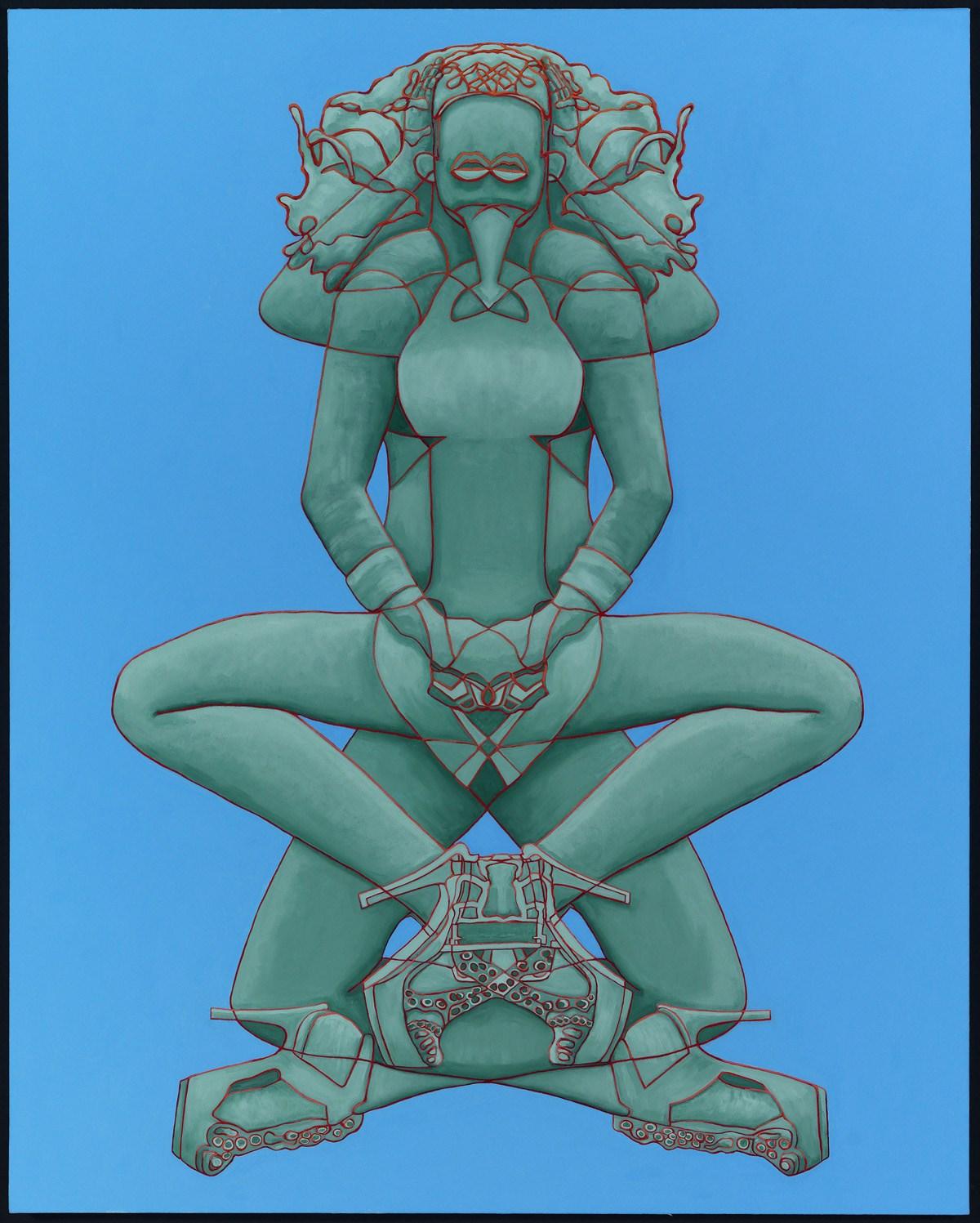
65
Paula Henderson. Appearances I. 2011. Oil and wax on canvas. 60 x 48 x 2 inches.
My perspective has been shaped by personal familial reactions and scars from the JapaneseAmerican immigration and wartime incarceration experiences. Influencing how I was raised, their experiences inform what I convey through my art. Reflecting back and unearthing this history aids in my momentum to move forward to address present day injustices. Using traditional Japanese calligraphy materials applied in an untraditional manner, I transmit latent and denied information surrounding past and continuing issues of injustice.
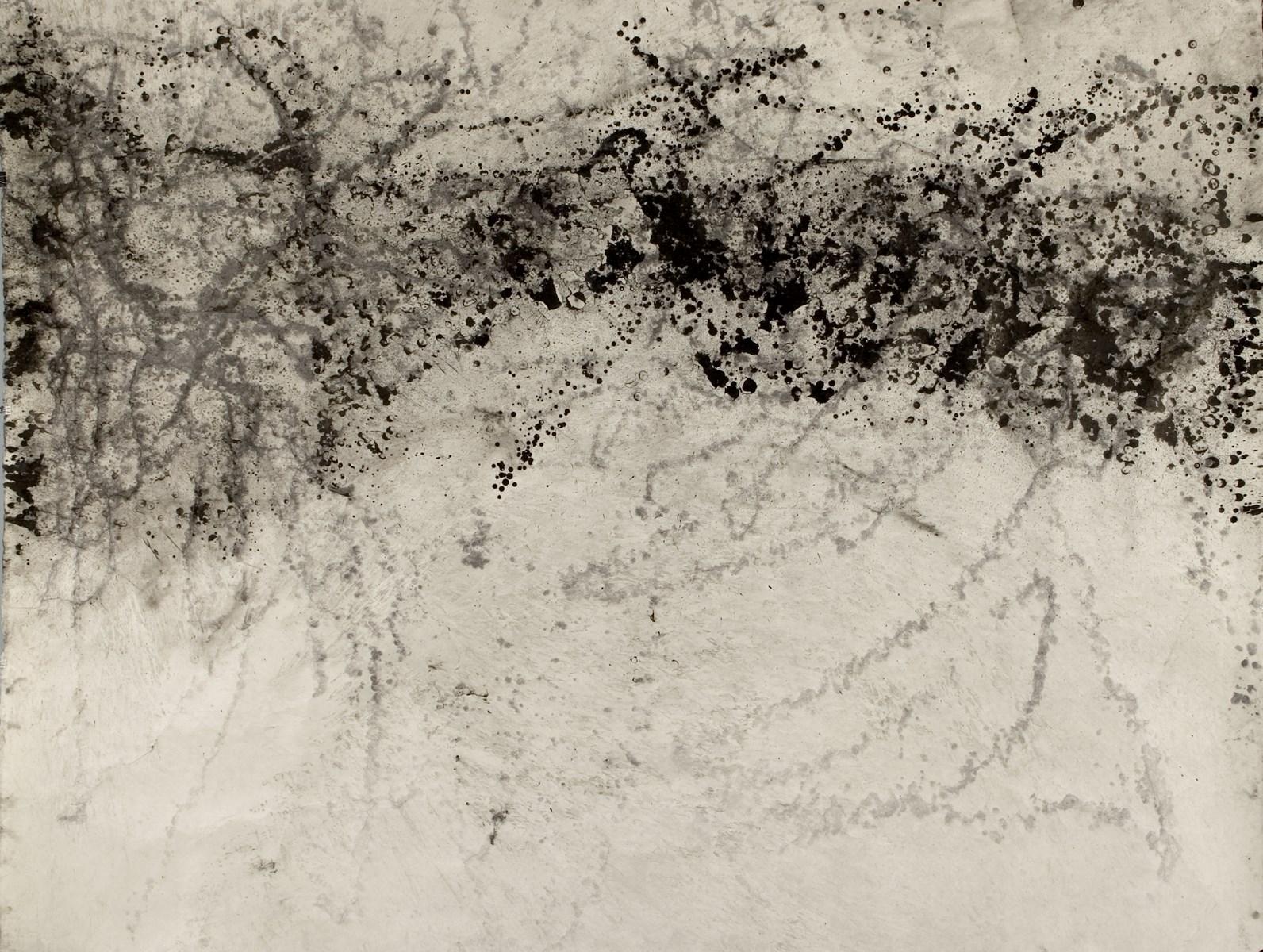
66
Barbara Horiuchi. Descending. 2008. Sumi ink on handmade Iwano paper. 83.5 x 107.5 inches.
Detached from expected presentations, my work is empowered by cultural associations to materials and iconography. Poetic intersections between these forms create dialectical, contextual space for viewers to experience. As viewers perceive their place in relation to this outside dynamic, they can reflect on their own human nature through physical realms as well. If viewers can gain a new perspective or understanding from engaging in my work, perhaps some of their own conflicts can be internally reconsidered.

67
Stacy Isenbarger. Gothic Fiber. 2009. Screen-print on hand-cut curtain fabric. 22 x 30 x 2 inches. *
Detached from expected presentations, my work is empowered by cultural associations to materials and iconography. Poetic intersections between these forms create dialectical, contextual space for viewers to experience. As viewers perceive their place in relation to this outside dynamic, they can reflect on their own human nature through physical realms as well. If viewers can gain a new perspective or understanding from engaging in my work, perhaps some of their own conflicts can be internally reconsidered.
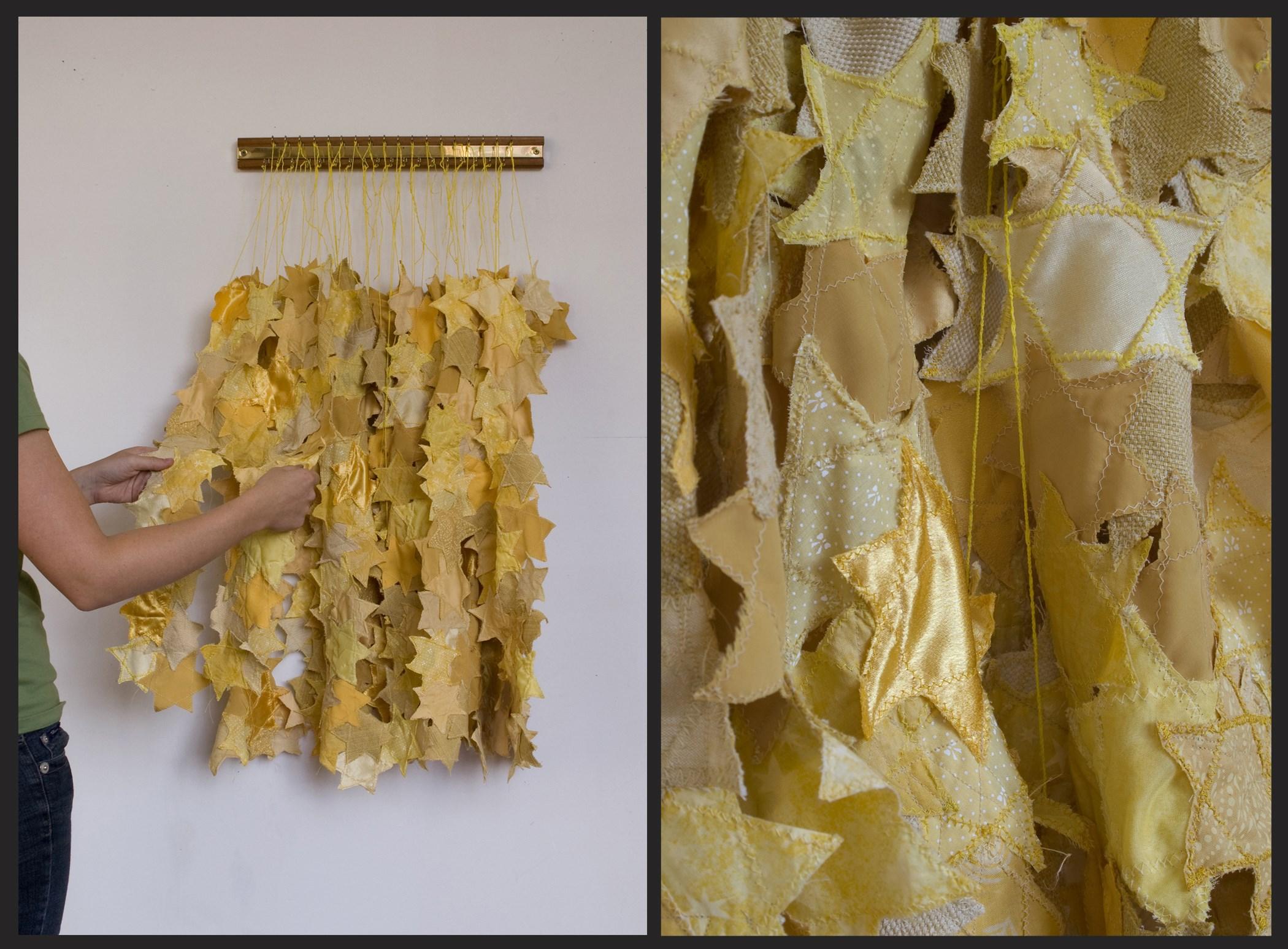
68
Stacy Isenbarger. I-M-M-I-G-R-A-N-T (Non-Holocaust Status). 2010. Various fabrics, string, and tie hanger. 20 x 38 x 4.5 inches.
The color photographs in “My days of losing words” are synthetic visual memories, stand-ins for parts of my life I have lost to chronic illness. This is my way of deconstructing, and reconstructing, my experience with anomia losing words -a side effect of a medicine I was put on for chronic migraine, and with illness in general. In staging images in domestic and medical spaces that both represent memory and illness, I explore how my memory and illness are intertwined. The one-word titles refer to words I lost to anomia.

69
Rachael Jablo. Anticipation. 2011. Analog c-print. 20 x 24 inches.
Each section corresponds to a room from the original Womenhouse, where reference materials were available and imaginary where there's nothing left but written descriptions. I was shocked by how much of our history as protesting women has been lost and wanted to update and bring younger women into the vibrant history.

70
Judy Johnson-Williams. Womenhouse Playhouse. 2010. Cardboard, paper tape, colored pencil. 42 x 87 inches. *
This piece is in response to a Nancy Spero, who said ‘the art world should join us, not we join it’, and so thinking about how ‘herstory’ would be different if men had really shared in the work traditionally assigned to women, just as women are really sharing in earning the income. I chose historic and iconic figures to do the child rearing, nursing, cooking and cleaning. This piece is also a long banner that is shown low on the wall.

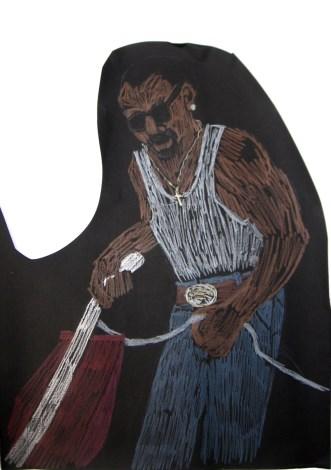

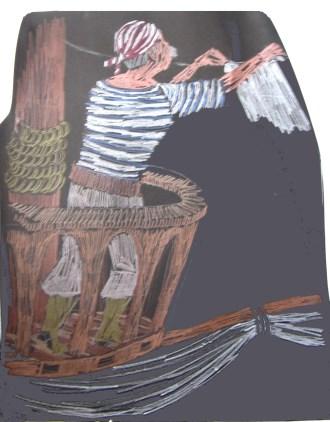
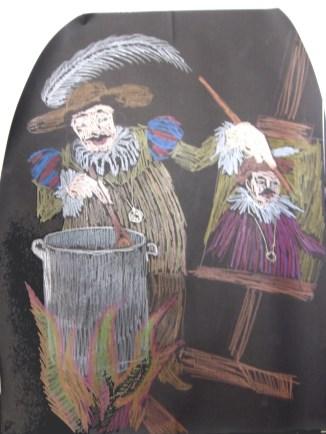

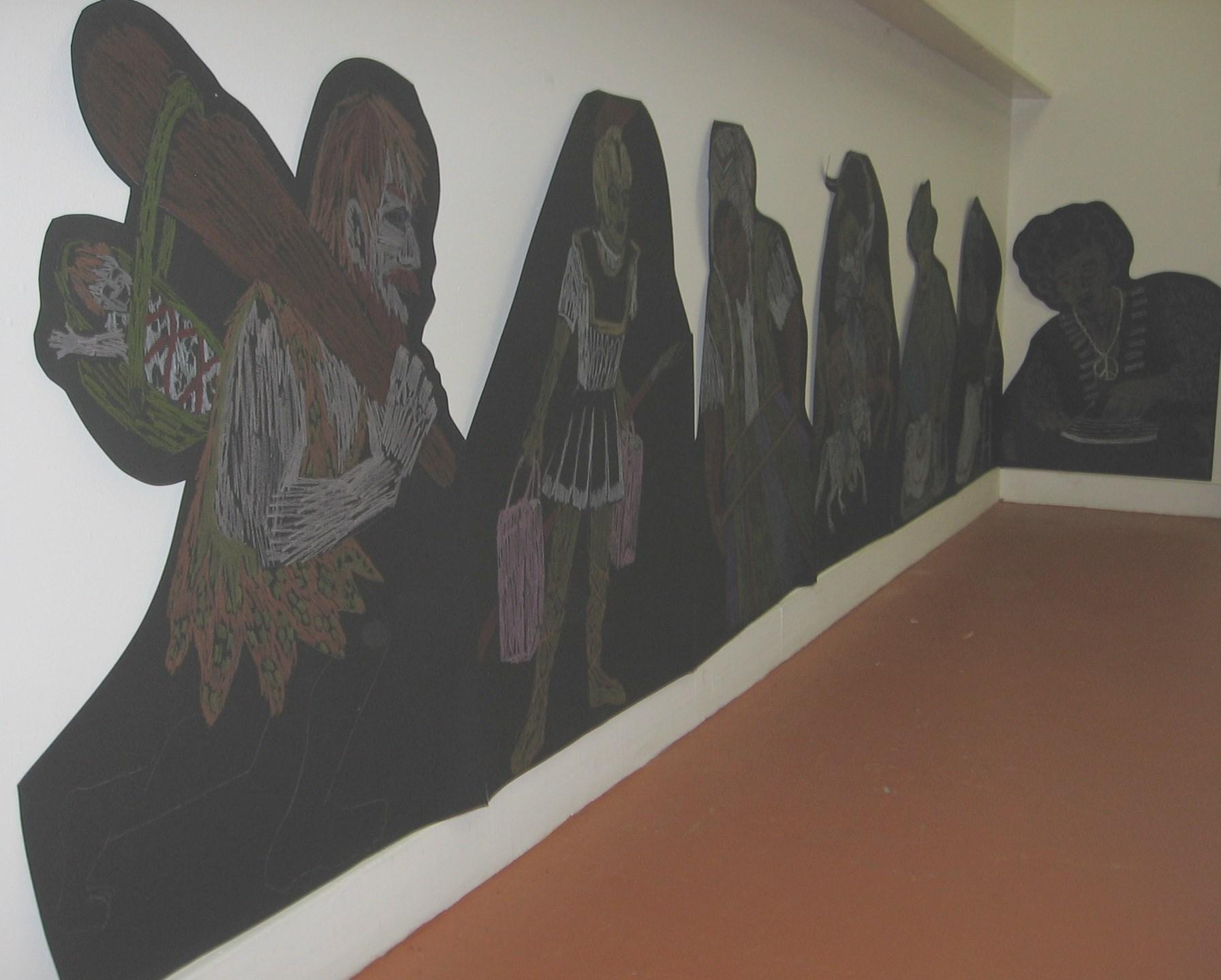
71
Judy Johnson-Williams. Thanks Nancy Spero. 2010. Black paper, colored paper, contact paper. 36 x 28 feet.
*
Dear Jacks is a fictitious love letter from Lee Krasner to Jackson Pollock, illustrated with animal characterizations of people discussed in the letter. The text originated as emails between the artist and her partner, Marlene Hoeber. Person, character, history, identity, and the art world are repurposed, queered, satired, and intentionally misremembered as part of Katz’ continuing work of world-building.
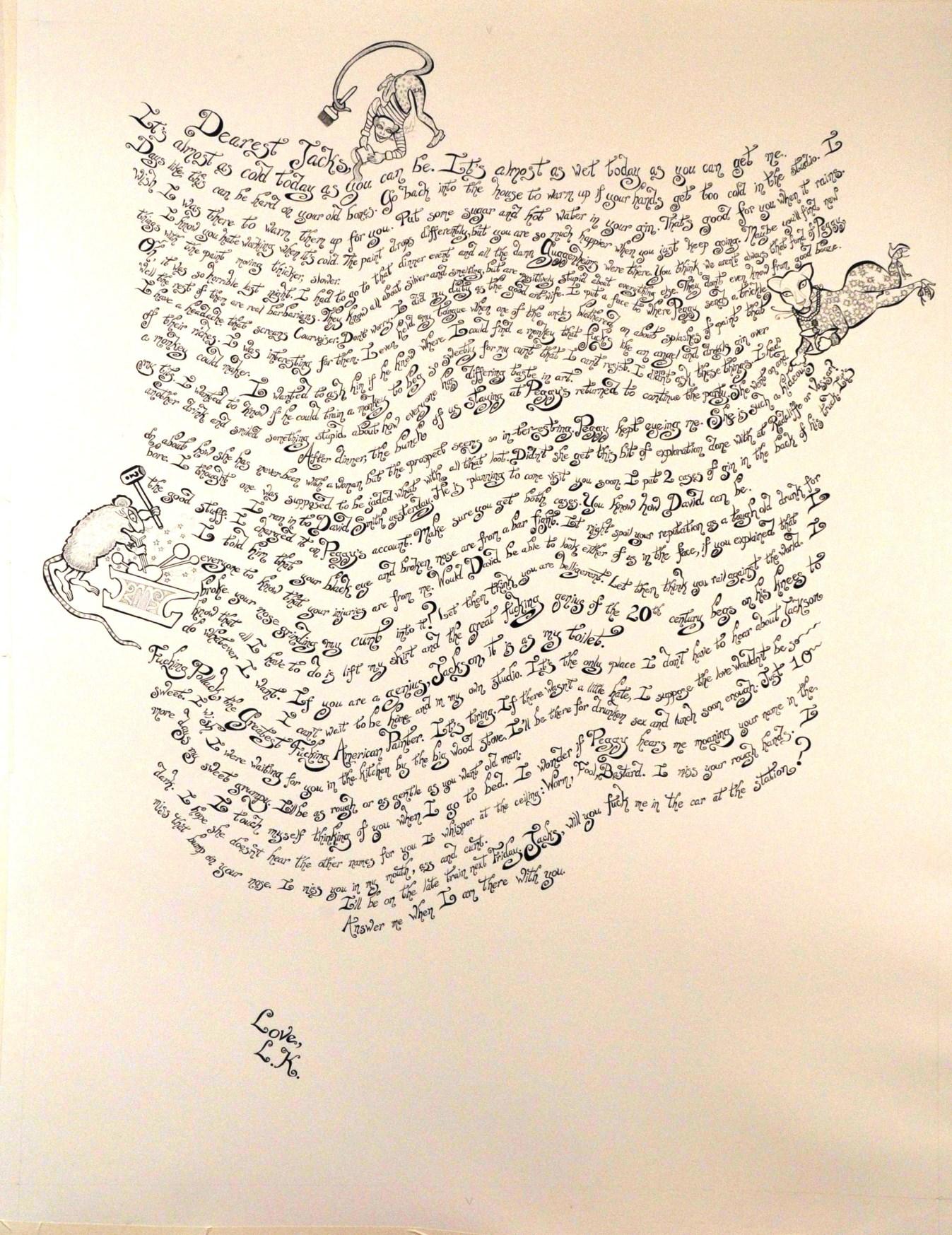
72
Dorian Katz. Dear Jacks. 2011. Ink and paper. 32.5 x 41.5 inches.
I work in sculpture, printmaking, painting and video installation, and am interested in bridging the boundary between these different media, as well as exploring the connection between verbal and visual communication. My work has been strongly influenced by the experience of learning to communicate in another culture and being without words. My most recent work deals with the themes of perception and interpersonal communication. The goal is to create visual representations of inner emotional states with work that provokes an immediate emotional response.
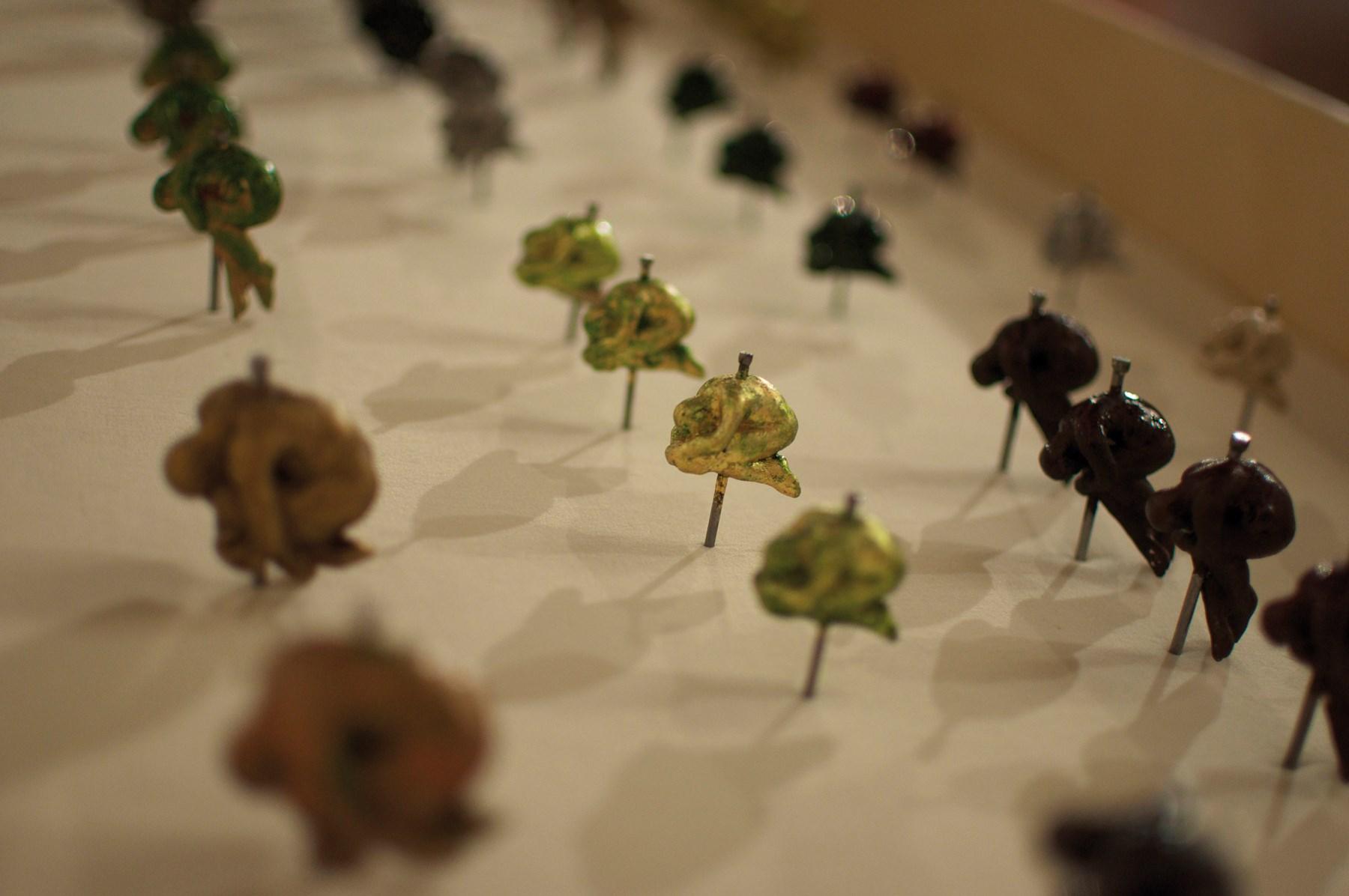
73
Joanna Kidd. Specimens. 2010. Mixed media. 3 cases 19 x 14 x 4 & 1 case 42 x 52 x 22. *
This piece reflects my journey through life as a woman. It is a specific response to the aging process. The inscribed poem is from
by Joyce Kilmer.
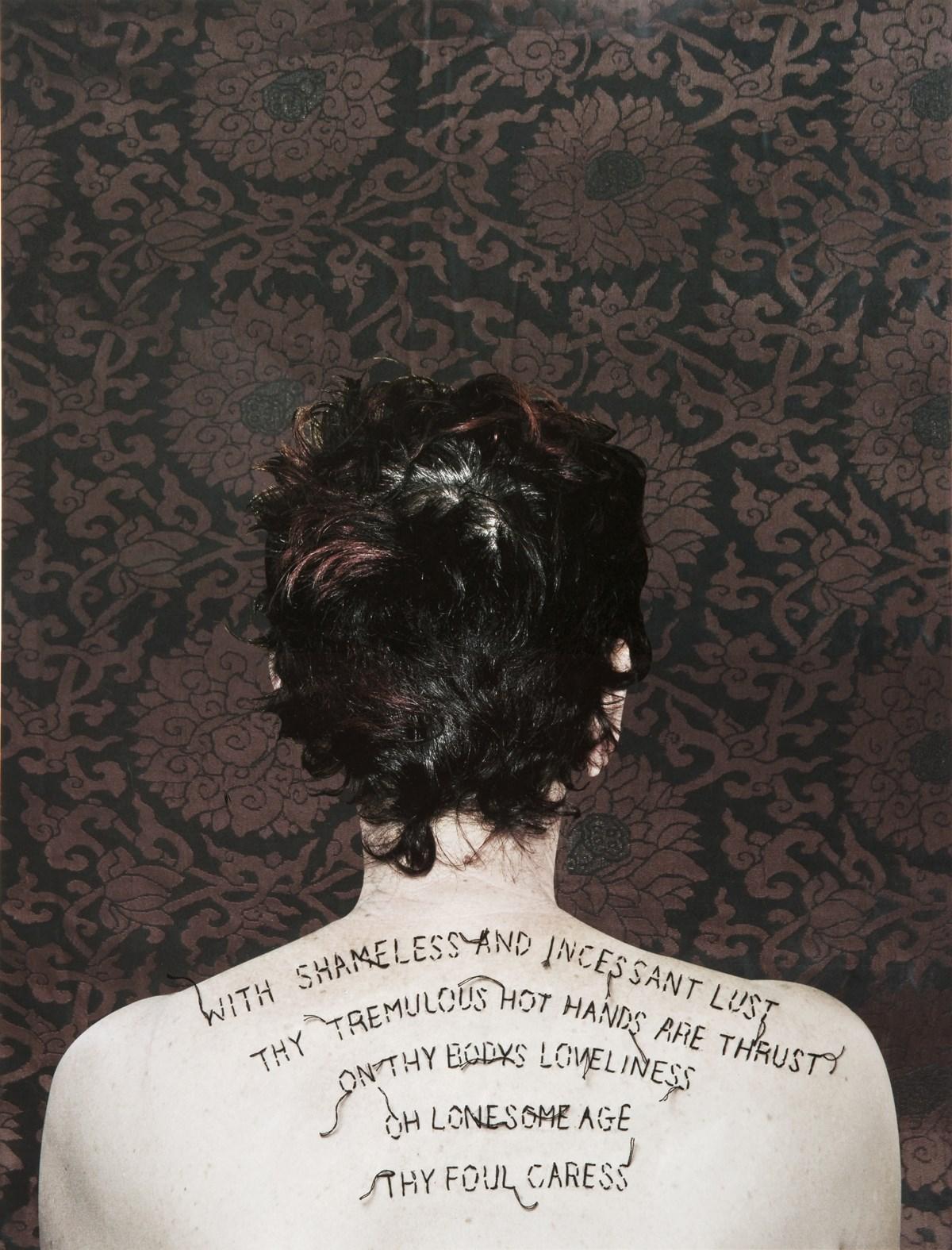
74
Sandra Klein. Caress. 2011. Epson Paper. 22 x 17 inches.
“Age Comes A-Wooing”
Wendy Kveck. How much do you really need? 2009. Oil, acrylic, expanding foam, whipped marshmallow on canvas, fluorescent light and gels. 48 x 60 inches.
To consume or to be consumed? Influenced by early feminist artists, my work filters personal experience and my experience of contemporary culture. I examine and re-present images of women from art history and the media as cultural signifiers of excess and desire, anxiety and fear, regret and loss. Borrowing its text from women’s magazines, “How Much Do You Really Need?” emerged from material-based experimentation with food as paint. Although the painted figure has disappeared, the body remains- indulgent, oozing, fragile, vulnerable to time and the elements. I’m motivated by performance (performing painting, performing our private and public selves) as reflective, reactive, and transformative acts.
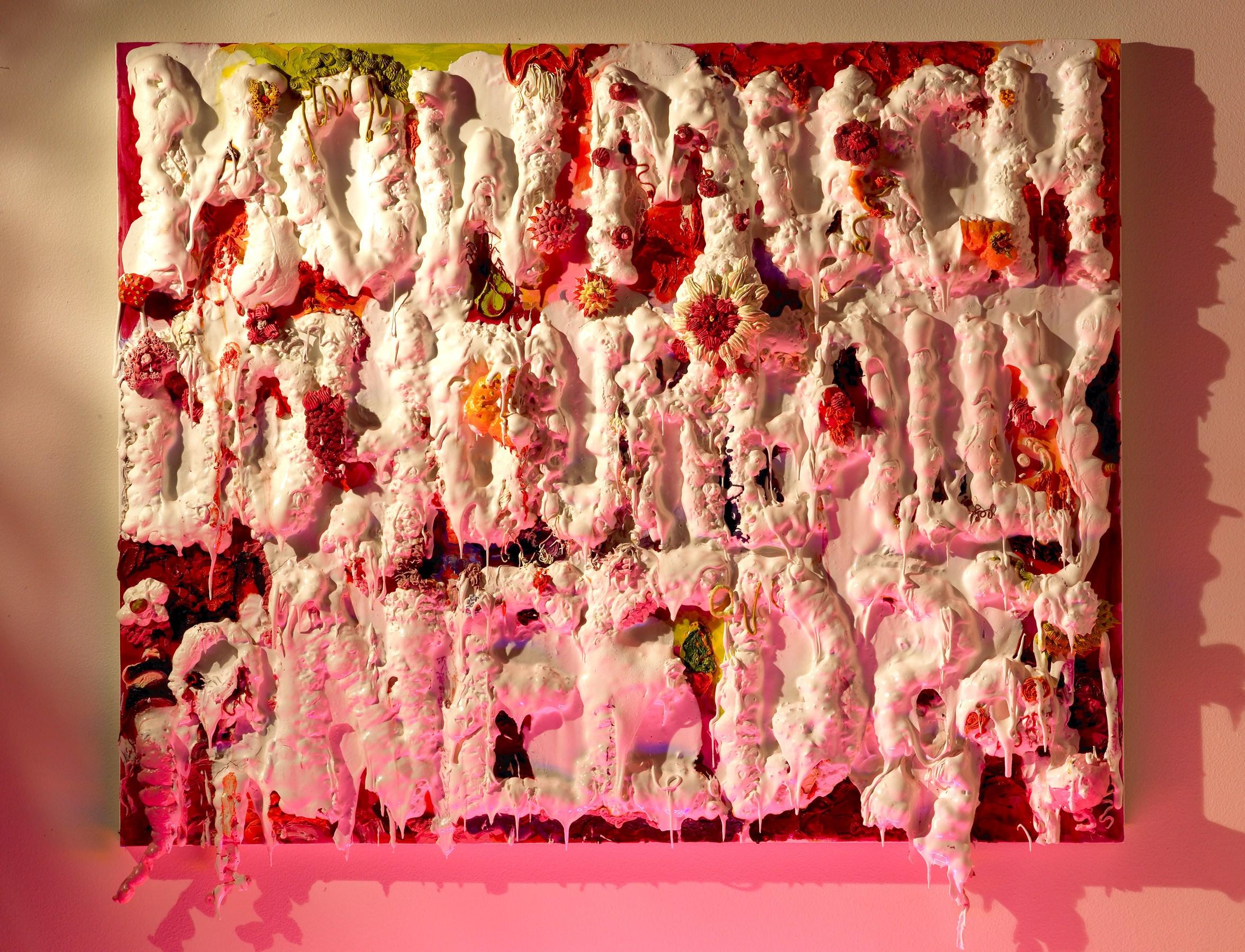
75
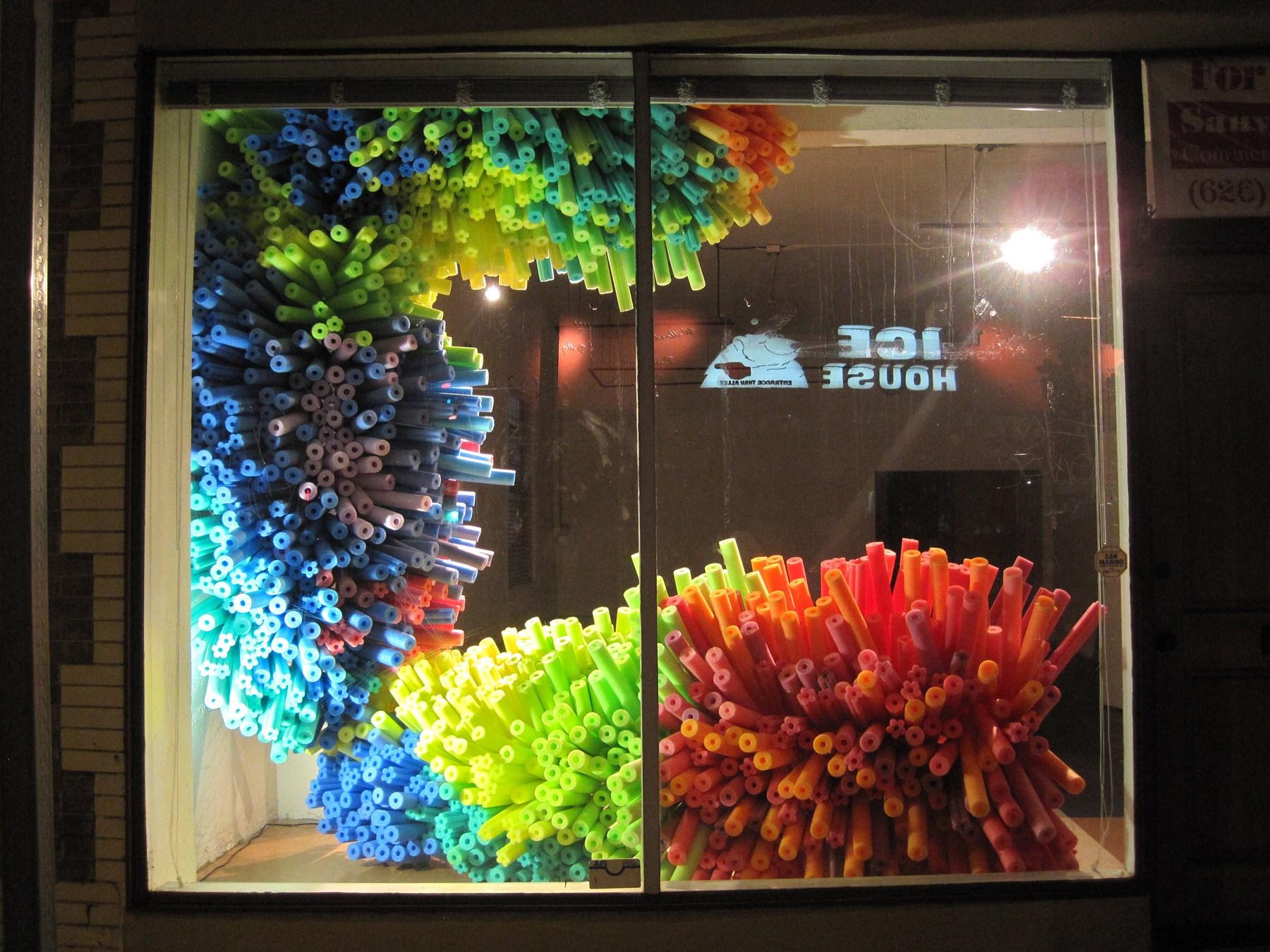
76
Olga Lah. Burst. 2011. Pool noodles. Variable. *
Beth Lakamp. Walking On. 2011. Oil on canvas. 22 x 14 inches.
I simplified the figure in Walking On by removing all objects in the personal surroundings and placing the figure within a geometric area. Simplification and breakdown of area into shapes and dramatic use of heavy outline for varying subjects are found in all my paintings. My inspiration is in Expressionism as well as an early fascination with cardboard cutouts and paper dolls.
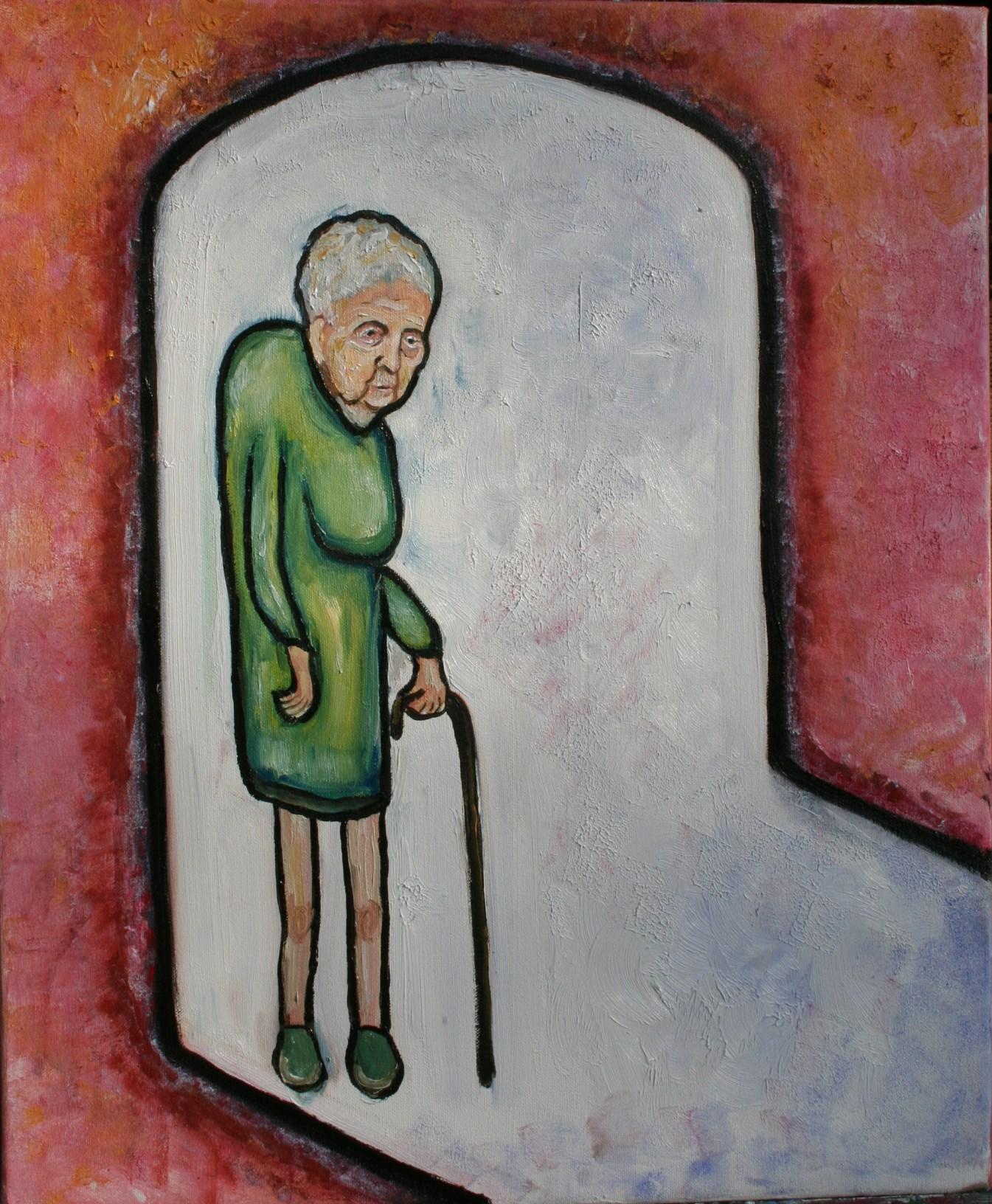
77
Endurance, resilience, strength. I see these characteristics in the lives of my ancestors who never knew the comforts of Modern American Life and I envy them. Like most post-World War II, white, suburban kids, my personal history was forgotten, or erased, and made to look like TV. We sat in classrooms and heard official versions of history that celebrated a select few. We were never encouraged to investigate our own histories or the relationship between our ancestors and those we kept hearing about in school. My momentum is driven by the search for what was lost, i.e. remembering.

78
Joan Laughlin. Pyramid. 2011. Oil on panel. 24 x 36 inches.
My momentum as an artist has been building since the 60s. It is other women artists that have inspired and encouraged me to keep going. In the recent collage works I have focused on technological metaphors of the human experience in the 21st Century. Digital images scanned from motherboards are collaged into patterns that transform them into a new matrix suggesting the potential for a new social order. A place, created in response to the momentum of technological advancement and digital progress.

79
Pat Lay. BA-E-VO-A #2. 2009. Collaged digital images on Epson archival paper, Epson archival ink, with MDF and wood backing. 45 x 57 x 2 inches.
This work has been inspired by movements and shifting landscape and topography of Los Angeles. It also draws upon the natural and urban landscape and includes plant life found on freeway dividers and walls, the ocean, and various Southern California mountains.
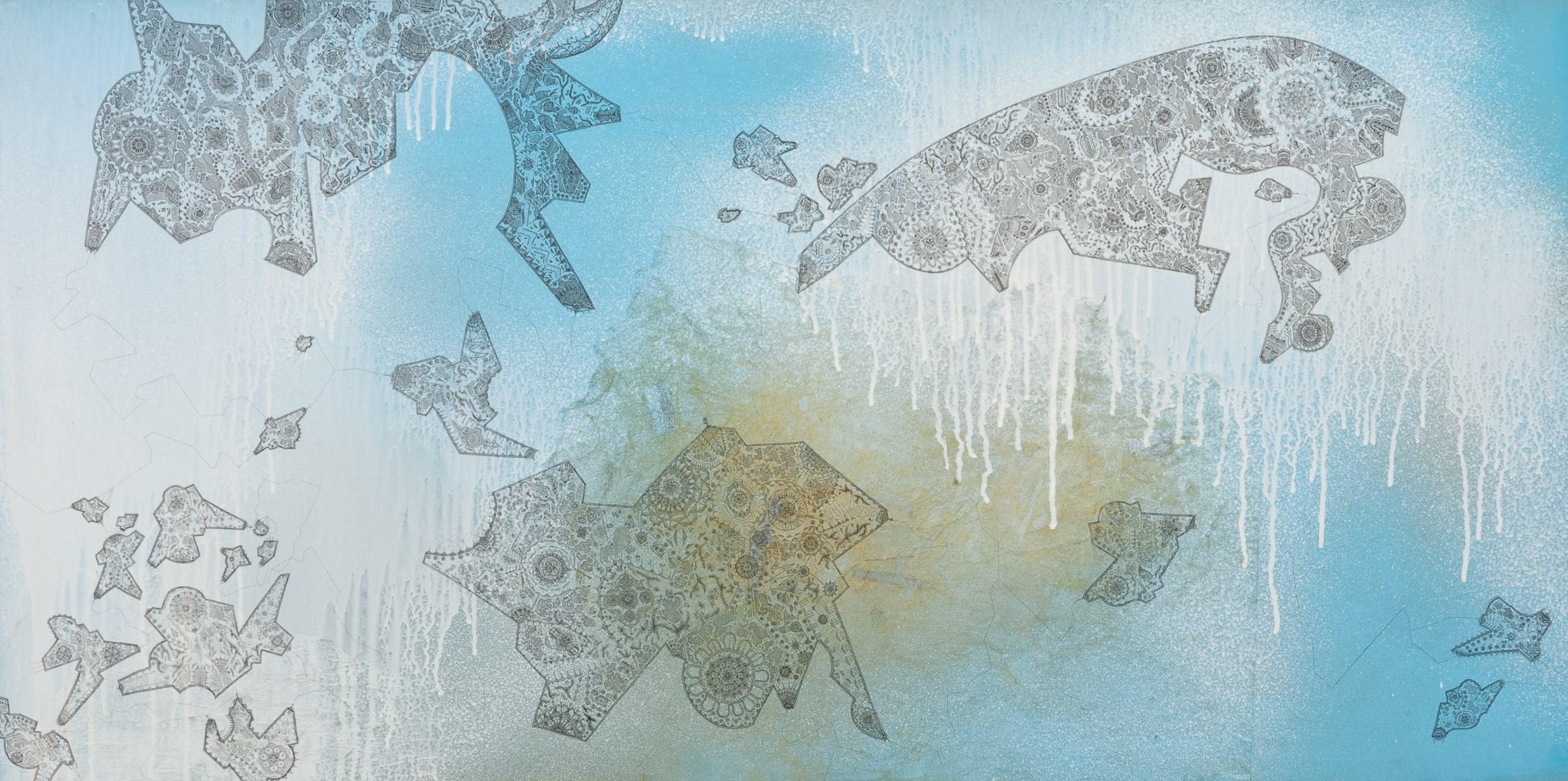
80
Leanne Lee. Development. 2011. Ink on acrylic and rice paper. 30.25 x 54.25 inches. *

81
Leanne Lee. Slipstream. 2011. Latex, enamel, and acrylic on plywood. 37 x 91 x 2 inches.
The Tree of Contemporary Art centers on the feminist art movement, which has produced many great artists. My artwork names female artists in light green leaves with their full names, and male artists in dark green leaves with only their last names. I did this to show the difference. Male artists are known, and represented in galleries and exhibits and receive more money than female artists. There is still a need for more respect and empowerment for women in the arts. Lets keep the momentum going!
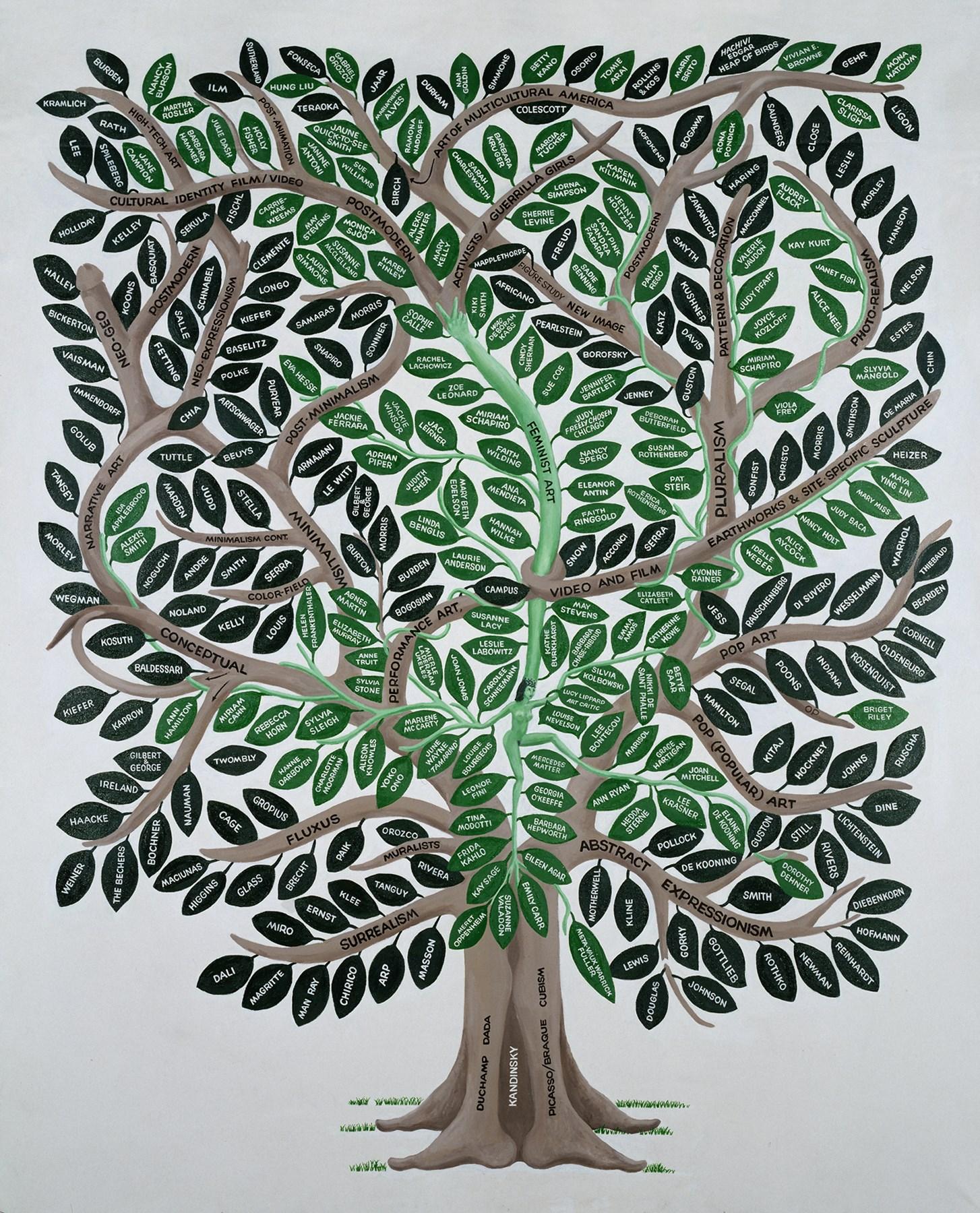
82
Lynn Elliott Letterman. The Tree of Contemporary Art. 1995. Oil on canvas. 72 x 84 x 3.5 inches. *
Eve was responsible for man’s eviction from Paradise and women have been paying the price ever since. Sometimes I call it, “Black and Blue Eve”, because of the verbal abuse women have endured. The Story of Eve features quotes from the bible and other writings. “Her character is gullible, vain and greedy”, “She lacks moral discipline & reasoning skills”, “She is forbidden fruit, femme fatal, and a she-devil”. This is the kind of babble women hear every day. Let’s blame it all on Eve!

83
Lynn Elliott Letterman. The Story of Eve. 2003. Oil on canvas. 87 x 63 x 3.5 inches.
Central to my work is the idea of becoming: a process of self-actualization, and the notion that our selfhood has a narrative unity that supersedes linear time, thus life’s meaning is to be found in the relationships among temporal instances. The realization that I am the person of my own creation is my momentum, a concept so aptly described by Jorge Luis Borges: “Time is a river which sweeps me along, but I am the river.” My work is also inspired by mythology, the “music to which we dance.”
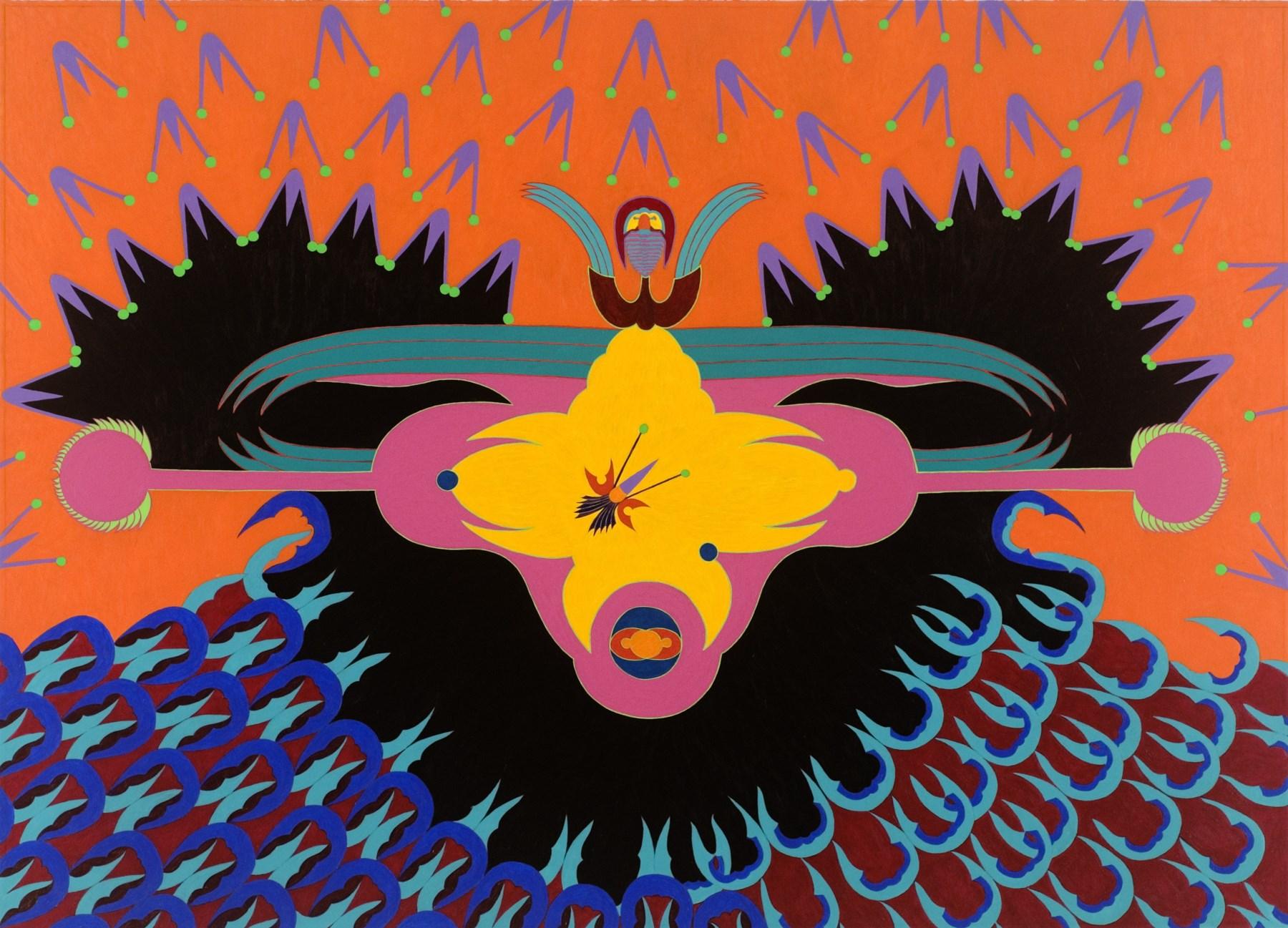
84
Carol Lynn Levine. Everybody's Story 5. 2011. Acrylic paint on matte mylar. 41.5 x 55 x 1 inches. *
My Etichette Series utilizes many famous old style Italian cheese labels. My idea was to recontextualize elements of these labels as motifs in colorful, almost Pop Art collages, which attempt to capture the essence of this passing agrarian world. In order to “nail down” the etichette elements, I use knotted thread in a special stitch that I have used since 1970. I referred to the series using this knot as “Woman’s Work.” I selected my Etichette Series for this forty years Exhibition because I have used this knotted thread stitch for approximately forty years in my different series of my work.
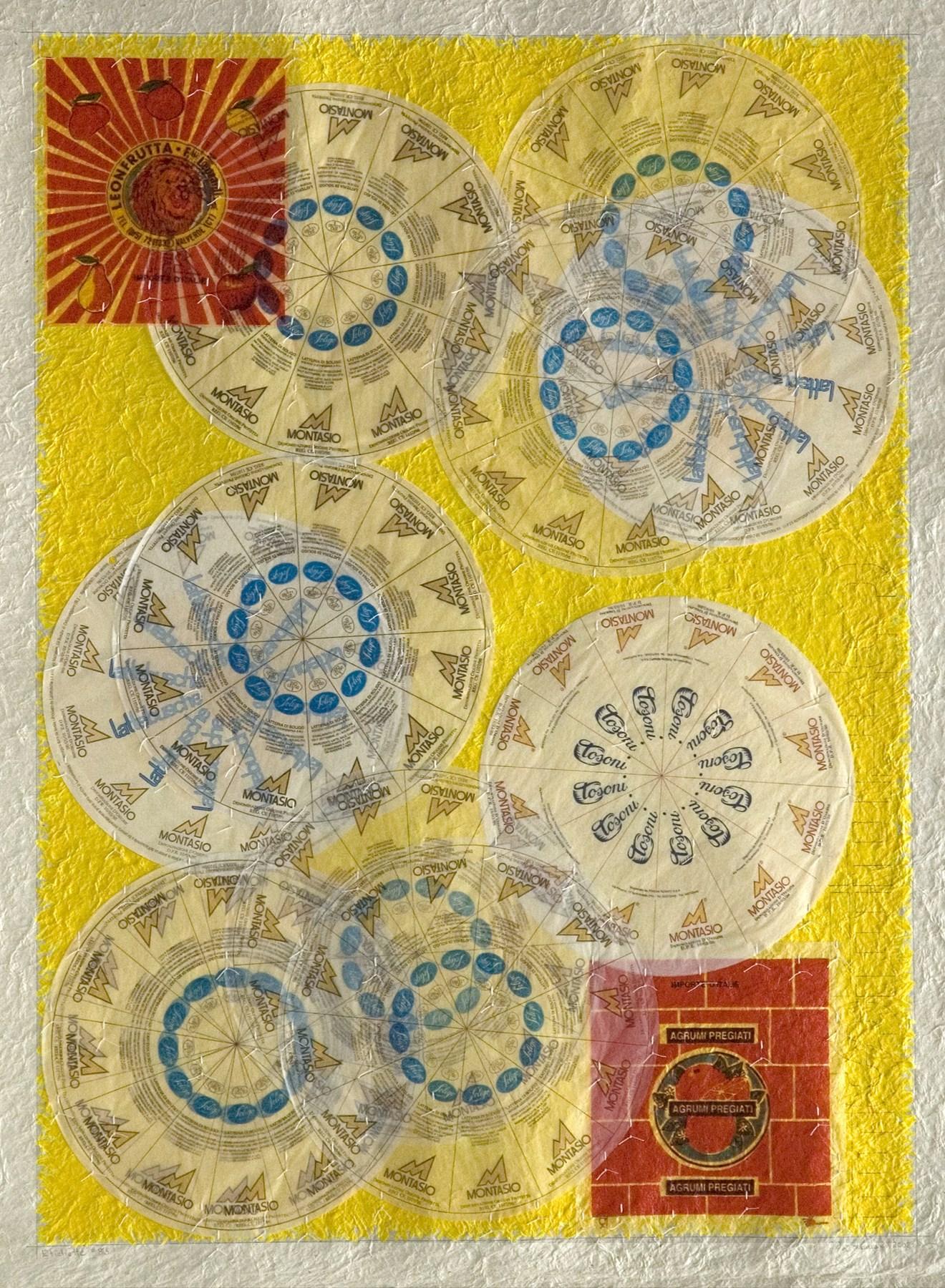
85
J. J. L'Heureux. Etichette #85. 2008. Handmade paper, paint, knotted thread. 49 x 37 x 3 inches.
Jacalyn Lopez Garcia. Life Cycles: Reflections of Change and A New Hope for Future Generations. 2006-2011. Plexiglass mobiles, digital photographs, QR codes and text. 14 feet. Accessible via http://lifecyles.ucr.edu.
Sometimes I feel challenged as an individual born in the United States because I do not always feel completely American. This feeling has a direct impact on the images I create because it causes me to look inward to my own cultural base. In doing so I discover reasons for my life. Hence, my documentary project is intended to conjure up and examine a variety of social and cultural contexts about life cycles, reflections of change, and a new hope for future generations as told from 21st Century Latino perspectives.

86
Marilyn
*
This tongue and cheek feminist work is not the artist experience but rather an artist appropriating a cultural experience. These historical artifacts are portraits of anonymous ladies, portraits of what was expected in a role for them to play. The work Intends to create a multi-layered experience of the real and the imagined, reflection and refraction, the passing of time and movement.
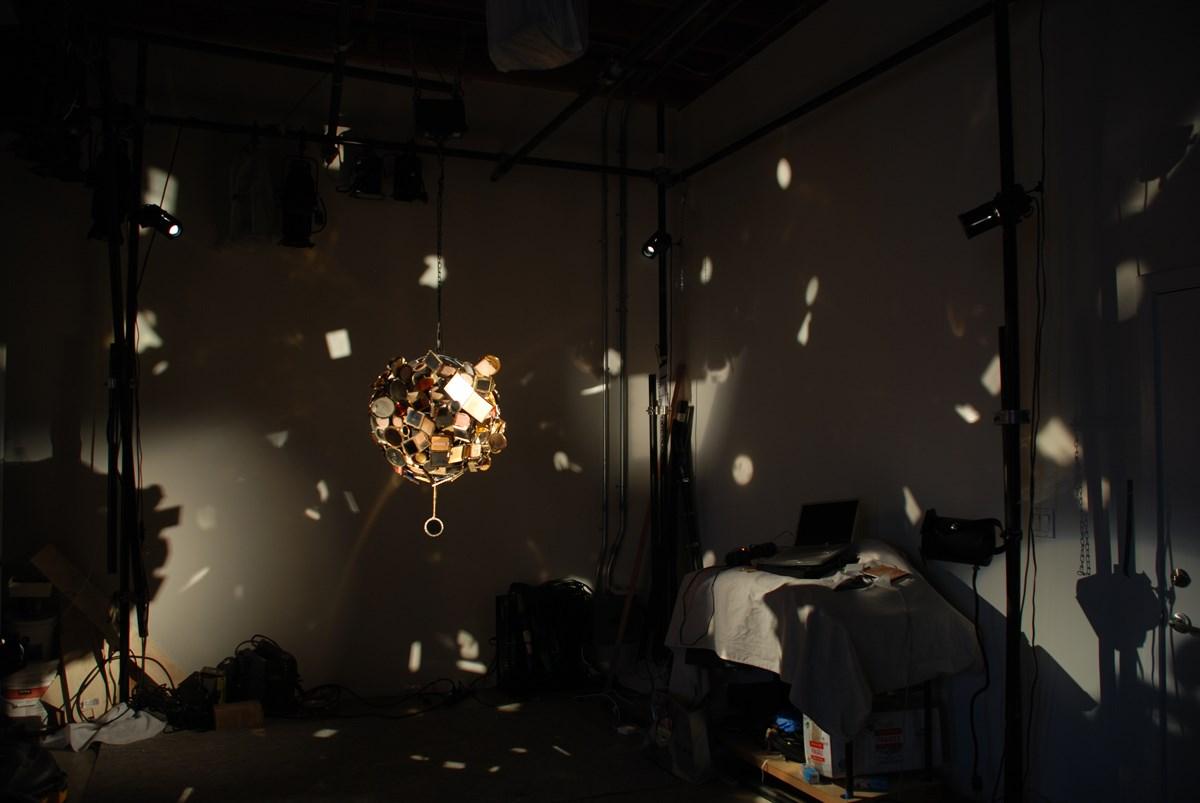
87
Lowey. Here’s To The Ladies Who Lunch. 2011. Metal framed sphere, 132 women’s compacts, jewelry thread, rotating motor, wire cable (#1 of 3 with variations). sphere 28 x 24 x 24 inches, motor 8 x 8 x 4 inches.
Much of my work depicts futuristic landscapes that capture my notion of an ideal place. It’s a notion of timelessness. In many ways what I represented can be seen as fantastical or unrealizable, but my belief is that images have the power to alter conciseness and raise awareness. Therefore my work, which reflects my inner world of emotion is an antidote to pessimism and fear.

88
Li Ma. Baby Animal Dream. 2011. Watercolor, ink and pastel on paper. 30 x 22 inches. *

89
Li Ma. Untitled. 2011. Wood, plastic glass, lighting feature . 24 x 18 inches each.
Fiber is a first sign of civilization and as current as now- a symbol of a perpetual force that both binds us in place and ties us together. I use it to explore liminal space in social strictures, communication and identity. Strictures, symbols, and labels all carry ongoing force that individuals both ride and fight. How do we break free of that momentum to speak with our unique voices, even as we use society’s tools to form the words? We find answers in liminal paradox outside time, suspended in direction without momentum. Identity tapestry lets each participant to mark their identity by linking statements. An single statement can be very simple, but in linking them together each person shows not only themselves, but their relation to others.
See the video at: http://www.marymarch.com/Identity_Tapestry.html
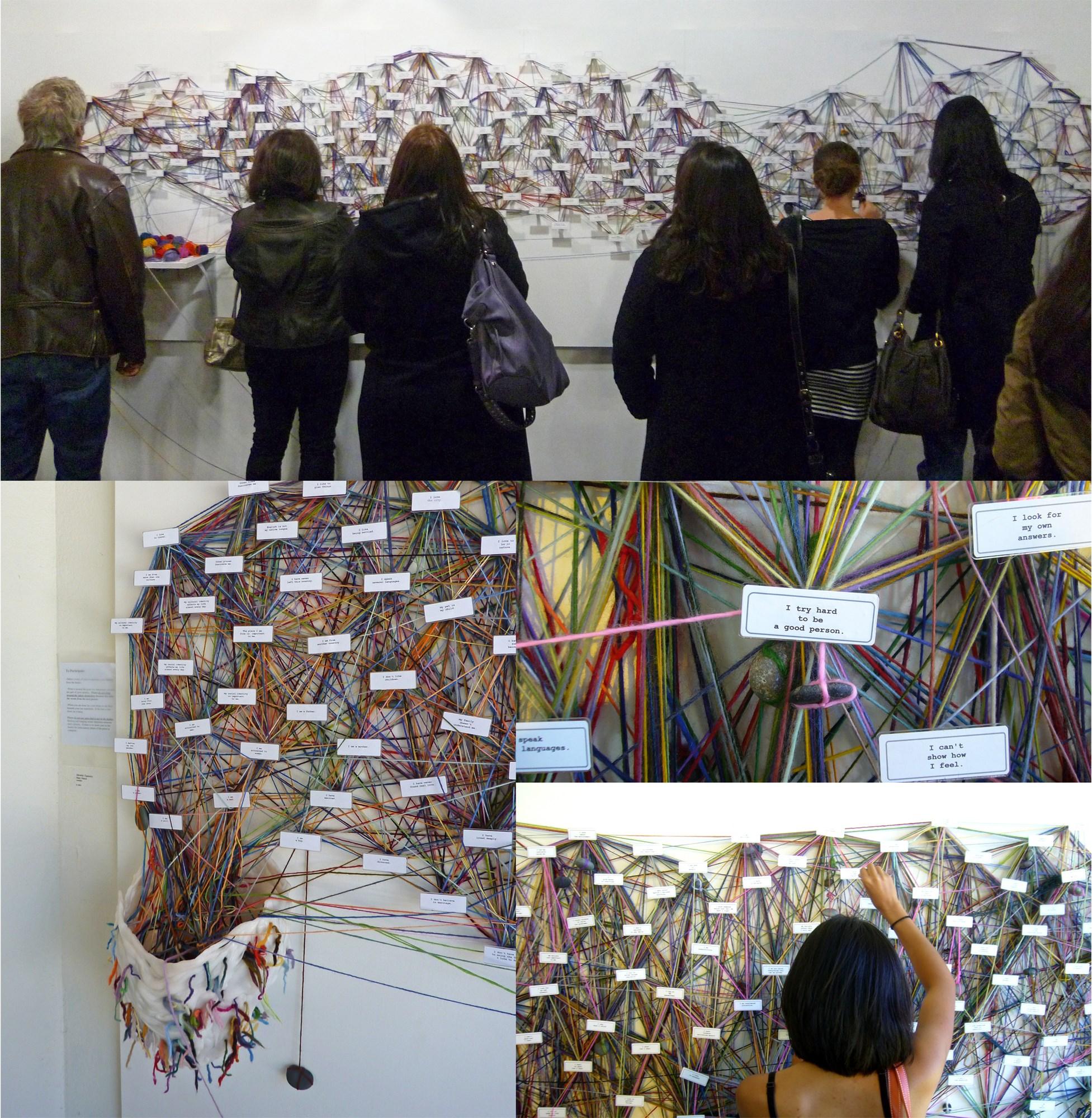
90
Mary Corey March. Identity Tapestry. 2011. Mixed media participatory installation. Dimensions variable (5ft x 1.5ft x 8ft-16ft).
When the first woman soldier was killed in the Iraq war it hit me hard. Women stand next to men in combat and yet no respect is given to us. In response I created “Stereotype” photographing my breasts with my dog tags hanging down between them. It contrasts with the photographs of men we have seen standing with their muscles and the dog tag dangling on their chest. Stenciling the words dyke and whore on my two breasts, addresses the comments I received questioning why would a woman want to go into the service; they must be a whore or dyke. We are in the same military and yet men have all the dignity. We rely on symbolism to express ourselves but not everyone has the same experiences, therefore they have a different emotional attachment toward this photo. This photo is part of my heart and soul because a lot of times in the military I could not express myself and now I can.

91
Karen Mathews. Stereotype. 2007. Digital photography. 18 x 14 inches.
Members of my community, including myself, are a force along a historical and cultural spectrum. Our strength is driven by the weight of multiple oppressions to create momentum in the present towards a future of our own creation. Inspired by pop cultural and historical mythologies, I create visual fictions and futuristic prophecies based on my activism as a queer, multiracial, and AsianAmerican woman. I use my work as a way of realizing a self determined future in the present.
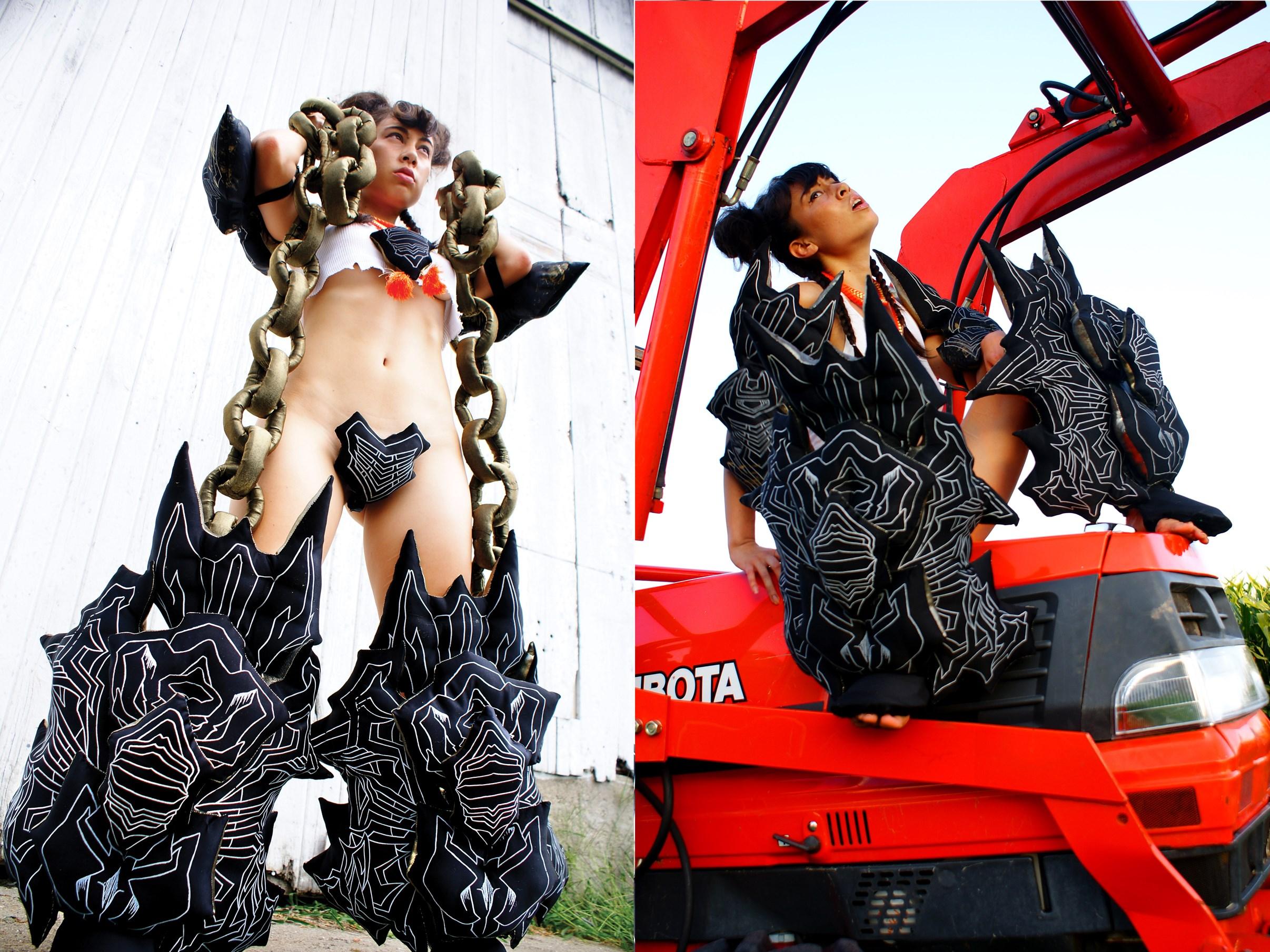
92
Chanel Matsunami Govreau. Queen Gidrea’s Family Armor 2011. Photography, performance, and sculptural serigraphy. 24 x 36 inches.
I’ve studied extensively with Jiro Yonezawa, a Japanese bamboo basket maker and teacher. I became proficient in making Japanese-style baskets. Watercolor paper became my medium of choice after taking a weaving with paper class. I have since combined my knowledge of bamboo techniques with paper. What most attracts me to using paper and paint for weaving is the ability to play with color and pattern. I continue to experiment with various weaving methods and techniques to see where they will take me and the woven form.

93
Dorothy McGuinness. Entering the Interior. 2009. Watercolor paper, acrylic paint. 6 x 9 x 9 inches.
I create portraits and images of people in an altered, dreamlike, and magical way using color, pattern, shape, and texture of paint. I use bright, unrealistic, and skewed combinations of color to show different senses about parts of the body or aspects of the personality. I use the way in which the paint is applied and the touch to transmit an emotion or feeling. My aim is to create a world oscillating between dreams and reality. I pick subjects from reality, altering them into dreamlike images.

94
Katherine McGuire. Man With Flower. 2011. Oil and mixed media on canvas. 30 x 40 inches.
My work is figurative from fragments to whole figures. I focus on the materiality of the female body. The body is a medium of culture. Its sexualized parts like the breasts and buttocks are coded with good and bad connotations. I take those sexualized parts of the female body out of context and present them as solitary and disconnected forms. The isolated and silent body parts of the breast and the buttock communicate to the viewer in a provocative language. They speak about sexism, ageism, eroticism and maternity.
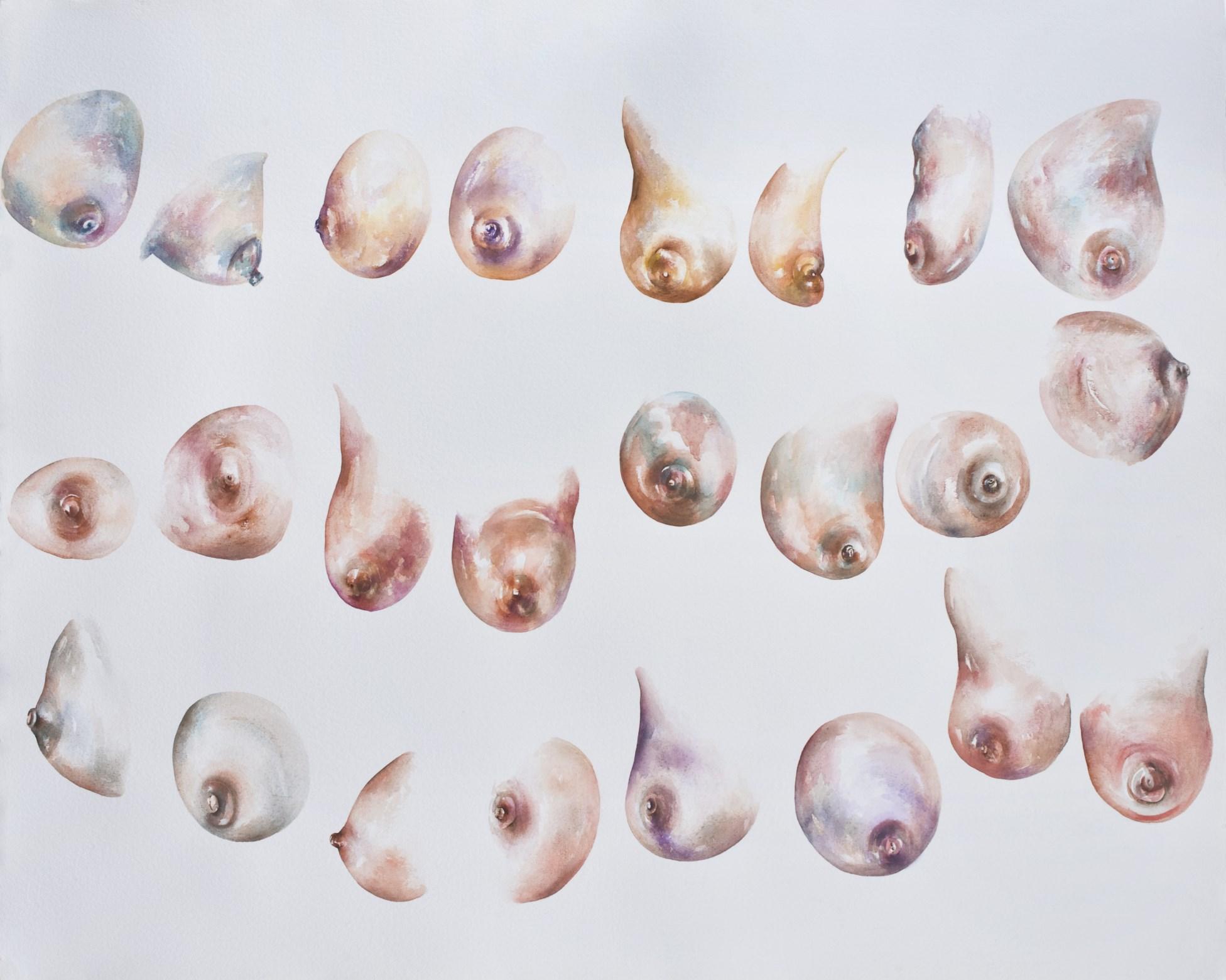
95
Rosemary Meza-DesPlas. 24. 2010. Watercolor on handmade Mexican paper. 44 x 51 inches.
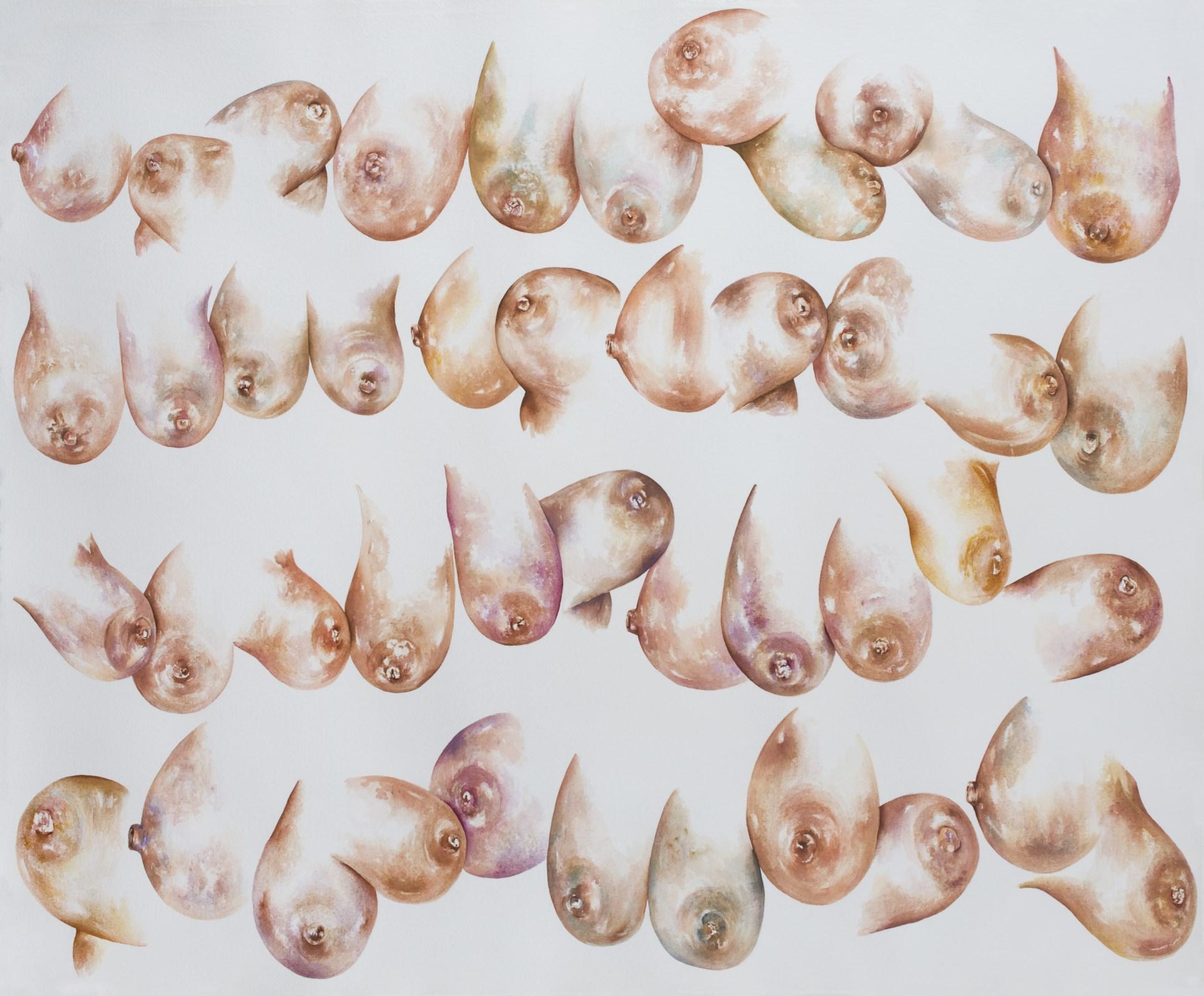
96
Rosemary Meza-DesPlas. 44. 2010. Watercolor on handmade Mexican paper. 44 x 51 inches. *
My art making practice is informed by a concern with perceived beauty. I have created a series of collages that address how the body can be manipulated by this perception. With an emphasis on how the female figure is governed by the context of culture and molded into various forms.

97
Sarah Miska. Kablooey 2011. Paper and adhesive. 17 x 13 x 1.5 inches. *

98
Sarah Miska. Legs and Torso. 2011. Paper and adhesive. 17 x 13 x 1.5 inches. *
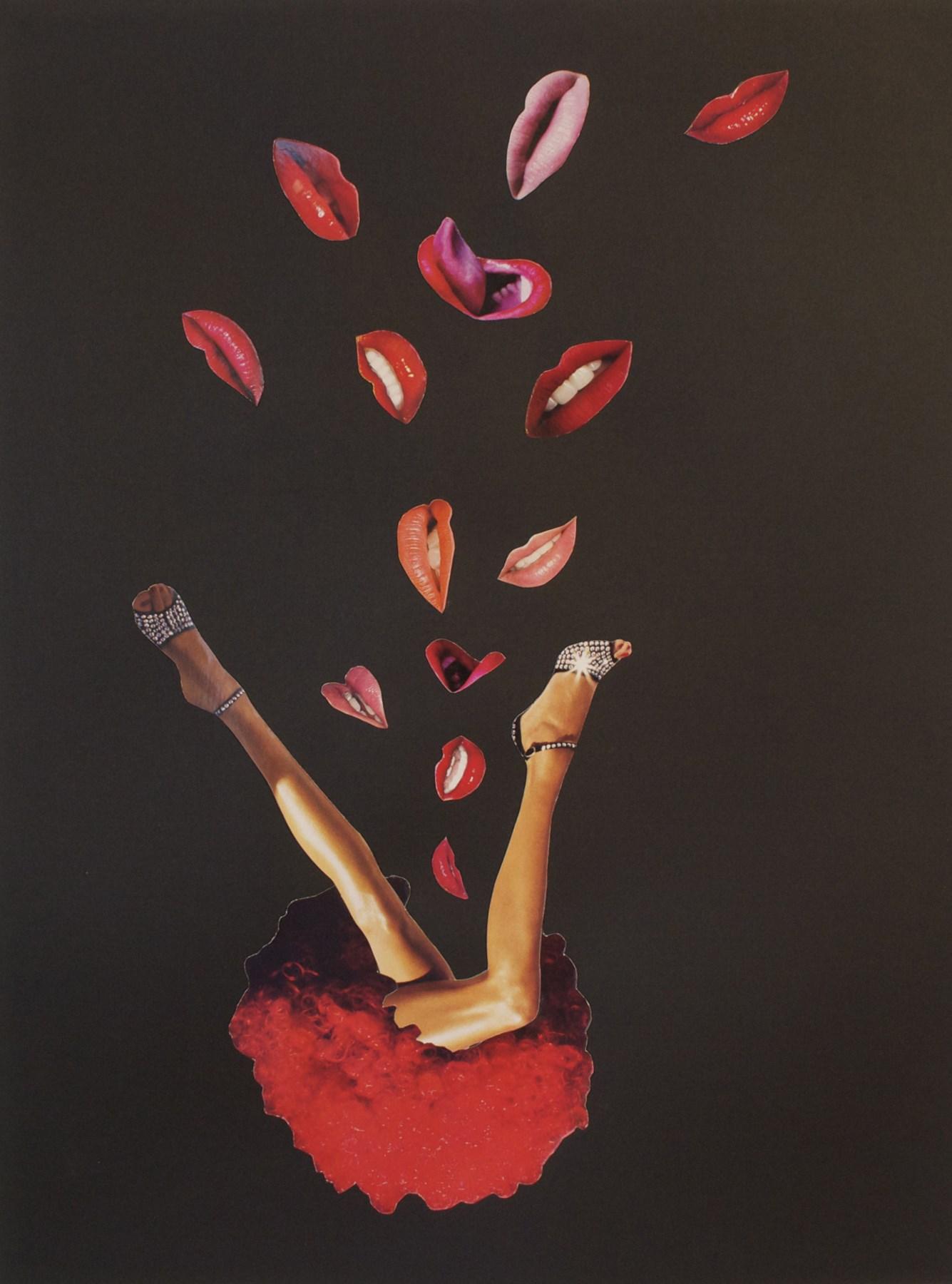
99
Sarah Miska. The Golden Legs. 2011. Paper and adhesive. 17 x 13 x 1.5 inches.
I examine themes of deafness, disability and otherness in my work; expressing artistically what it is to occupy a non-normative body in a culture where normality is narrowly defined. Momentum as impetus can and should effect a shift in perception of these states of being; a shift away from internalizing feelings of inadequacy and self contempt to claiming one’s physical state and refusing to be shamed by it, a shift from art as introspective commentary to art as a militant voice, enabling viewers to find their own relevance.

100
Janet Morrow. Falling/Failing. 2011. Video. 5 minutes 22 seconds.

101
Julie Nauman-Mikulski. Trouble at home 2010. BFK Rives digital archival print. 24 x 24 inches. *

102
Julie Nauman-Mikulski. Nocturne No. 31 (dream) 11.1986. 2010. BFK Rives digital archival print. 20 x 24 inches.
I am an avid note taker and list maker, but these things are rarely put together in one place. Through the process of painting I attempt to make sense of all the collected stories and personal notations. I often pair the female figure with symbols such as play or food; confronting issues of security, restraint and indulgence. The women in my images are often caught in a moment of selfawareness or discovery. With childlike grace, they struggle and triumph over the challenges of relationships and growth.

103
Erika Navarrete Anderson. Tug of War. 2009. Oil on panel. 12 x 15 x 1.5 inches.
The series ‘from my grandmother's blood’ combines the practice of quilting, embroidering, the incorporation of patterns, altered books, photographs and found objects in an investigation of familial relationships, cultural taboos and their place in the formation of identity.

104
Janice Nesser. tied to her apron strings from the series ‘my grandmother’s blood’. 2009. Bromide Gelatin prints, stretcher bars, embroidery thread. 5 x 7 feet.
The Internet and fast travel have made cultural identification more and more porous; society has become more dispersed than ever before. This “momentum” begs several questions moving forward, beginning with a psychosocial exploration into modern living. Graceful Bitch stems from a series examining the polarization of American society. Through language and material, this series explores what we love and despise about divisive people, and ultimately how our feelings toward them reflect our relationship to self and how we want to be seen.

105
Tanya Nolan. Graceful Bitch. 2010. Encaustic on mirror. 12 x 48 inches.
If T-shirts evoke a system in which people are expected to fit themselves into a dominant mold, what do we accomplish by tearing them apart and yet leaving them whole? This visual question, as posed by my work, really asks how we can accomplish change while working with what we already have. The Momentum of the women's movement has demonstrated that some historic attitudes and cultural molds must be destroyed in order to make room for new life. Women continue to define new selves as they emerge and weave together new meanings of culture and community for everyone.

106
Margaret Parker. Kali: she who destroys/regenerates. 2011. 3 cotton T-shirts, wire, filament. 94 x 52 x 42 inches (variable). *
This image is a mixed media collage made from my own drawings and photopolymer intaglio prints. Through the medium of photo printmaking, I can reproduce delicate, ephemeral collage materials, rendering them more permanent. Preservation (The End of Summer) is about the feeling of victory and satisfaction in the completion of a process, the preservation of a harvest, having reached the pinnacle. But upon completion, a new struggle begins. How do we move forward after resolution? Is she victorious, or stuck? This is the illusion and the struggle of completion.

107
Lesley Patterson-Marx. Preservation, The End of Summer. 2009. Photopolymer intaglio, pastel, acrylic ink on Rives BFK. 12 x 9.5 x 1.5 inches.
Jana Perez. Exemplify. 2009-2010. 35mm digital photography. 20 x 30 inches. *
These images are from a series of photographic diptychs titled “Objectify”. The work uses the female body paired with objects to satirize advertised ideas about women, and defines a personal reaction to media manipulation and ideas of restraint and emancipation. In relation to the theme of Momentum, this work relates to both the momentum in which altered images of women emerge in our culture, and the increasingly less transparent ways that technological mediums deliver them.

108
My existence is dependent upon and in response to those I care for and those with whom I interact. My work is an embodiment of the love, conflict, pain, beauty, work and sorrow that fill up our heads and hearts in this complicated world. People occupy emotional, intellectual, and intuitive space. The observations I make of human beings bumbling about are distilled into metaphorical moments where time is halted and people are standing, reaching, looking, walking, falling, or helping.

109
Marcy Pope. Bend & stretch. 2011. Acrylic on mylar, cheesecloth, thread. 55 x 36 inches. *
Nora Raggio.
*
My work engages with the political and environmental momentum of turbulence, augmenting its impact through the use of huge poster-banners. In Re-Evolution I focus on the political strength women’s voices bring to the momentum for change and dynamic evolution through the peaceful acts of presence and protest. This banner shows the activity of women in the Middle East and in South America the red used in the banner is a strong color that aims to “stop” violence and injustice.

110
Re-Evolution. 2011. Mixed digital media printed with archival inks on archival paper. 144 x 40 inches.
I am interested in representing people’s emotional states, psychological depth, and the intensity of the human experience. In the work, this is articulated through an economy of color, light and shadows, and compositional structures that allow me to contemplate psychological tensions, moods, and conundrums, as a means of exploring the essence our shared humanity beyond our differences, in an effort to understand myself and my connectedness to the people, places, and things that constitute my lived experience of the world.

111
Shilo Ratner. Nude by Window. 2011. Acrylic paint, Indian ink on paper. 18 x 14 inches. *

112
Shilo Ratner. Just Relaxing. 2011. Acrylic paint, Indian ink on paper. 18 x 14 inches.
The power of technology and the human mind are creating a new visual world. These images beg for the release of the tremendous energy brought on through change, and manipulation of digital and artistic elements and become a reality driven by an incomprehensible force within the original photographs and drawings. The numerous results unfold an unending, never static visual impetus that present series of new images and express new ideas. ‘Change, Therefore, becomes the impetus for gaining momentum in our lives’.

113
Stephanie Rococha. Gaining Momentum. 2011. Archival pigment print. Edition of 10. 13 x 22 inches.
Enter into Faust’s Study, a trompe l’oeil painted room, and be confronted by a fearless man who is empowered and transformed by the duality of his sexuality. His starkly lit, painted face and figure emerging from the shadows are a provocative contrast to the painted Adam and Eve on the rear wall. Faust’s Study directs the viewer’s attention to the relationship between the interior details and the narrative, as the gender performance artist, Frédéric Koenig, unselfconsciously dares the viewer to cross over boundaries of imagination and desire.

114
Trix Rosen. Faust’s Study. 1997. Archival pigment print. Edition of 9. 24.5 x 26.5 inches. *
This image is part of an ongoing series of portraits that document my fifteen-year collaboration with Frédéric Koenig, who can so naturally appear both handsome and beautiful, both masculine and feminine. Wearing nothing more than spike heels, he provocatively poses in an abandoned brewery, a gritty, industrial environment that reinforces a traditional male landscape. While his upper body exudes a masculine power, his raw and curvaceous physicality and his archetypal pinup girl shoes challenge the viewer to explore how we perceive masculinity, sexuality and gender identity.
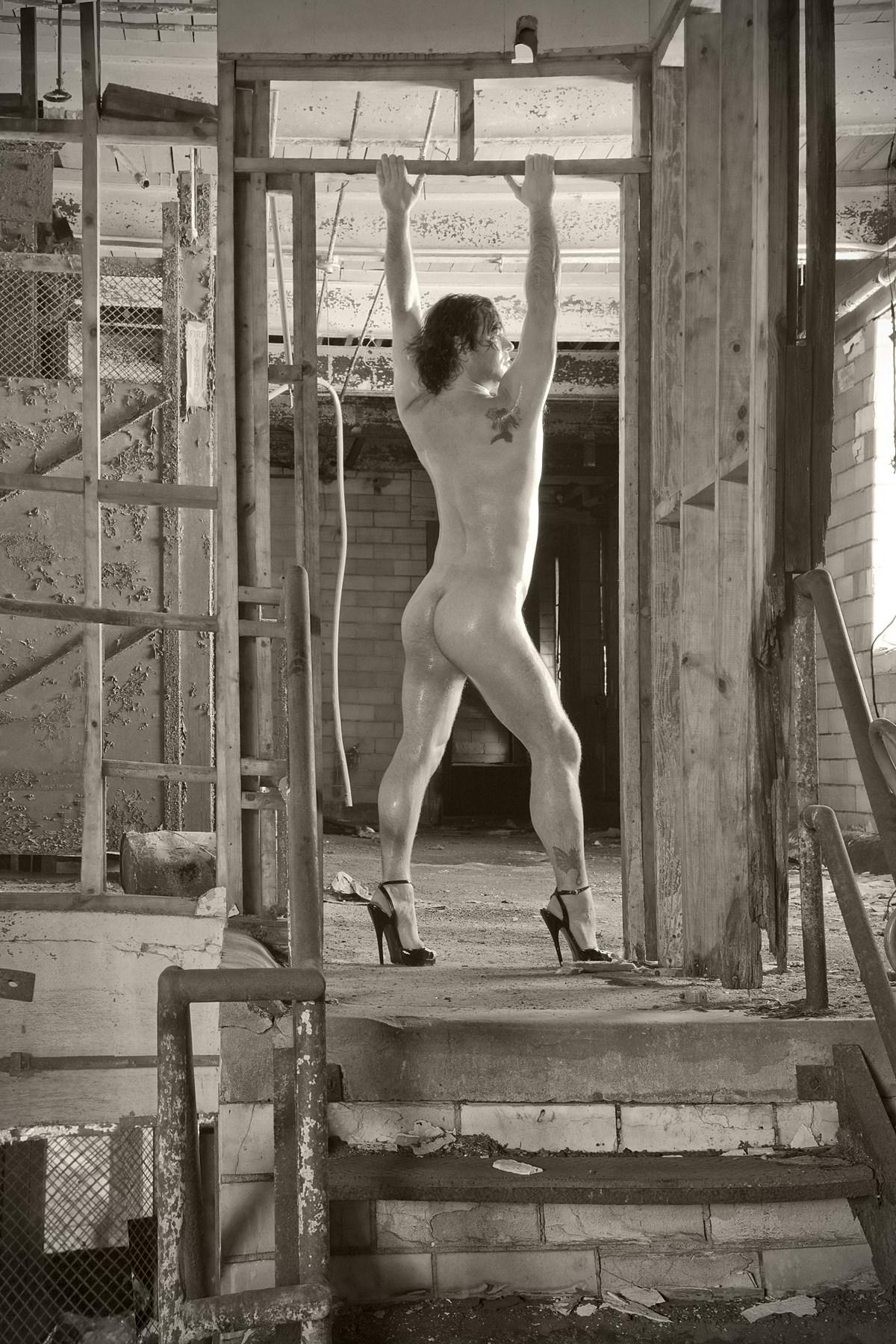
115
Trix Rosen. Beyond XY: Inside the Abandoned Falstaff Brewery. No.2. 2010. Archival pigment print. Edition of 15. 19 x 25 inches. *
Trix Rosen. Objects of Special Devotion. 1985. Archival pigment print. Edition of 9. 24.5 x 26.5 inches.
I’ve explored feminist, LGBTQ and social justice issues over four decades by producing images that depict gender ambiguity and transformation. In the seventies, my studio in downtown New York City was a haven for my female friends to pose dressed up and naked, in leather outfits and swathed in boas, with hand-painted mustaches and masks, amidst barbed wire and tulle. I’ve photographed women’s erotic pleasure, role-playing and butch/femme identity. Objects of Special Devotion depicts a muscular, androgynous bodybuilder who defies conventional female beauty and challenges the sexual, cultural and erotic representation of women.
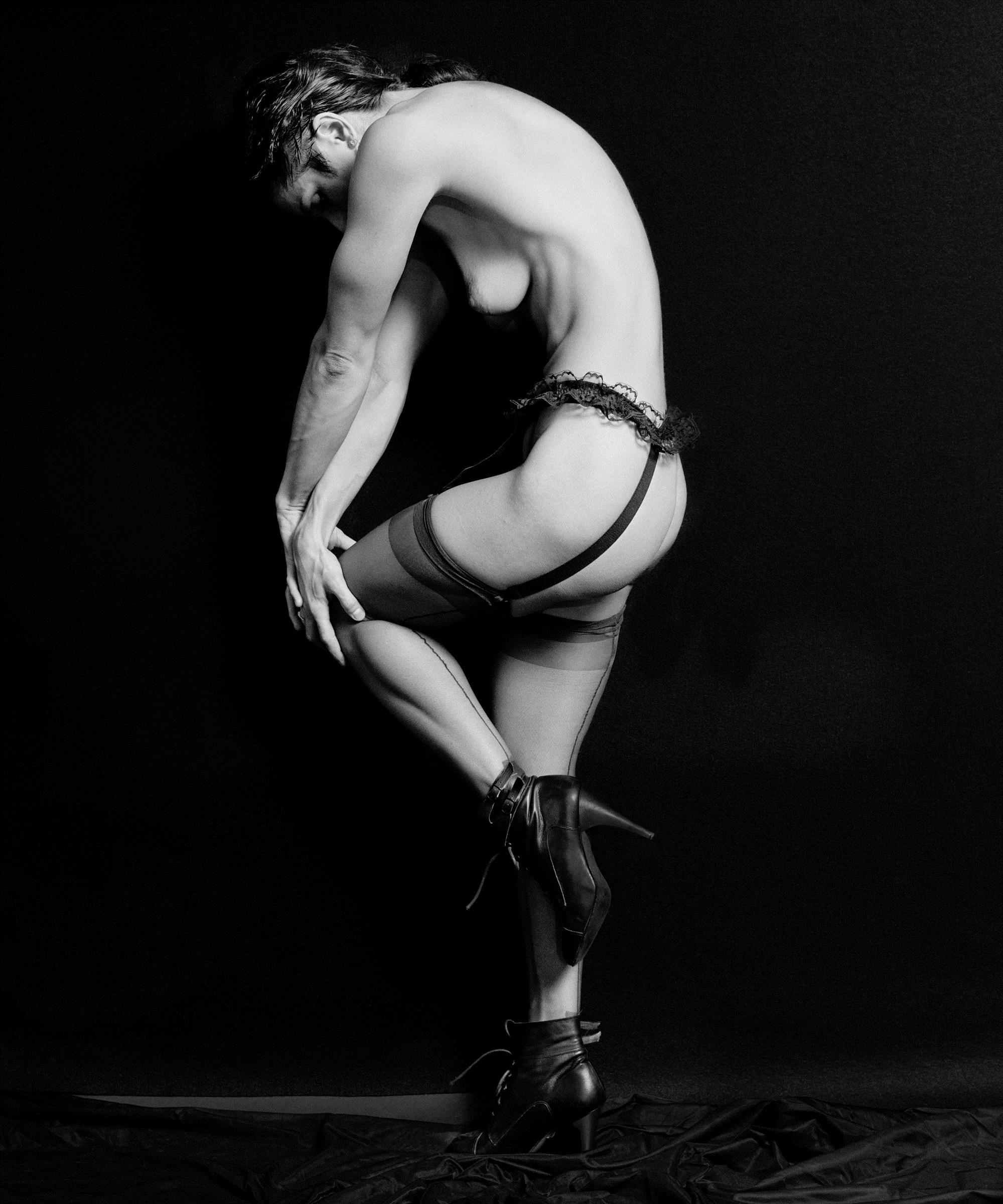
116
The Gracie Kendal Project is a close-up daily view of a personal, social and psychological co-existence with my virtual persona. Using installation, text, photography, mixed media, video and performance, I project myself onto another form and confront my own imperfections. Through documentation, I construct a narrative of self that represents me and is me, one that helps to deconstruct ideas of normalcy and authenticity.

117
Kristine Schomaker. Gracie and the Real Girl. 2010. Digital photography. 30 x 20 inches each.
How does one measure the distance it takes to achieve fortune? How do we measure fortune at all? Is it gaining quantitative abundance or is it our hope for a predetermined future. We collect data, chart it, create boundaries around it, weigh it, measure it, strain to see cause and effect, and turn it into something we can understand in an effort to save ourselves. But even the most comprehensive and precise data remains open to manipulation, limited by our own perspectives, overwhelming and ultimately inscrutable.

118
Jennifer Seibert. How to Rebuild a House 3. 2011. Graphite, digital photo. 16 x 20 inches.
My work is informed by geometry and natural forms. My particular current vision focuses on subconscious associations and exudes a sensuality through line and color. It is a process with a language that continues to evolve. My Fertile Garden celebrates women’s reproductive organs with personal and surreal associations.

119
Dee Shapiro. My Fertile Garden 2011. Ink and Flashe paint on paper. 30 x 22 inches.
The collaged elements in my works are from advertisements of bath towels, shampoo, and swimming pools from vintage men’s magazines. For me, ripping these images into little pieces was reinforcement that past mores of female domesticity are disintegrating, yet still present in our minds’ identity. Overall, the female figures here are in situations of flux and reference universal struggles. In general, as an artist, I am drawn to opposing forces; subject matter gentle and abrasive, clean and dirty, fantastic and real.
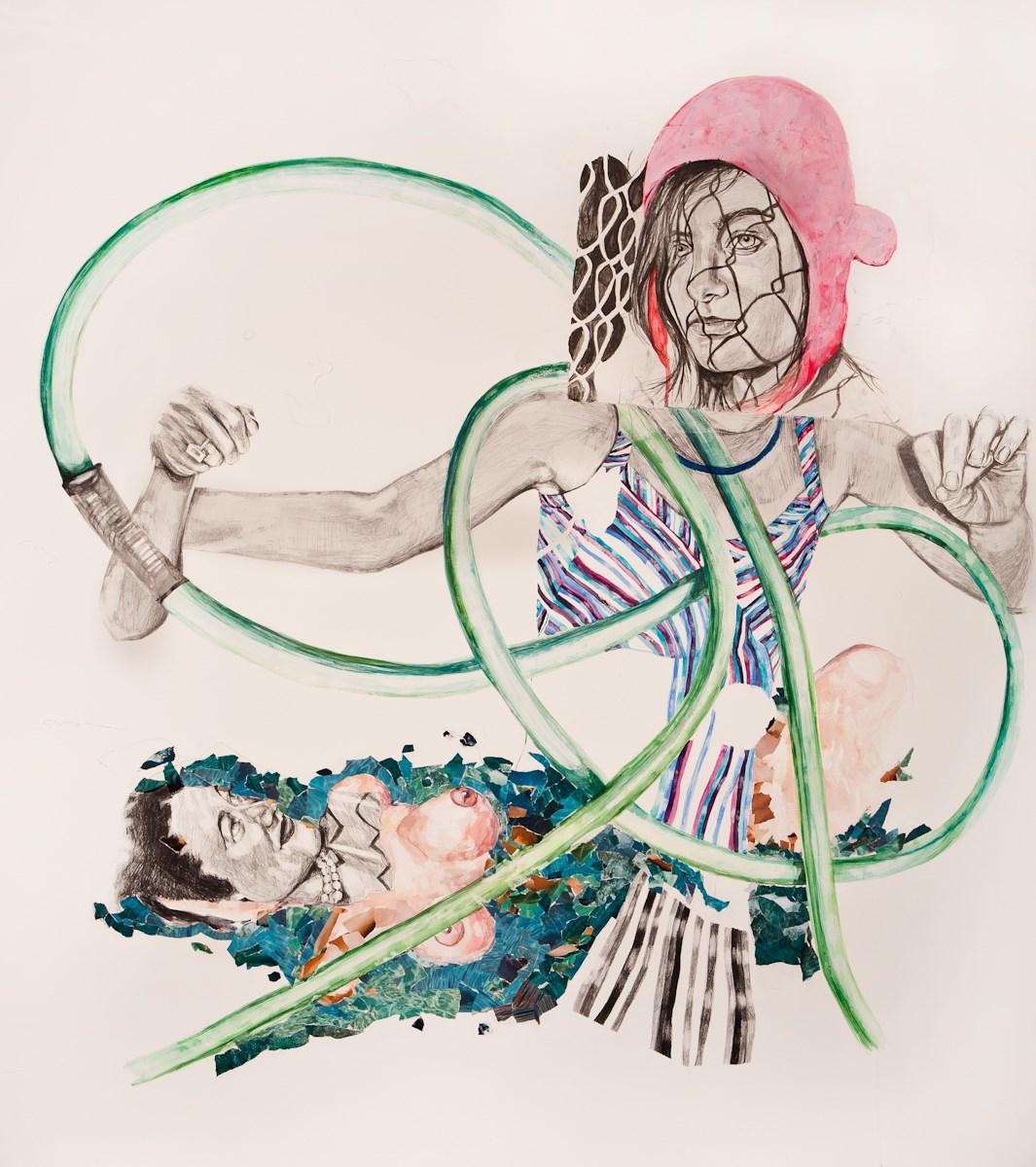
120
Sharon Shapiro. Double Dutch. 2011. Watercolor, acrylic, graphite and collage on paper. 60 x 56 inches.
I like implied narrative in paintings. My roots are in the European painting tradition. This series came from my time in India, awareness and love of my mixed race family is interwoven Confluence Goddess, Distance, incorporating ideas from East and West, inner and outer states of being, ideas about the unseen realm, Somewhere a flute still plays. I am impelled to paint from within myself, although I look at the work of other contemporary artists. My struggle is to carve out the time to be reflective and do the work.

121
Sal Sidner. Confluence Goddess. 2010. Acrylic/oil on canvas. 40 x 50 x 2 inches.
In the context of this exhibit, The Crow’s Call acknowledges the influence of pioneer women artists whose art dared to explore and unveil the complex female universe in a male dominated society. These artists have always inspired me to represent metaphorically fragments of my and other women’s lives. My works are part of a series that explores feelings we usually try to hide, such as fear, sorrow, and grief, and the endless search for balance throughout women’s entire existence.

122
Gabriela Sincich. The Crow’s Call. 2011. Mix media on paper. 15 x 42 inches. *
What to say?
What to say? What can we say? What have we said? We have come a long way!

What to say about the road, long, very long, Tiring, thrilling, exhausting, selfless. Broken promises, broken lives, broken families. What should we say to those who have come before us?
Thank you, much appreciated, grateful and we want You to know we are pushing the cause with Momentum into the future!

123
Bonnie J. Smith. What to say? 2012. Textile, cotton fabrics, ink, water colors, rayon thread, polyester batting, photographs. 30 x 40 inches. *
Elizabeth Snipes. About to say…. 2011. Pastel and oil on canvas. 36 x 30 x 2.5 inches. *
In my figurative work, shifts between multiple painting and drawing languages create tension and discontinuity in otherwise unified figure/ground relationships. The image fluctuates between being recognizable and confusing, familiar and foreign, representational and abstract. The figure/ground relationship becomes broken, fixed, compromised, and challenged. The resulting tensions reflect the complex nature of how a woman can experience the world, herself, her art historical heritage, and others in the 21st Century.
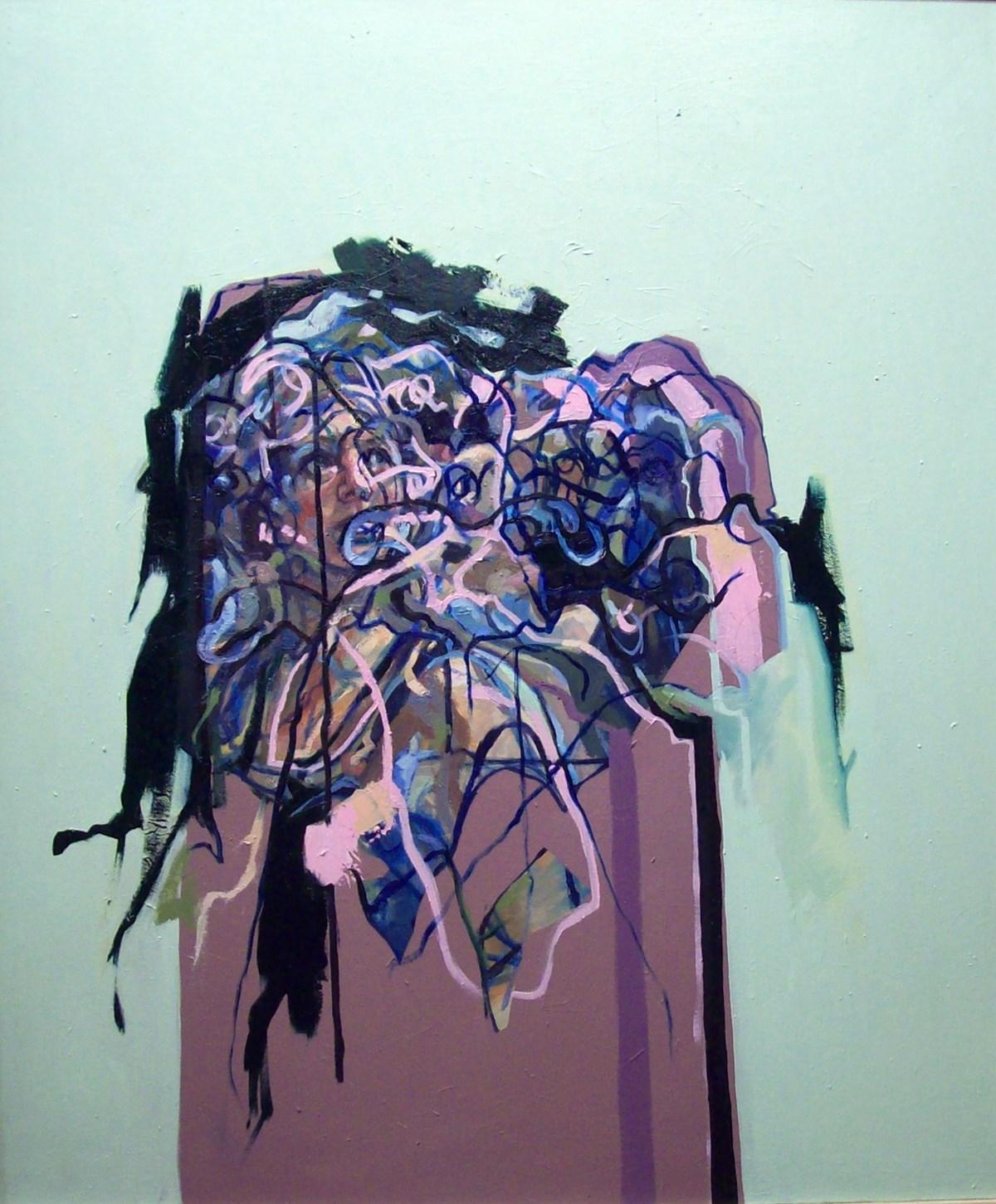
124
In this self portrait, I considered my own self in a state of flux between being present and absent, certain and uncertain, represented and misunderstood. These fluctuations are recorded through shifts between multiple painting and drawing languages, which can create tension and discontinuity in otherwise unified figure/ground relationships. This work represents how I understand interpersonal relationships, as well as the relationships between myself and environments in which I exist as an artist, individual, and a woman.

125
Elizabeth Snipes. Me. 2011. Pastel and oil on canvas . 24 x 24 x 2.5 inches.
My momentum and inspiration as an artist come from remembering family members who are no longer alive. Some I knew, and some I know only through their stories passed down through their photographs. My Jewish heritage and art are intertwined. I use vintage materials: old spindles, locks and keys, lace, burlap, rusted wire, vintage collar, an old broken mezuzah, found objects. Substrates can be Russian book covers, a piece of wood or a discarded box transformed into vintage art. Rifkah’s Box is a tribute to my great grandmother who never came to America and I only know from her photograph. Family memories create my momentum.

126
Reva Solomon. Rifkah’s Box. 2010. Red office box with lid, crackle paint, vintage lace, old key, photo frame, rusted wire. 7 x 7 x 4 inches.
Millee Tibbs. 3-2-83, 2007. 2007. Archival digital prints . 11 x 14 inches . *
In the series This is a picture of me, I use the transgressive space of self-portraiture to upend the canonical power relationship between photographer and subject. The series is meant to question how a woman is supposed to present herself. The reenactment of childish gestures by an adult body transforms the seemingly innocuous poses into suggestive and sexualized performances that emphasize the unconscious influence of mediated images in vernacular photography.

127

128
Millee Tibbs. October 1980, 2007. 2007. Archival digital prints. 11 x 14 inches.
I am interested in objects and materials as products of cultural metamorphosis and in their capacity to construct new meanings. Tension is made with landscape nylon netting and crocheted nylon threat. Tension juxtaposes the industrial pattern from the recycled material with a superimposed hand made crocheted pattern to question issues of time, labor and memory.
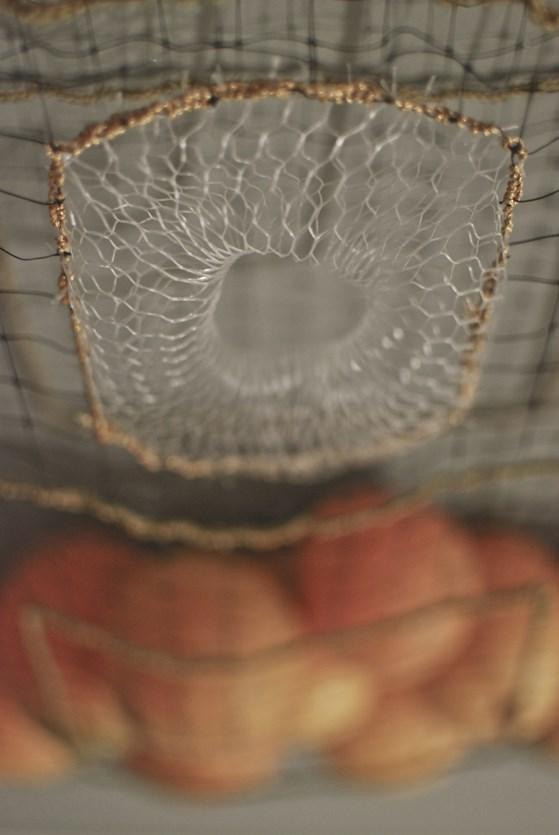

129
Patricia Tinajero. A donde van las naranjas. 2011. Crocheted nylon and oranges. 38 x 70 x 6 inches. *
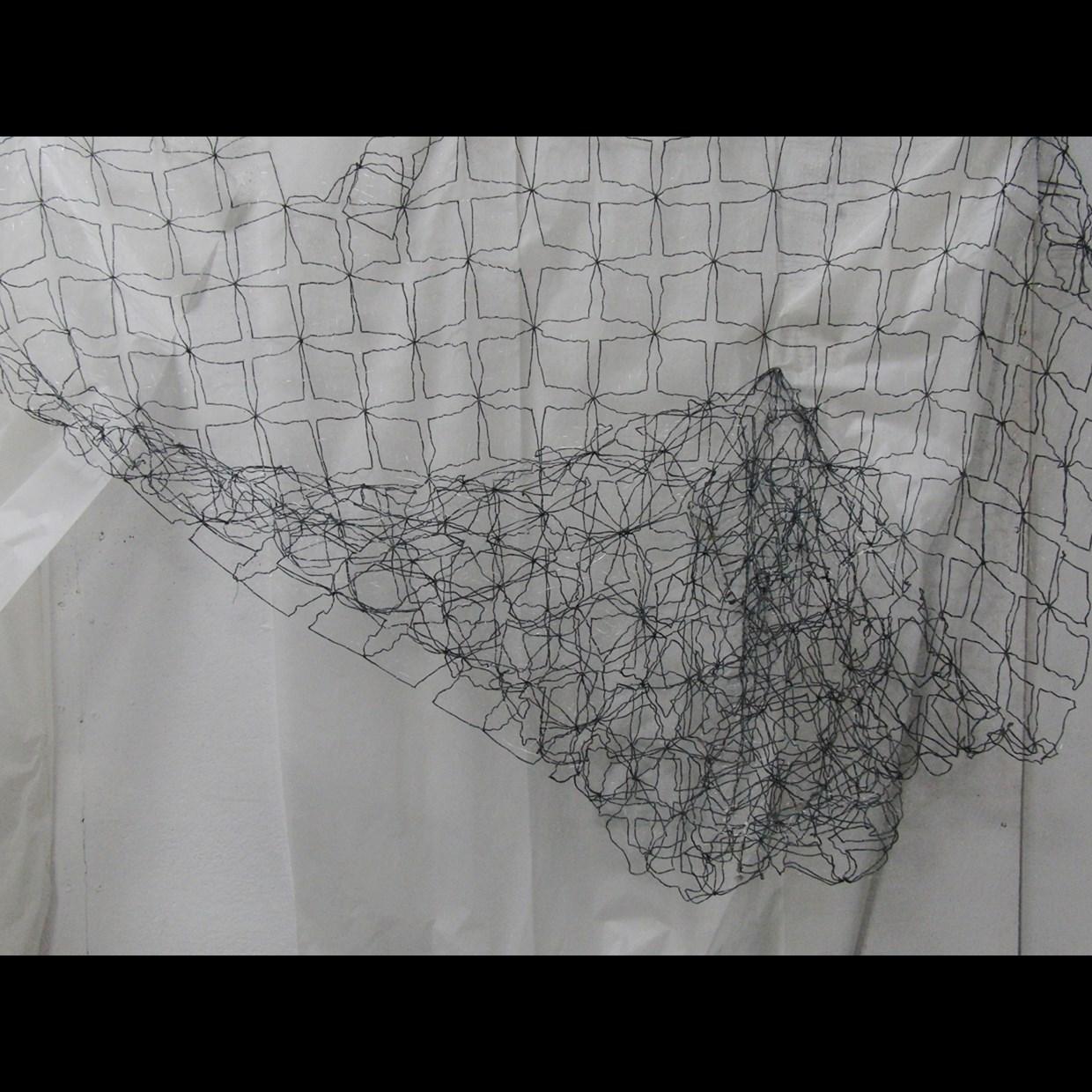
130
Patricia Tinajero. Tension 2010. Nylon. 70 x 68 x 2 inches.
My paintings are based on photographs of historical and contemporary global events. By painting these images I want to convey the feelings of ever changing times whether it is imaging the future or looking back on the past. In Studio Portrait, a woman in 1912 poses wearing a WWI British uniform though it would be many years before women serve in combat. Her mysterious yet confident smile make the viewer wonder about her life and the times.
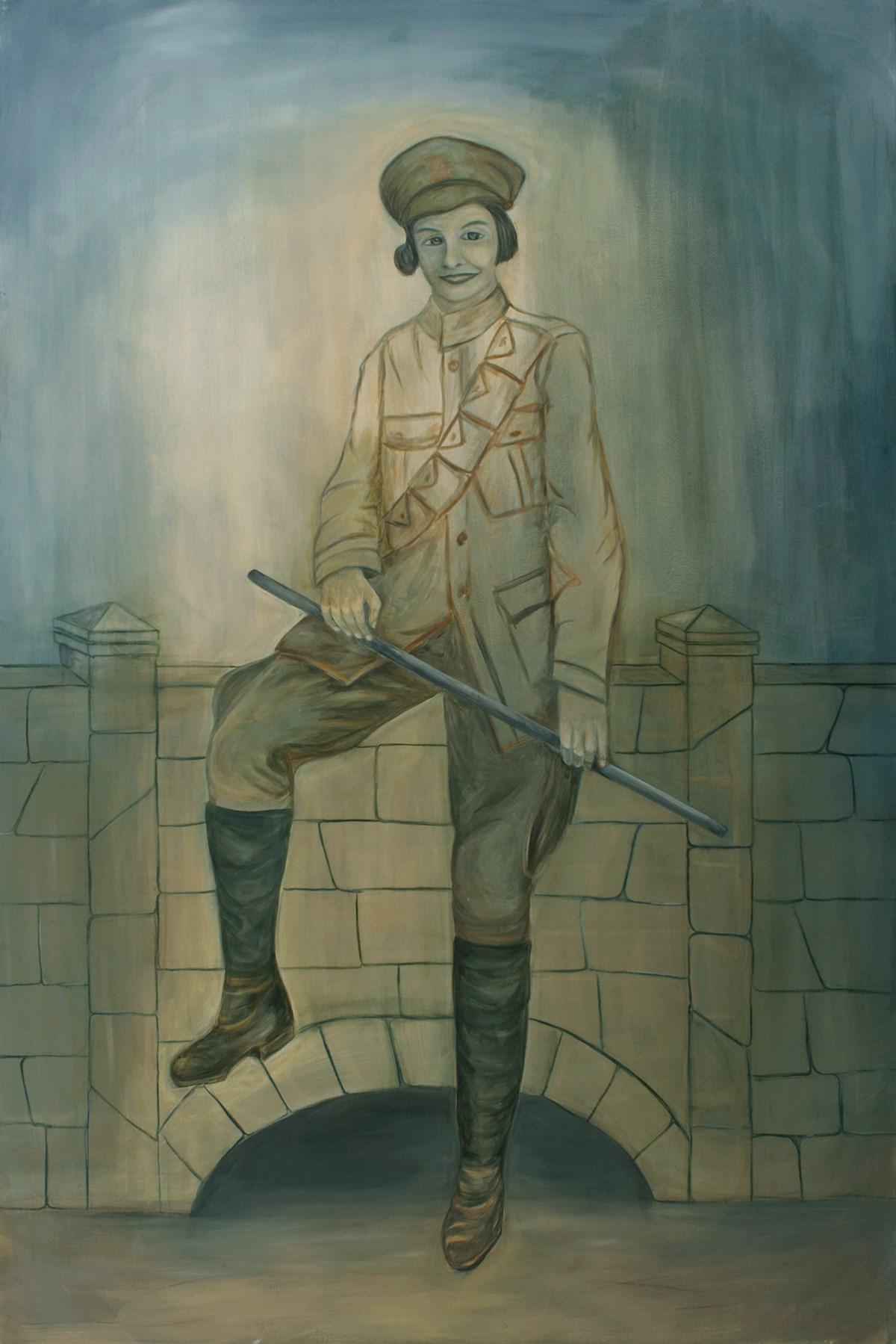
131
Lucy Traeger. Studio Portrait. 2007. Acrylic on canvas. 72 x 48 inches.
Linda Vallejo. Make 'Em All Mexican: The Sun God Tonatiuh. 2011. Plaster, acrylic, gold leaf, and Giclée print of original painting. 22 x 16 x 10 inches. *
Make ‘Em All Mexican turns cultural icon on its head. I use repurposed materials and mixed media to turn cultural and historic icons into images of political satire. I consider Make ‘Em All Mexican to be the quintessential post-modern American statement created by a Latina woman, born of immigrant grandparents, raising educated children, and living the American dream, yet remaining invisible in the larger landscape. Make ‘Em All Mexican has been viewed as hyper-political, as emotional portals, and as a down-right hilarious invention. Make ‘Em All Mexican creates a strange, yet fascinating world that investigates the politics of color in the modern world.

132
Using materials to express Goddess, the spirit within me, I wish to enlighten viewers so that they better understand the spirit within themselves. Color is my way to get attention. An example of this is in I Birthed You! in which the background and some of the objects in the foreground are brightly painted. Once the viewer's attention is drawn, the imagery bombards them, bringing light to the loss in momentum humans have undergone in their search for enlightenment, due to the divisions we have created, i.e. the innate superiority complex.

133
Dionne Victoria. I Birthed You! 2010. Acrylic and fabric on canvas. 18 x 36 inches. *
Once the viewer’s attention is drawn, the imagery bombards them, bringing light to the loss in momentum humans have undergone in their search for enlightenment, due to the divisions we have created, as in At Least We’re Off the Boat. Believing that there is nothing more to obtain because we have simply obtained it all is a thought pattern that we find ourselves lost in. There is so much more we can become but becoming complacent to the abuse we received in the past makes us blind to abuse we allow ourselves to receive today.

134
Dionne Victoria. At Least We’re Off The Boat. 2011. Acrylic, urine, feces, blood, embroidery floss on canvas. 55 x 71 inches.
Photography has always been a method to collect evidence. This seems an appropriate medium for collecting evidence and documenting my aging process. As we age, we lose momentum. I am contemplating personal losses such as: independence, physical abilities, physical power, mental facilities, memory, emotional health, relationships, friends, family, parents, health, eye sight, sexuality, decaying body, dreams, hopes, disappointments.
Currently, I am watching my mother age. Her mind is deteriorating as she grows older. I watch her grasp at memories. I notice how she grows fearful as her self-control slips away. I watch her lose touch with reality, and paranoia sets in. She is imprisoned in her mind without a key. In this work, I am trying to understand how she must feel.

135
Marydorsey Wanless. Paranoia 4. 2011. Metal. 8 x 10 inches.
Momentum suggests the force or speed of movement. Advancement or the struggle to advance, frustration and repetition are the recurring themes of my new work. The piece, Tapestry of Flight, deals with mankind’s struggle to attain flight, a symbol of progress. Liberation Square was inspired by the revolution in Egypt that was given the momentum to succeed by social media.

136
Margi Weir. Liberation Square. 2011. Acrylic, vinyl & resin on panel. 10 x 10 inches. *

137
Margi Weir. Tapestry of Flight. 2007. Digital ink print on rag paper. 16 x 12 inches.
I was inspired to do Collection after purchasing someone’s very large button collection on eBay. I was struck by the fact that they had taken the time to not only sort all of the buttons but also hand -sew them onto heavy white paper. The woman who did this had died; her daughter was the seller. I created a plaster dress form and underneath a layer of dried flowers I added the buttons along with greeting cards. The dress is held tight with twine and encaustic, suggesting the bittersweet nature of our lives.

138
Nancy Youdelman. Collection 2009. Mixed media wall relief with encaustic. 57 x 39 x 4 inches.
My art can be summed up as Confessions of Paper, a way to visually communicate truths. Using found paper and testing various modes of its destruction, my work focuses on the nature of how paper conceals and communicates meaning. In my process, I begin with a piece painted to realistically represent a memory, which I then cover with paper: scraps found, created from pulp, or hand illustrated. I will then peel away the paper, so that I am left with a construction bearing a nonlinear but viscerally personal connection to its origin, the accumulated papers mimicking the debris that sticks to memories. It is a study of revelation through the destruction/use of paper.
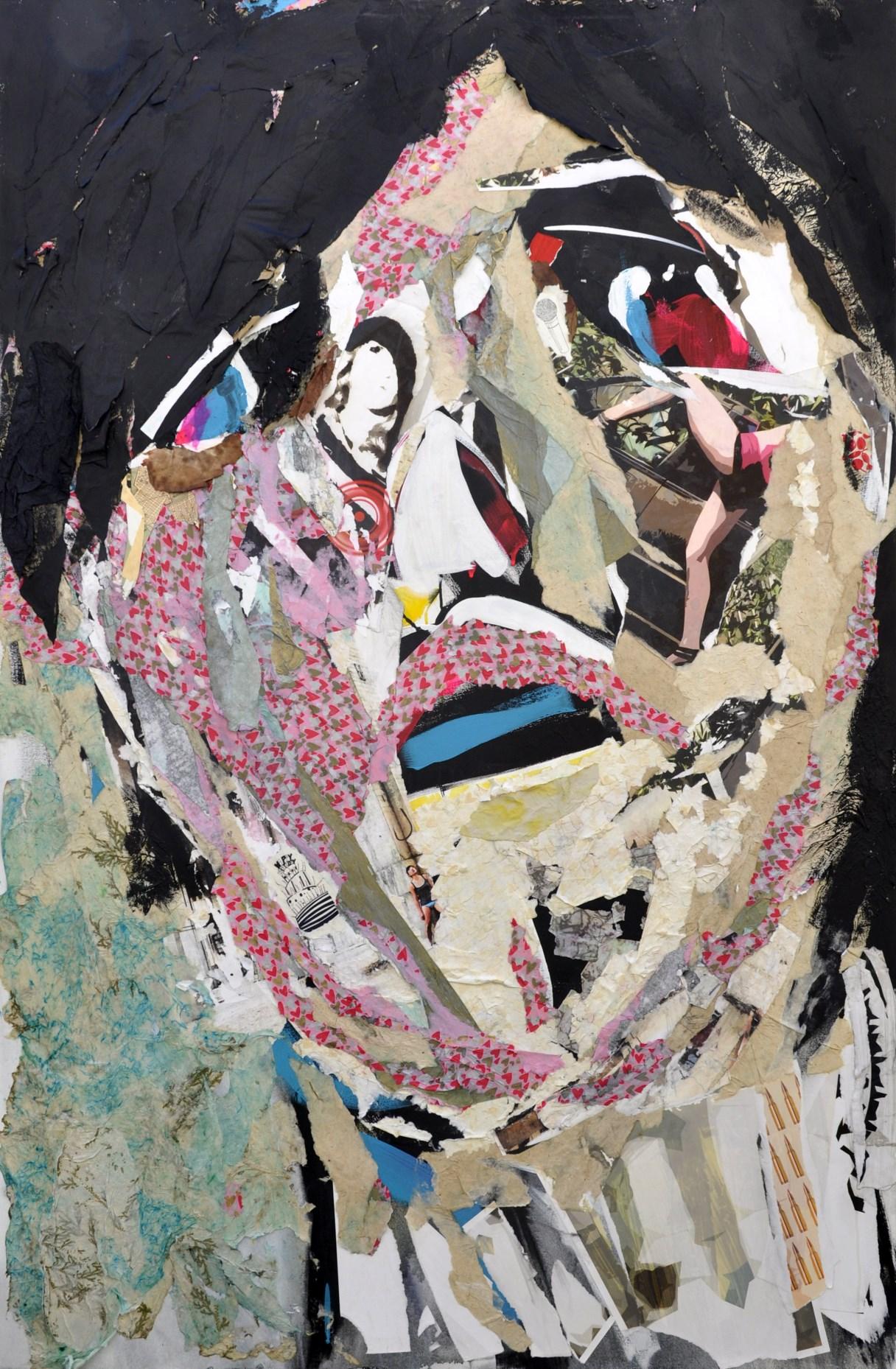
139
Essi Zimm. Mr. Wolf. 2011. Mixed media collage. 40 x 72 inches. *

140
Essi Zimm. Mr. Boy. 2011. Mixed media collage. 48 x 72 inches.

141
Essi Zimm. Mr. Twigs. 2011. Mixed media collage. 42 x 72 inches.
ARTIST DIRECTORY
Nancy Abeles thinkeyedeas@aol.com
Bethesda, Maryland
Robin Adsit www.robinadsit.com
Claremont, California
Zina Al-Shukri www.zinaalshukri.com San Francisco, California
Salma Arastu www.salmaarastu.com Berkeley, California
Joan Arbeiter joan_arbeiter@hotmail.com Metuchen, New Jersey
Bonnie Dubbin Askowitz www.bonnieaskowitz.com Miami, Florida
Amy Boger www.amyboger.com
Concord, Massachusetts
Jodi Bonassi www.jodibonassiart.com
Canoga Park, California
Andrea Borsuk www.andreaborsuk.com
Santa Cruz, California
Tracy Brown www.tracybrownart.com
Tucson, Arizona
Andrea Broyles www.andreabroyles.com
Santa Fe, New Mexico
Barbara Bruch www.tarotofcosmicconsciousness.blogspot.com
Seattle, Washington
Donna Catanzaro www.donnacat.com
Windham, New Hampshire
Ching Ching Cheng www.chingchingcheng.com
Altadena, California
Elise Cheval www.elisecheval.blogspot.com San Anselmo, California
Michele Colburn www.michelecolburnart.artspan.com Washington, Dist of Columbia
Judy Cooper cooperjudyj@yahoo.com New Orleans, Lousianna
Linda Rae Coughlin www.theartrugs.com Warren, New Jersey
Joyce Cutler-Shaw www.joycecutlershaw.com San Diego, California
Gina Dabrowski www.ginadabrowski.com St. Paul, Minnesota
Mary Lou Dauray www.maryloudauray.com
Sausalito, California
Michelle de la Vega www.michelledelavega.com
Seattle, Washington
Cat Del Buono www.catdelbuono.com
Brooklyn, New York
Eleanor Dickinson
www.eleanordickinson.wordpress.com San Francisco, California
142
Pamela Dodds www.pameladodds.net
Alice Dubiel www.planetart.us
Seattle, Washington
Merrilyn Duzy www.merrilynduzy.com West Hills, California
Tracy Featherstone www.tracyfeatherstone.com Hamilton, Ohio
Trish Foschi www.trishfoschi.com
Santa Fe, New Mexico
Marie Fox www.mariefoxpaintingaday.blogspot.com Pacific Palisades, California
Judy Gelles www.judygelles.com
Philadelphia, Pennsylvania
Gina Genis www.ginagenis.photoshelter.com
Laguna Woods, California
Ashley Gibbons www.missashleygibbons.com
Los Angeles, California
Susan C Gregory www.susancgregory.blogspot.com Charleston, South Carolina
C.J. Grossman www.ArtJazzBooks.com Richmond, California
Anitra Haendel www.anitrahaendel.com
Valencia, California
Kate Hampel www.katehampel.com
Chicago, Illinois
Emanuela Harris-Sintamarian www.emahsin.com
San Jose, California
Paula Henderson www.paulahendersonart.com
Chicago, Illinois
Barbara Horiuchi
www.artslant.comglobal/artists/show/97652barbara-horiuchi
Saratoga, California
Stacy Isenbarger www.stacyisenbarger.com Moscow, Idaho
Rachael Jablo www.rjablo.com San Francisco, California
Judy Johnson-Williams www.judyjohnson-williams.com Oakland, California
Dorian Katz www.doriankatz.net oakland, California
Joanna Kidd www.JoannaKidd.com Davis, California
Sandra Klein www.sandrakleinportfolio.com Los Angeles, California
Wendy Kveck www.wendykveck.com Las Vegas, Nevada
Olga Lah olgalah@gmail.com Long Beach, California
Beth Lakamp bettsvando@yahoo.com Fenton, Missouri
Joan Laughlin www.joanmlaughlin.com Houston, Texas
143
Pat Lay www.patlay.com
Jersey City, New Jersey
Leanne Lee www.leannejanlee.com Glendale, California
Lynn Letterman www.lynnelliottletterman.com Los Gatos, California
Carol Lynn Levine www.carollynnlevine.com Chester, New Jersey
J. J. L'Heureux www.jjlheureux.com Venice, California
Jacalyn Lopez Garcia www.artelunasol.com Moreno Valley, California
Marilyn Lowey www.MarilynLowey.com
Los Angeles, California
Li Ma www.malimalimali.com
San Francisco, California
Mary Corey March www.marymarch.comIdentity_Tapestry.html
San Francisco, California
KAREN MATHEWS kmathews@tbbs.net Toledo, Ohio
Chanel Matsunami Govreau www.queengidrea.com Evanston, Illinois
Dorothy McGuinness www.flickr.comphotos/dmcguinness Everett, Washington
Katherine McGuire www.KatieMcGuire.com
Los Angeles, California
Rosemary Meza-DesPlas www.rosemarymeza.com Dallas, Texas
Sarah Miska sarahmiska@gmail.com Pasadena, California
Janet Morrow www.defcakelady.com Bedford, Texas
Julie Nauman-Mikulski jnmdesign@aol.com Homewood, Illinois
Erika Navarrete Anderson www.erikacnavarrete.com Portland, Oregon
Janice Nesser www.janicenesser.com St. Louis, Missouri
Tanya Nolan www.tmnfineart.com West Hollywood, California
Margaret Parker www.margaretparkerstudio.com Ann Arbor, Michigan
Lesley Patterson-Marx www.lesleypattersonmarx.com Nashville, Tennessee
Jana Perez www.janacperez.com Plano, Texas
Marcy Pope marcyp1@comcast.net Francestown, New Hampshire
Nora Raggio nora_gen@yahoo.com Palo Alto, California
Shilo Ratner www.shiloratner.com Pacifica, California
144
Stephanie Rococha www.myfavoriteprint.com
Roseville, California
Trix Rosen www.trixrosenArtphotography.com Jersey City, New Jersey
Kristine Schomaker www.kristineschomaker.net Northridge, California
Jennifer Seibert www.jenniferseibert.com Ann Arbor, Michigan
Dee Shapiro www.deeshapiro.com
Great Neck, New York
Sharon Shapiro www.sharonshapiro.com Louisa, Virginia
Sal Sidner www.salsidner.com
Miami, Florida
Gabriela Sincich www.gsincich.com
West Lafayette, Indiana
Bonnie J. Smith www.bonniejofiberarts.com San Jose, California
Elizabeth Snipes www.elizabethsnipes.com Greenwood, South Carolina
Reva Solomon www.CreativeRebelGal.blogspot.com Los Angeles, California
Millee Tibbs www.milleetibbs.com Detroit, Michigan
Patricia Tinajero www.patriciatinajerostudio.com Knoxville, Tennessee
Lucy Traeger www.lucytraeger@yahoo.com Palo Alto, California
Linda Vallejo www.lindavallejo.com Topanga, California
Dionne Victoria www.dionnemilton.wordpress.com Harvey, Illinois
Marydorsey Wanless www.marydorseywanless.com Topeka, Kansas
Margi Weir margiweir@aol.com Detroit, Michigan
Nancy Youdelman www.nancyyoudelman Clovis, California
Essi Zimm www.essizimm.com Culver City, California
145
Los Angeles Art Association (LAAA) is a 501(c)(3) nonprofit organization whose mission is to provide opportunities, resources, services and exhibition venues for emerging Los Angeles artists of all media. LAAA began as a civic art institution in the 1920s, connecting elite art interests to Hollywood collectors, emerging after World War II as the center of Los Angeles modernism and finally becoming the city’s nexus for emerging artists of all media. LAAA serves as a dynamic force for contemporary ideas, outreach, and community.


Representing:

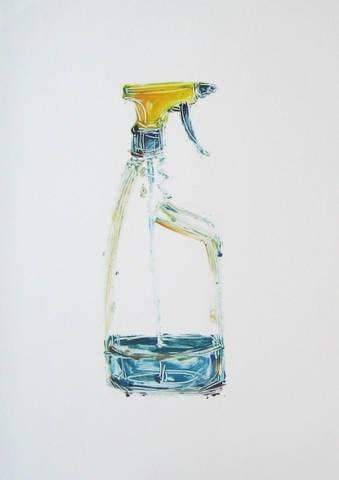

146
Kelly Berg
Valerie Wilcox
Susan Bolles
Lori Pond
Joella March
EXHIBITION COMMITTEE
Karen Gutfreund – WCA Exhibition Director

Trudi Chamoff Hauptman
Rozanne Hermelyn
Niku Kashef
Sandra Mueller
Priscilla Otani
WCA 2010-12 Board
Executive Committee
President –Janice Nesser-Chu, Professor, Director of the Galleries & Perm. Collection, Florissant Valley College, St. Louis, MO
President-Elect -Priscilla Otani, Artist, Partner - Arc Studios & Gallery, San Francisco, CA
Treasurer/Secretary- Margaret Lutze, Adjunct Faculty, Northwestern, DePaul, and Loyola Universities, Chicago, IL
Second VP– Karen Gutfreund, Curator, Artist, Art Consultant - Karen Gutfreund Art, San Jose, CA
VP of Development - Avinger Nelson, Artist, Los Angeles, CA
VP for Chapter Relations - Ulla Barr, Artist, San Clemente, CA
VP for Organizational Outreach - Sandra Mueller, Founder, Zest Collaborations; Community Artist, A Window Between Worlds, Venice, CA
VP Special Events - Holly Dodge, Contracts/Grants Manager, Academy for Educational Development, Washington, DC
Past President - Marilyn J. Hayes, Painter & Printmaker, Ret. Sr. Prog. Analyst, US EEOC, Arlington, VA
Advisor - Barbara Wolanin, Curator for the Architect of the Capitol, Bethesda
Staff
Director of Operations - Karin Luner, Artist, Gallery Director, Dietzspace, NYC
147
